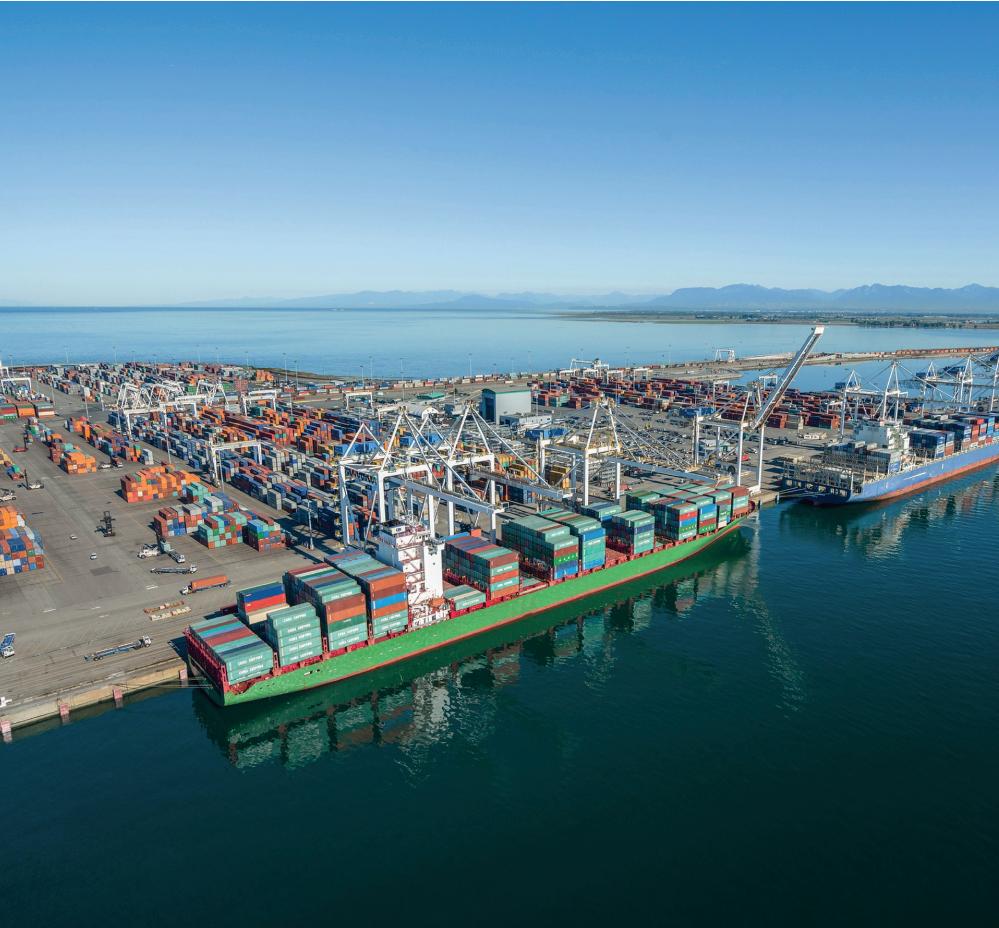Conference






















Dear delegate,
On behalf of Mercator Media Ltd and GreenPort Magazine I would like to welcome you to Bruges for the 17th GreenPort Congress and the 9th GreenPort Cruise Conference. This year’s hosts, The Port of Antwerp-Bruges, are striving towards a leading position as an import hub for green hydrogen and will play an active and pioneering role in the hydrogen economy in addition to exploring methods of applying CCUS (Carbon Capture, Utilisation & Storage).
The host port Antwerp-Bruges is the global leading port for import and export of new vehicles through its Zeebrugge operation. Zebrugge port also co-ordinates nearly 400,000 cruise passengers from 150 ships to Bruges each year. The port of Antwerp is the second biggest shipping port in Europe annually handling more than 240 million tons of freight. On this year’s programme, we are delighted to have so many industry experts, senior port officials, policy advisors and senior environmental officers speaking from across Europe and Australia, as well as representation from leading cruise operators, the European Sea Ports Organisation, and the International Association of Ports and Harbors. The Congress & Cruise elements of GreenPort continue to be fully integrated this year and participants will benefit from parallel Congress & Cruise streams during day one of the conference. The maximised discussion and networking opportunities continue in the interactive working group which will discuss ‘achieving and demonstrating Sustainable Development in the port sector’. Participants at this year’s GreenPort Congress & Cruise will gain a wealth of knowledge from the joint opening and closing sessions which will discuss both Fuel & energy provision for shipping & cruising and Powering ships in port - On-shore power supply panel discussion.
We would like to take this opportunity to thank the Port of Antwerp-Bruges for hosting this year’s event and organising the Welcome Reception, Conference Dinner and Port Tour which provide delegates with unparalleled networking opportunities and a chance to see some of the projects covered in the programme in action within the port. We would also like to thank all our sponsors for sponsoring this year’s event as well as all our supporters and participants for attending. A special thanks comes from Mercator Media to our speakers who make our conferences unique and provide valued content throughout the event. We hope you will find the event beneficial and please put next year’s dates in your diaries. Our European Conference will be held in October 2023, and the host port will be announced at the conclusion of this year’s conference.

Dear delegate,
It is a great pleasure to welcome you in Belgium this year and a great honor for Port of AntwerpBruges to host the 17th edition of GreenPort Cruise & Congress.
Port of Antwerp-Bruges is more than a port and is about more than transportation, tons and TEUs. As one of Europe’s most important ports, we have an essential social role to play: we are a port that is made up of people, for people. We also intend to become the first port in the world to reconcile people, climate and economy.
Therefore Port of Antwerp-Bruges is transitioning to become an active community builder, and is becoming the ‘glue’ that forms the binding factor within ambitious sustainability projects starting out from Antwerp and Bruges that have the potential to become international trailblazers. Our ultimate goal? To become Europe’s green energy gateway.
This is why we are working on pioneering flagship projects focusing on carbon capture and storage (CCS), the circular economy, alternative marine fuels and green hydrogen, the energy of the future. Green hydrogen, produced with renewable energy, is set to play a decisive role in the energy transition. We want to become the European hub for imports of green hydrogen and an active frontrunner in the hydrogen economy.
Port of Antwerp-Bruges is home to Europe’s largest chemicals cluster in Antwerp, while Bruges is an important LNG port and has access to offshore wind farms. Thanks to the complementarity of the two port platforms, Port of Antwerp-Bruges is stronger and the most effective answer to the challenges of today and tomorrow. It presents the perfect opportunity to build on the rich experience we have gained in the past to ensure our long-term future. And to fulfil our role not only as a key economic player, but also as a key driver of Belgium’s energy transition.
We are looking forward to welcoming you to a fruitful congress with productive exchanges and an enjoyable stay in Bruges.
Best regards
JACQUES VANDERMEIREN CEO, Port of Antwerp-Bruges
“We intend to become the first port in the world to reconcile people, climate and economy.”
Opening & Keynote Addresses
Session
Fuel & energy provision
Session 2 - Cruise Stream
What’s next for the cruise industry
taking a look at the latest in sustainable cruise ships
Session 2 - Congress Stream
Green Corridors - A pathway to net zero
3 - Cruise Stream
cruise projects in aid of being carbon
3 - Congress Stream
Partnerships
Powering ports - On-shore
by 2050
Opening
Keynote
- How ports can monitor
Ports/Terminals:
to Clean Fuels
The key Steps
Ports and AI - How digitalisation can be used for further improvement
Working Group – How to get ready for regulatory changes
Sustainability - What does it mean?
With Kalmar Hybrid Straddle Carriers.
Kalmar Hybrid Straddle Carriers can cut your fuel consumption and emissions by up to 40% as they use an eco-efficient regenerative energy system. This system captures the energy produced through deceleration and spreader lowering and stores the energy in Li-ion batteries, which work in tandem with an efficient and compact diesel unit to power your crane. Kalmar Hybrid Straddle Carriers are eco-efficient and ready for an automated future. Kalmar, making your every move count.

Chris has worked on Research & Development and Training with the port sector since 1982 specializing in the environmental management of port and shipping operations. He contrib uted to the development of the EcoPorts tools and methodologies, and is active in their im plementation internationally supported by the cooperation between ECOSLC (www.ecoslc. eu), the European Sea ports Organization (ESPO, www.espo.be) and the American Association of Port Authorities (www.aapa-ports.org). He acts as Reviewer of the EcoPorts’ Self-Diagnosis Methodology (SDM).
His training qualifications include qualified certification through the Course Developers Work shop under the UN Train-Sea-Coast Programme, and the LRQA Environmental Management Systems Auditor Training Course, Lloyd’s Register Quality Assurance training Services, which are certified by the International Register of Certificated Auditors (IRCA).
Chris has delivered training courses on a range of environmental issues throughout Europe and in India, Ivory Coast of Africa, Vietnam, Cambodia, Thailand, Laos, Taiwan, Malaysia and Colombia. He was Director of Studies, Marine Geography in the School of Earth and Ocean Sciences, Cardiff University, UK until 2011.
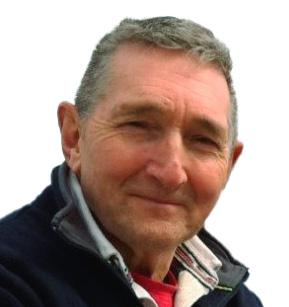
DR CHRISTOPHER WOOLDRIDGE Science Coordinator EcoPorts EcoSLC, and Visiting Research Fellow, Cardiff University, UK
Rik Goetinck has been General Director Policy & Strategy at Port of Zeebrugge (MBZ) (currently Port of Antwerp-Bruges) since 1st of February 2012. From 16th of December 2019 to 30th of September 2020 he was CEO ad interim at MBZ and Chairman of the Executive Committee. This was pending the appointment of a new CEO.

Apart from handling and following up his own files, his task within Port of Antwerp- Bruges consists largely of supporting the three-member executive committee (CEO, COO, CCO) in various strategically important areas.
Rik Goetinck (°26/10/1954) graduated in 1979 from the Ghent University as civil engineer with high distinction and was laureate of the exam for bridges and roads engineer. In his career, he has been involved in major (hydraulic) construction projects. As a mandated member of the Ministry of Public Works, he was in charge of the construction of the Berendrecht lock in Antwerp, the largest lock in the world at the time.
Together with colleagues from the City of Kortrijk (Stad Kortrijk) and Intercommunale Leiedal, he designed the framework for the project of the Leie Gateway in Kortrijk, which is currently one of the most important attractions of the city and used by urban planners and urbanists far beyond its borders as an example of how things can be done. Rik Goetinck systematically progressed to positions at management level, finally becoming the general director of the Ministery of Public Works (position just below secretary-general).
At the Ministery of Public Works, he evolved from civil engineer to general policy support (including port strategy).
Through port-related assignments such as the negotiation of the Scheldt treaties (including the latest deepening of the Scheldt), he came into contact with Joachim Coens, CEO of MBZ (Port of Zeebrugge), who positioned Rik Goetinck as General Director at MBZ in 2012.
Secretary General of the European Sea Ports Organisation (ESPO) since 1/08/2013. Before taking up this function, Isabelle has been working as Director of the European Federation of Inland Ports (EFIP) and Senior Advisor of ESPO for four years.
She studied Law (University of Namur and KULeuven) and European Law (UCL Louvain). Before joining EFIP, she worked in EU Public Affairs for almost 20 years. After a short period at the European Commission (DG Agriculture), she worked in an EU Public Affairs consultancy. In 1994 she started working in the European Parliament, as a political assistant and between 1999 and 2009 she was the political assistant of Dirk Sterckx, where she was mainly active in transport and port-related fields. She is co-author of the handbook “Zo Werkt Europa” (1st edition 2007, 2nd edition 2010, 3rd edition 2015).

Head of Fuel Transition & Infrastructure, A.P. Moller - Maersk
Capt Sameer Bhatnagar is employed in Maersk since 2013 and is part of Maersk’s Decarbonization team. He has extensive Operational experience in Inland & Marine Operations as well as Bunker Operations and Vessel performance. He is passionate about the environment and is active in various charitable endeavours such as Animal Welfare NGOs and the Red Cross.

Decarbonization requires commitment from all stakeholders across the Maritime Logistics value chain to address its unique challenges. It requires more collaboration and a proactive approach to ensure readiness to be able to procure and supply Future fuels. This session will talk about the challenges faced in Decarbonizing shipping from an Owner/Operator’s perspective.


Head of Environmental Policy, Naturschutzbund Deutschland (NABU / Nature and Biodiversity Conservation Union)
Malte Siegert studied politics and philosophy in Hamburg and joined NABU (Nature and Biodi versity Conservation Union), Germany’s largest environmental organization, in 2003. For many years he has been head of environmental policy at the federal NABU office in Hamburg, where he mainly dealt with national and international port related issues as well as infrastructural projects and spatial planning. Since September 2020 Malte Siegert is Chairman of the federal NABU section Hamburg.
Energy supply in accordance with the goals of the Paris Agreement is a major challenge for the shipping sector. Nevertheless, first ship owners take responsibility, commit themselves and set ambitious targets even though many variables are unknown: there is still no agreement on one fuel to focus on as different energy carriers such as e-methanol, e-ammonia, e-methane or direct use of e-hydrogen each offer individual advantages and challenges. It is also still unclear whether enough ’green’ hydrogen as a starting material can be produced using renewable and non-nuclear energy and will be both available and affordable soon as there is still a serious undersupply of ‘green’ Hydrogen now. This is not only a challenge but also an opportunity, especially for ports in beneficial regions and with sufficient space to build up production capacity.
Even the definition and perception of what a ’green’ fuel is or should be is not finally made. Currently, some people in politics and economy are still of the opinion that liquefied natural gas (fossil LNG) or ’bio-fuels’ might still be sustainable solutions for a fossil free future – a position not in accordance with sustainable shipping. On basis of current studies and taking a clear environmental point of view, Germany’s biggest environmental NGO NABU will present an overview of the challenges and chances of ’green’ fuels. Considering the need to fulfil the necessary substantial emission decrease to fulfil the Paris goals we will take a look into the future as to which scenario might be the most probable one and which energy providers can play a significant role in sustainable shipping.
Green house gas emissions of shipping must reach zero until 2050. There are solutions available to achieve this fundamentally necessary goal to deliver the industries fair share to keep climate risk in bay. However, it still lags security about technical pass way and availability of the respectively required fuel. However, ports, energy and infrastructure supplier and not at least regulatory bodies and policy maker have to put together plans today.
NABU considers e-fuels combined with higher efficiency to be the major way to decarbonize deep sea shipping, while short distances can be covered from electricity. Next space requirements, handling and a low primary energy input - from ecological perspective - it is of utmost importance to have a look on ecotoxicological and other negative trad offs (see Table 1). Therefore, NABU commissioned a study in which the most promising fuels were compared. Ammonia turned out to be beneficial for climate but only if nitrous oxide and nitrogen dioxide emission can be controlled to minimum levels. Moreover, very high safety standards must be implemented to avoid spills.
fuel
While international regulation whether in China, EU or Americas is slowly gaining ground towards climate protection the IMOs frameworks are still in negotiation processes and will come to late to meet the 1.5C° mark. In the absence of global regulation next to regional block or national regulation there are seen more and more initiatives by industry in cooperation with ports and cities. Regional governments and companies both from shipping and international consumer brands hope voluntary measures can help to introduce zero-carbon technologies. Green corridors are one of the more comprehensive pillars in this regard. At COP 27 in Glasgow the so-called Clydebank Declaration was signed. Ports in pairs or groups shal be equipped with the required fuelling infrastructure to supply vessels on a green corridor. The first pair that followed the announcement were LA/Long Beach and Shanghai shortly followed by US and EU Atlantic and Baltic Ports. Now regional authorities and private industry took responsibility to drive forward global transition to climate friendly fuelling of the global merchant fleet. Moreover multiple Ports announced to become energy hubs of the future. Thus its not only a risk taking and altruistic effort of cause there is a huge business opportunity for the ports. They can benefit on many levels obviously they can be trading hubs for fuels but moreover they can become incorporated in production or processing of fuels on a much broader basis than in traditional refining. The fuels of the future are based on renewable electricity; thus the production can be localized in the ports or nearby. Moreover the ports e.g. via Shore Side Electricity can become energy traders themselves. Undisputed the transition will need huge investments, but the pay back rate promises to get even bigger. Ports that are at the forefront of this development take a certain risk but they will get the lion share of initial public funding and will be the first ones to supply fuels free of very likely rising CO2 surcharge.
Nonetheless for the pending decision on the favourite fuel hinders the ramp up of any industry be it hydrogen production or the production of methanol or ammonia in the second step. NABU along with other NGOs and backed by many industry stakeholders therefore asks to implement regulatory framework that incentivises carbon free fuels above the unfortunately to little initial CO2 prices. This could be done e.g. by quotas or beneficial accounting of credits.
Whether methanol, ammonia or other synthetic fuels will make the race today’s demand in fuels has to decrease and shift to direct or battery electricity utilization wherever feasible. The intake of primary energy should be at core of any decision making not only to keep price in bay but also to save resources not only in material but also in land consumption. Therefore, we demand Sore Side Electricity at every single berth not only to supply vessels moored but also to the load batteries of the future fleet that very likely will be battery hybrid in most segments. Saving fuel on propulsion of ships will very likely also lead to new shape of vessels and increased use of wind technologies. Of course, technology will be provided and ports can take the role of enablers here. But Ports also must take this into account in their infrastructure planning. Sail equipment getting in conflict with bridges or cargo handling equipment would not make many problems but probably berths and kays have to be improved. Sailing and digitalisation and autonomisation of this ships also have the potential to lead to an overall decrease in ship sizes, thus todays dredging and widening could be wasted money and needless destroyed nature. Autonomous (partly) wind driven ships are not since fiction but a likely development in a reinforced run for efficiency.
Saving initial input of renewable energy together with unavoidable methane slip are our main arguments again future use of e-methane as shipping fuel. Moreover the current deploy of LNG apart from geopolitical risks also puts climate at risk by unexpectedly high methane emissions that event out pass the advantages in CO2 reduction.
Another elephant in the room is bio fuels. In theory some advanced biofuels can be CO2 neutral but the elephant that blocks regulation the be clear and foresighted tends to become a mouse when looking at scalability. Moreover if taken in to account that todays and projected supply cannot even cover the current land based demand. This does not mean a single ship, a line or a port as location for the supply should not look in to this. But no one should praise this as a scalable fuel to supply greater share in shipping. Thus regulation must be beneficial to RFNBO (Renewable Fuels of Non Biological Origin).
That ports must supply (green) electricity to ships it the first cornerstone of the transition can be taken for granted today. Regulatory bodies and administrations already took action here. CO2 price signal as well as quota like regulation and infrastructure obligations are on the table in very short term. The next years are critical for port decision makers to build up right infrastructure. Some liner firms have made a decision towards methanol. When generated on basis of green electricity methanol can provide climate neutrality. Nevertheless ammonia, if environmental and health risks can kept in bay, have the chance to become the dominant fuel of the future due to lower initial input and also being a hydrogen carrier for other purposes. For ports there is another topic that somewhat took a back seat recently: air pollution. While the uptake of SSE will be a big win future fuels and technology should be evaluated in this regard too. Therefore, burning fuels in combustion engines should come to an end in the medium therm. The maritime industry should more often look back from the final future goal instead of planning the adaption of status quo technology to meet the requirements of tomorrows regulation. This will dramatically lessen the risk to walk in a dead end.
As Program Manager Fuel Transition, Arne Strybos is working on the transition to sustainable and CO2-neutral transport from, to and through the port of Antwerp-Bruges. With a focus on the integration of alternative fuels in the port platform, the Port of Antwerp-Bruges aims to accelerate the energy transition of maritime shipping, inland navigation, road and rail. Arne studied chemistry and environmental sciences and obtained a postgraduate degree in environmental coordination. Previously, he worked as an energy and sustainability engineer for industry and within public sector organizations.
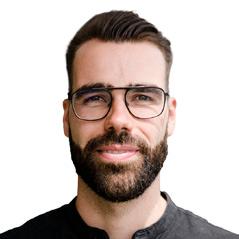
The Port of Antwerp-Bruges is preparing itself for the energy transition of its platform. The transition from oil-based fuels to renewable alternatives presents new challenges but also offers new opportunities. This session will profile the initiatives underway at the Port of Antwerp-Bruges to deliver on decarbonisation and new energy ambitions and targets – in the port environment and in support of different types of transport modes.
ARNE STRYBOS Program Manager Fuel Transition, Port of Antwerp-Bruges

The founder, co-owner and CEO of Actia Forum Ltd established in 2000. Since July 2006 Secretary General of the Baltic Ports Organization. In years 2003 - 1996 he worked as at various positions in the Port of Gdańsk Authority Co. including chairmanship of the Environment Committee of the Baltic Ports Organization. Involved in work of several international transport related organizations: e.g. European Sea Ports Organization, International Maritime Organization. Organizer, chairman and speakers at international conferences.
Graduated in 1993 from University of Gdansk, Faculty of Physical Oceanography. Also graduated from Law and Management post-graduate studies at Gdańsk University of Technology. Participated in professional trainings on management, transport, environment, international relation affairs.
He is member of business and industry advisory and expert bodies, among others member of European Ports Forum.
The project initiative “Baltic Ports for Climate” as well as efforts of Baltic ports to safe the climate will be presented. The aim of the initiative ”Baltic ports for climate” is to reduce emission of GHG from port and shipping activities in the Baltic Sea Region. The project is a positive response to climate challenges as well as to European Grean Deal and Fit for 55 proposal. A number of Baltic ports have already declared the reduction goals of GHG emission and invested in climate friendly technologies such as OPS.
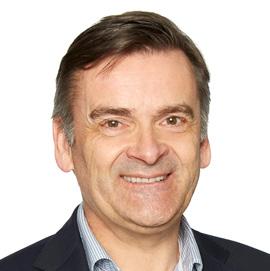
Jan Egbertsen (1964) has studied Management and Logistics at the Technical University Twente. He has been working for more than 20 years for Port of Amsterdam, among others as marketing manager and advisor to the board. At the moment he is manager innovation and strategy and involved in several innovations in the field of shipping, sustainability and energy transition.
Manager Innovation, Port of Amsterdam
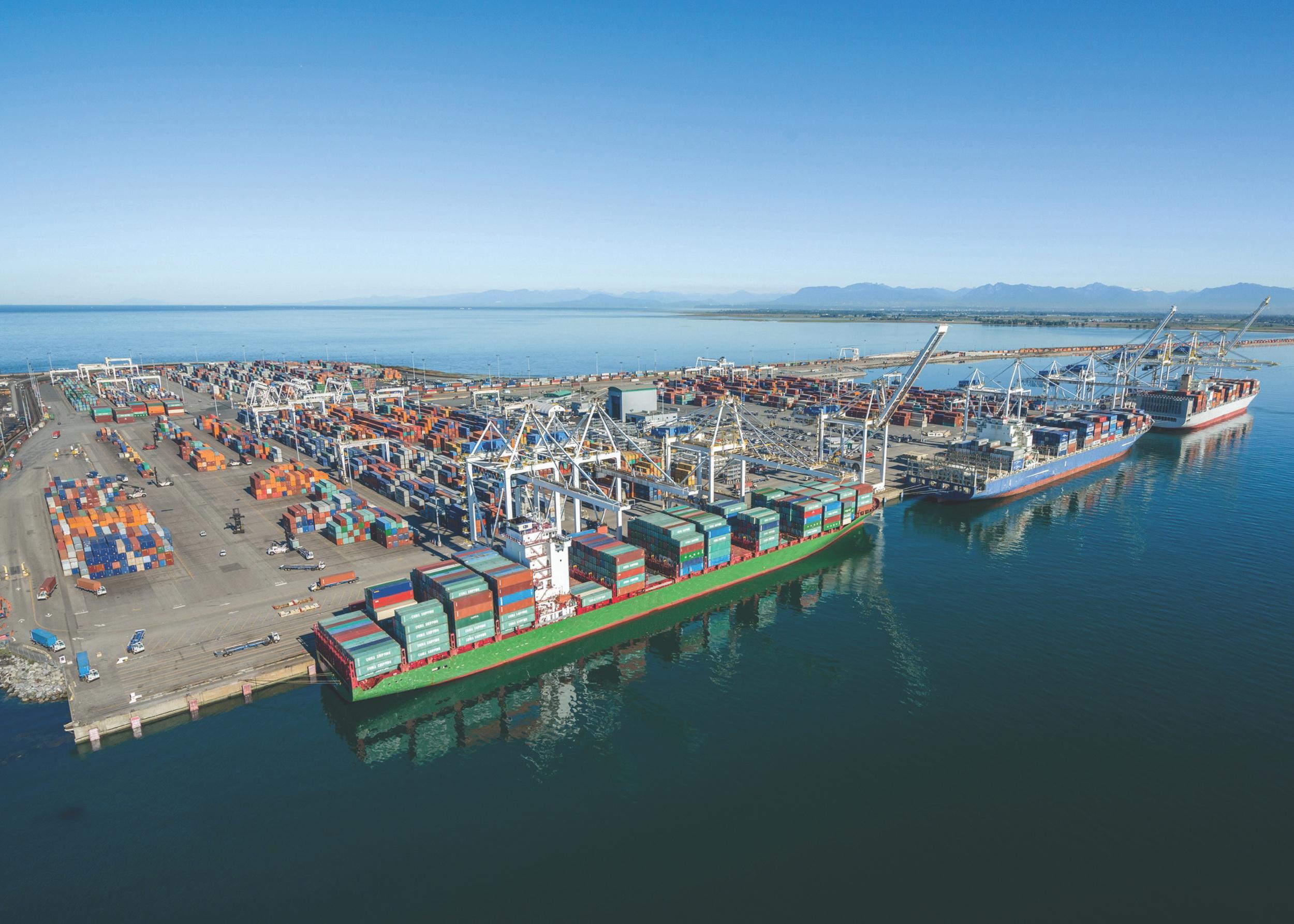
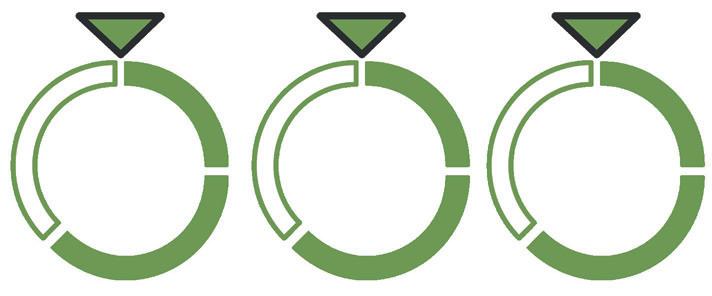
Marketing Manager – ADSP “Autorità di Sistema Portuale del Mare di Sardegna” (Port Network Authority of the Sardinian Sea). Valeria started her professional career in Port of Cagliari in 2002 and first was a lawyer in legal office in Milan. She involved in the cruise industry in 2004. She holds a degree in law from the Catholic University of Milan Italy. she became a lawyer in 1992 in the Court of Appeal of Milan. She attended a master in common law at London school of economic London. UK
She was a vice president of MedCruise, the Association of the Mediterranean Cruise ports between 2005 and 2008; she was in a board of MEDCRUISE like a director of environment from 2008- 2011. From 2013 she has a delegate for environment from MedCruise. From October 2017 she is the Director sustainability/ environmental issue of the Board of MedCruise, from October 2020 is Senior Vice president of MedCruise.
From November 2021 she is a director of technical environmental solutions of MedCruise.

As Director of Sustainability, Linden aims to ensure that MSC Cruises grows in a sustainable way. In this role, Linden works in collaboration with numerous internal and external partners. She established the Executive Chairman-led Sustainable Advisory Board, responsible for approving actions to meet the sustainability goals of the business and ensuring sustainability is embedded across the entire organisation.
Linden has a solid background in environmental protection and sustainability, with experience both as a consultant and in the corporate environment. As a consultant this included working on many diverse projects in Hong Kong and the South East Asia region, including the implementation of environmental management systems and developing environmental and sustainability reporting regimes for government and non-government clients.
She joined Cathay Pacific as the Manager Environmental Affairs in 2003 and in 2009 took up a position at Etihad Airways, initially as Head of Environment and then as Head of Sustainability for the Etihad Aviation Group.
Linden led several successful projects including instigating the voluntary carbon offset program ‘Fly Greener’ at Cathay Pacific and leading the drive towards sustainable alternative fuels at Etihad. The latter including facilitating the longest flight using alternative fuels into the Middle East in 2014 and then enabling a flight powered using sustainable biomass grown and refined into jet fuel in the UAE, a first for the region.


Northern Xplorer CEO and founder Rolf André Sandvik is a master mariner with extensive experience from cruise lines NCL and Crystal Cruises. For several years he was also VP Destination Development. Latterly he founded travel company The Fjords, based in Flåm in western Norway, where as CEO he ushered in a new era of environmentally friendly sightseeing, commissioning the hybrid electric vessels Vision of the Fjords (built 2016) and Future of the Fjords (built 2018). Each vessel can accommodate up to 400 passengers on noiseless, pollution-free journeys in the UNESCO-listed Nærøyfjord. Constructed by specialist Norwegian shipbuilder Brødrene Aa, both vessels won the ‘Ship of the Year’ award during maritime trade fair SMM in Hamburg in their respective delivery years.
Northern Xplorer AS (NX) launched its zero-emission, luxury cruise concept in December 2021. The Oslo-based company aims to open the door to unique communities, natural attractions and experiences in the Nordic countries featuring advanced vessels that are 100% green.
This is a new type of experience cruising providing immersive, enriching experiences for those interested in responsible, low-impact travel. Activities will include interacting with local communities through cultural activities and social dining in small groups. The concept is exclusive yet accessible, intimate yet open, and firmly focused on delivering value for all stakeholders.
NX also aims to disrupt the mainstream mass market by focusing harbours that large ships cannot access, with attention to detail in service and bespoke activities that support local employment and innovation.
The current plan is for a series of 14 identical ships accommodating up to 300 passengers, and featuring transformative clean technologies including fully electric propulsion, battery energy storage, hydrogen fuel cells and auxiliary renewable energy supply (wind and solar power). The timing is perfect in view of availability at shipyards, pent-up demand and increasingly sustainability-conscious consumers and investors.
The first vessels are intended to be operational from 2024/2025, well in advance of new zeroemission regulations affecting Norway’s world-heritage fjords from 2026. Future expansion will provide a gateway to other Nordic destinations both coastal and on navigable waterways inland.
The project also serves to showcase Norway as a crucible for cleantech and its leading role in driving the green transition of maritime, technologically and politically.
Born in Genoa, Italy, Roberto Bruzzone is the Senior Vice President of Marine Operations for Silversea Cruises.
Bruzzone has extensive experience in the shipbuilding industry, having held various positions at major international cruise lines in a successful career that has spanned almost 20 years.
Following a five-year stint as Vice President of Technical Operations at a major cruise corporation—part of a 14-year period at the same company—Bruzzone took the position of Chief Operating Officer to oversee the company acting as the Newbuilding Division of another major cruise line holding, managing large teams of professionals in a position of great responsibility.
A Chartered Naval Architect and Marine Engineer with a Master’s Degree in the field, as well as an Executive Master’s in Business Administration at the London Business School, Roberto has studied in America, Italy and London. He is a Member of both the Lloyds Register Technical Committee and the RINA Technical Committee.
Bruzzone speaks Italian and English fluently.


Silversea Cruises is recognised as an innovator in the ultra-luxury cruise industry. As part of Royal Caribbean Group, Silversea is committed creating a more sustainable cruise industry, achieving net zero carbon emission cruising by 2050. The Group has already reduced greenhouse gas emissions 35% below 2005 levels and continues to invest in pioneering sustainability initiatives. Outlined in its annual ‘Seastainability Report’ for 2021, Royal Caribbean Group states how it will build on the progress already made towards reducing its carbon footprint, detailing a comprehensive roadmap for reaching ‘Destination Net Zero’. Its main pillars of focus are emissions reduction, destination stewardship, sustainable sourcing, and waste. Silversea’s new Nova Class of ships – Silver Nova, due to launch in 2023, and Silver Ray, due 2024 – will employ cutting-edge, unprecedented technological innovations that will enable the ships to be among the most environmentally conscious cruise ships ever built – a testament to Silversea Cruises and Royal Caribbean Group’s commitment towards environmental sustainability.
Silver Nova is set to evolve the landscape of sustainable cruising when she launches in 2023 as Silversea’s twelfth ship. One of the most spacious cruise ships ever built, she will have a spaceto-guest ratio of 75 GRT-per-passenger – the highest in Silversea’s fleet – offering one of the

most personalised services at sea with a 1:1.3 crew-to-guest ratio, as well as the line’s butler services for all suites. The ship will have a travel capacity of 728 guests and a gross tonnage of 54,700 tons. More importantly, she will be the world’s first low-emissions cruise ship with advanced hybrid technology that includes fuel cells, as well as the first ship to be free of local emissions at port. Operating using a trio of power sources, including a fuel cell system, battery technology and dual fuel engines that use liquified natural gas (LNG) as the main fuel, Silver Nova will position Silversea and Royal Caribbean Group at the forefront of sustainable cruising for years to come.
The Nova Class, developed in partnership with Meyer Werft Shipyard, will include the following features:
The largest of its kind, this unprecedented hydrogen-based technology will supplement the main power supply and carry the ship’s total hotel load as the first large-scale fuel-cell installation at sea in the cruise industry. Each of the eight fuel cell modules will have an output of 500 KW, for a combined total of four megawatts. The new hybrid technology will eliminate local emissions in port. Freudenberg, can be credited for designing Silver Nova’s fuel cell system and batteries, working closely with Meyer Werft and Silversea/Royal Caribbean Group.
• LNG (Liquefied Natural Gas)
LNG-fueled propulsion systems emit less CO2 and 97% fewer particulates than normal fuel oil used on ships. LNG fuel is less harmful to the surrounding environment as it releases zero sulfur dioxide emissions, with up to 50% reduction in Nitrogen Oxides emissions (MARPOL NOx tier III) and 20-30% in Carbon Emissions. This makes LNG the cleanest fossil fuel available.
A bank of batteries supports by optimising the overall ship power system, increasing the overall energy efficiency and saving fuel. Batteries will compensate for the electrical load fluctuations (peak shaving) and therefore optimise the overall ship power system and energy consumption, allowing the ship to run the engines at optimal load.
A newly developed Micro Auto Gasification System (MAGS) will reduce onboard waste volume, resulting in lower incineration emissions. MAGS is the world’s most compact, efficient, and environmentally safe technology for the conversion of waste into thermal energy for use by the site where the waste is generated. MAGS can be used to burn waste produced by the ship or turn it into gas, while sterilizing the inorganic portion of the waste. MAGS thermally breaks down waste and transformsit into a solid carbon material (biochar) and a synthesis gas (syngas). The syngas becomes the main fuel source for MAGS. This results in a reduction of landed waste and lower incineration emissions. In addition to on-board recycling, MAGS reduces the environmental impact from our waste by:
- Reducing air emissions from waste system
- Eliminating untreated overboard discharge
- Eliminating waste going to landfills
A state-of-the-art waste-heat recovery system in the main engines allows the ships to use waste heat in several locations, such as in absorption chillers and with this improve the overall energy efficiency of the ships. Additionally, multi-compressor
chillers will optimise the chilled water system, ensuring that the ships are at the ideal COP performance area in all operational situations. This reduces the energy consumption of the HVAC system and optimizes the overall energy consumption.
In partnership with Meyer Werft Shipyard, Silver Nova is thoughtfully designed and built taking into consideration the carbon footprint of ship construction and creating a path to overall reduction. Meyer Werft is now one of the most environmentally friendly shipyards in Europe and is building the Nova class ships in collaboration with Royal Caribbean Group, using unprecedented technological solutions and respecting carbon-controlled processes.
The new hybrid technology will not only secure zero local harmful emissions while at berth; it will also be crucial in helping the Nova Class achieve a 40% overall reduction in its greenhouse gas emissions per double occupancy when compared to the brand’s previous class of ships. Thanks to the hydro-dynamically optimized hull and propulsion design, Silver Nova will have a better hydrodynamic performance and will therefore consume less fuel, being 30% more fuel efficient per passenger day. The ship class is also projected to achieve an Energy Efficiency Design Index (EEDI) rating approximately 25% better than applicable International Maritime Organization (IMO) requirements.
The Nova Class is therefore a quantum step that builds on the Meyer Werft’s experience and expertise in this field. The Nova Class fleet is the latest example of Silversea’s ongoing effort to offer travelers an ultra-luxurious experience while simultaneously protecting the treasured destinations it visits and the communities it serves. The launch of Nova Class is the first step of a long-term journey undertaken by Silversea Cruises and Royal Caribbean Group to rethink and reimagine the future of the cruising industry under a more sustainable lens.
Silversea Cruises is recognized as an innovator in the ultra-luxury cruise industry, offering guests large-ship amenities aboard its intimate, all-suite vessels: Silver Dawn., Silver Shadow., Silver Whisper®, Silver Spirit®, Silver Muse®, and Silver Moon.—all designed to offer an atmosphere of conviviality and casual elegance. With the inclusion of the expedition ships Silver Endeavour., Silver Origin®, Silver Wind®, Silver Explorer®, and Silver Cloud®, Silversea’s itineraries encompass all seven continents and feature worldwide luxury cruises to the Mediterranean, the Caribbean, the Galápagos, both Polar Regions, and hundreds of fascinating destinations in between. Silversea is also looking forward to the launch of two new ultra-luxury Nova-class ships—Silver Nova. and Silver Ray.. Silversea Cruises is one of Royal Caribbean Group’s (NYSE: RCL) five cruise brands.
About Royal Caribbean Group
Royal Caribbean Group (NYSE: RCL) is one of the leading cruise companies in the world with a global fleet of 64 ships traveling to approximately 1,000 destinations around the world. Royal Caribbean Group is the owner and operator of three award-winning cruise brands: Royal Caribbean International, Celebrity Cruises, and Silversea Cruises, and it is also a 50% owner of a joint venture that operates TUI Cruises and Hapag-Lloyd Cruises. Together, the brands have an additional 10 ships on order as of June 30, 2022.
Learn more at www.royalcaribbeangroup.com or www.rclinvestor.com.
Steel cutting: November 18, 2021
Expected delivery: Summer 2023
Silver Nova is being built by Meyer Werft in Papenburg, Germany
Total guest capacity: 728
Crew capacity: 556
Total suites: 364
Crew-to-guest ratio: 1:1.3
Tonnage: 54,700
GRT Space-to-guest ratio: 75 GRT-per-guest
Speed: 19.4 knots
Passenger decks: 9
Number of restaurants: 8
Suites with private verandas: 100%
Length overall: 244.2m (801 feet)
Width: 29.6m (97 feet)
Flag: Bahamas
Ahila Karan is a Senior Decarbonisation Analyst in the LR Maritime Decarbonisation Hub, which launched its first Green Corridor Cluster initiative for shipping focused on bunkering alternative fuels in Singapore. She has more than 7 years’ experience covering global energy markets, with a particular focus on transportation fuels and the cleaner fuels transition.
Ahila holds a Masters from the University College London in Economics, previously working at oil trading company Trafigura as the Global Distillates Analyst where she was also involved in producing analysis on shipping industry trends and fleet analysis.
Prior to this, Ahila worked as a journalist at S&P Global, reporting on major energy news and the latest environmental policy changes affecting the shipping and road fuels industries.

Edvard Molitor is the Head of Sustainability in Port of Gothenburg, Scandinavia’s largest port and one of the leading ports of the world in environmental matters. Mr Molitor leads the strategic environmental management at the Gothenburg Port Authority and is responsible for the sustainable development of the port through successful implementation of environmental permits and international requirements.
From 2017 to 2020, Mr Molitor chaired the Sustainable Development Committee of the European SeaPorts Organisation and from 2020 onwards, he is the vice chairman of the Climate & Energy Committee of the International Association of Ports and Harbors.
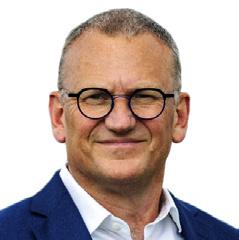
Mr Molitor has a wide international experience of environmental management, sustainable development, maritime operations, and marine pollution response, and holds a M.Sc. degree in Aquatic and Environmental Engineering from Uppsala University. Mr Molitor has previously worked at SSPA Sweden AB, at the European Maritime Safety Agency (EMSA) and at the Swedish Coast Guard Headquarters.
Daan Schalck was born in 1963 in Ghent, Belgium. After his studies at Ghent University he started his career in 1988 in the drinking-water sector. Between 1995 and 1999 he was adviser for economy and ports to the responsible alderman in Ghent. Between 1999 and 2004 he was a member of the Belgian Federal Parliament. He specialized in public enterprise and mobility. In 2004 Daan Schalck made the change-over to the private sector and started working with Ernst & Young. However, the port scene continued to captivate him. In 2007 he became general director of the company responsible for the regional zoning policy on the left bank of the Scheldt for the port of Antwerp. In June 2009 he returned to his native city as CEO of Ghent port. Until today, Daan Schalck is also president of Flanders Mobility Council, the strategic advisory board of the Flemish regional government. He is a visiting professor at the Ghent University and is also vice-chair at the European Sea Ports Organisation (ESPO). After the merger between Ghent Port Company and Zeeland Seaports he became CEO of North Sea Port.


Tam has over seven years of experience in corporate sustainability, decarbonisation strategies and net zero transition for governments and large corporations across different industries. She is currently responsible for developing and implementing RightShip’s sustainability initiatives to improve maritime industry sustainability practices, including port-related projects such as maritime air emissions inventories and emission reduction strategies. Tam holds a master’s degree in Environmental and Sustainability Management.
Jon holds over a decade’s experience in environmental management systems, sustainability projects and innovation. He’s spent the last six years within the maritime sector promoting environmental considerations in vessel acquisition and support, complemented by onboard experience driving environmental compliance and performance.
His current role is based out of London and primarily involves working with myriad maritime stakeholders providing and developing digital tools that enable smart use of data to plan, do, check and act on environmental performance with a particular focus on air emissions (Greenhouse gases and air pollution).

JON LANE
EMEA Environmental Manager, RightShip
The shipping sector is the backbone of global commerce, accounting for approximately 80 to 90% of all trade. It accounts for about 3% of total CO2 emissions, an amount projected to double by 2050, according to the International Maritime Organization (IMO) 4th GHG1.
Recognising the need for climate action, the IMO has mandated targets of carbon intensity reduction of 40% by 2030 and 70% by 2050, complemented by a minimum absolute reduction of 50% by 2050.
At COP26, 22 countries signed the Clydebank Declaration for green shipping corridors2specific trade routes between major port hubs where alternative, low and zero-emission fuels will be progressed.
Green shipping corridors will serve as pilots to demonstrate how key ecosystems, including regulatory sandboxes for new fuels, green financing, information sharing, and carbon accounting mechanisms can be brought together to provide practical ways to decarbonise the maritime industry. Achieving a stage of maturity where future fuels can be deployed across green shipping corridors will assist in accelerating decarbonisation for the wider maritime industry.
Within these pilots, there is opportunity to take advantage of big data and digital solutions. With the advent of the Internet of Things (IoT), digital twins, predictive analytics and blockchain there is the potential for increased data flows, information sharing and collaboration amongst stakeholders.
The Covid-19 pandemic has changed industry’s appetite and acceptance of digital solutions. Exploiting insights from big data and digitalisation can further enhance intermodal connectivity in the supply chain across different transport modes at national and supra-national level. These data insights can drive operational efficiency improvements in line with IMO regulations, vessel management and support air quality improvements in ports.
This paper outlines the important role of utilising data and the insights they provide to identify opportunities to optimise green corridors, and, through a set of case studies, how innovative digital solutions can help identify emission hotspots in supply chains and port operations.
There are over 50,000 vessels in the global fleet transiting the oceans, or operating near or in a port, at any one time. The myriad environmental impacts from the vessels include, but are not limited to:
5 CO2 emissions, 5 liquid waste discharge during transit, 5 local air quality when operating around the port, 5 use of port waste reception facilities, and 5 potential transfer of non-native species through ballast and biofouling.
Harnessing the increasing volumes of data available through digital solutions such as IoT and digital twins, predictive analysis, blockchain, and in-port operations can provide accurate and
timely data flows for insight and analysis of these environmental impacts for real time and predictive requirements.
Additionally, information sharing can facilitate better integration of the shipping and co-modal supply chains, allowing insight for more efficient operations and more agile responses to disruptions.
With regards to in-port emissions, big data can be collected from vessel movements in port areas which can be processed into geo-fence maps provided on a digital platform. Visual representations of data can be interrogated on the platform to analyse GHG and air pollutant volumes, including hotspots (Figure 1).
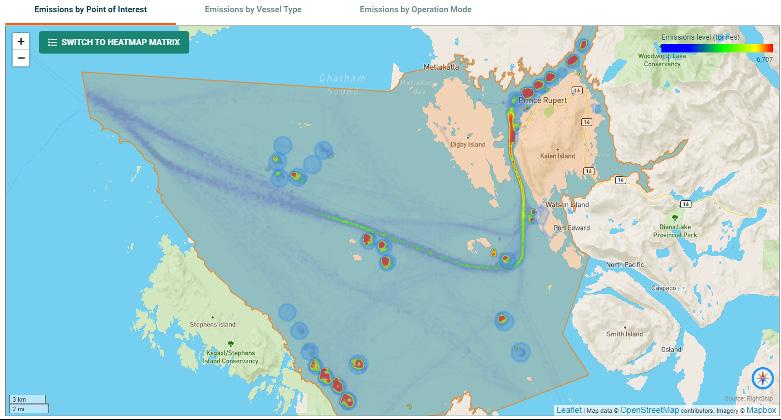
In turn, harbourmasters can utilise these insights to further progress action on existing emissions targets within the Ports Environmental Management System, and where they are not in existence, to help identify and establish targets.
Big data from across the global fleet and port operations is also supported by the evolving IoT.
Utilisation of low-cost ship sensors, along with the development of a new generation of advanced sensors provide remote environmental and conditional monitoring and data collection. This information can be transmitted to stakeholders and used in real time, to facilitate monitoring of asset status, identification of inefficiencies, optimisation of pre-planned maintenance and to highlight potential faults to reduce reactive maintenance and avoid potential MARPOL violations.
Digital twins can aid vessels operational and strategic decision making, for example weather routing, and/or foresight on maintenance issues, using digital scale models of vessels.
Ports supporting passenger and commercial vessels can interrogate and test scenarios with visual representation based upon historical and real-time data provided by IoT. Sharing this data amongst stakeholders within the port community allows improved berthing plans, which reduce waiting times and fuel consumption and thus lower GHG emissions and local air quality impacts.
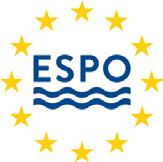
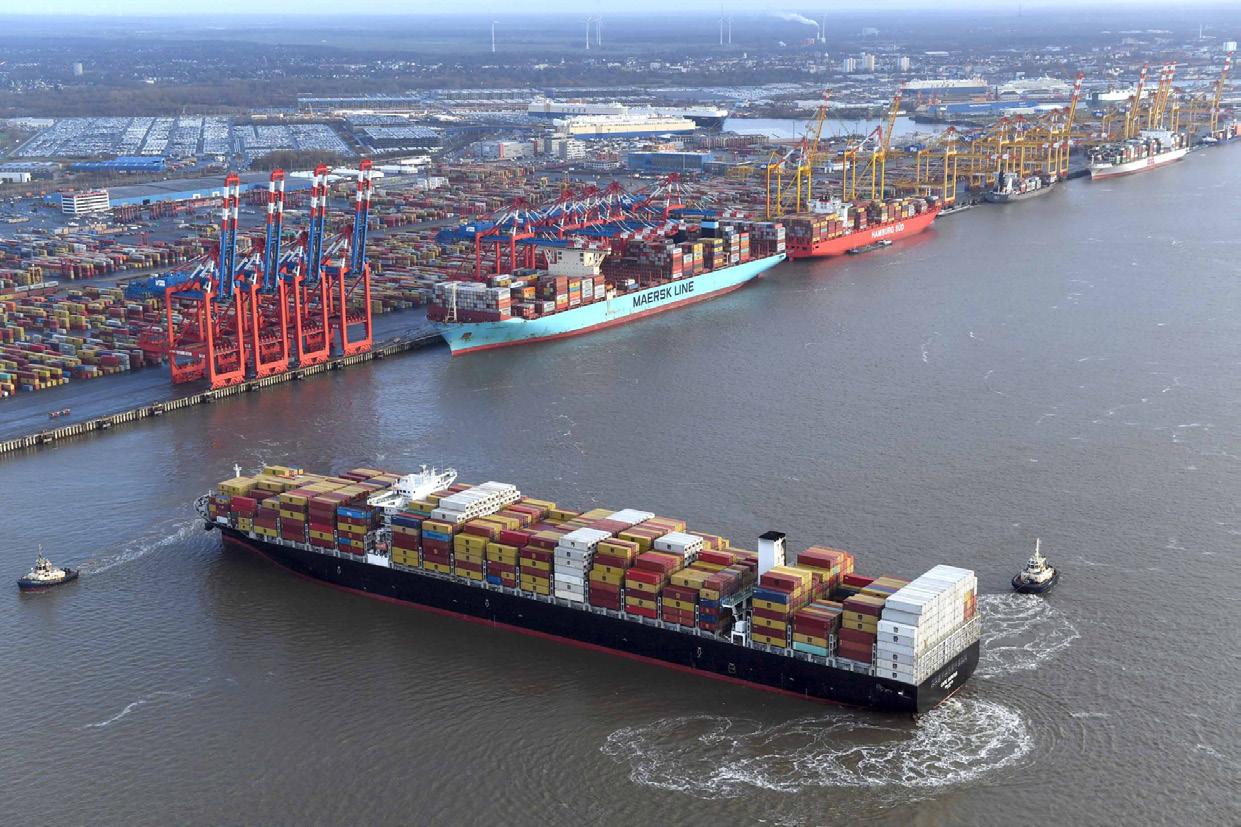
Marketing Manager – ADSP “Autorità di Sistema Portuale del Mare di Sardegna” (Port Network Authority of the Sardinian Sea). Valeria started her professional career in Port of Cagliari in 2002 and first was a lawyer in legal office in Milan. She involved in the cruise industry in 2004. She holds a degree in law from the Catholic University of Milan Italy. she became a lawyer in 1992 in the Court of Appeal of Milan. She attended a master in common law at London school of economic London. UK
She was a vice president of MedCruise, the Association of the Mediterranean Cruise ports between 2005 and 2008; she was in a board of MEDCRUISE like a director of environment from 2008- 2011. From 2013 she has a delegate for environment from MedCruise. From October 2017 she is the Director sustainability/ environmental issue of the Board of MedCruise, from October 2020 is Senior Vice president of MedCruise.
From November 2021 she is a director of technical environmental solutions of MedCruise.

Martyn Griffiths is a Welsh man who has been living and working in Brussels since 1999. He is currently the Director Public Affairs at the Cruise Lines International Association a position he has held since 2016. He is responsible for issues management and developing proactive communications around the industry’s sustainability initiatives.

Previously he spent six years at the animal welfare NGO, Eurogroup for Animals, helping the organisation redefine its purpose from a legislative focus to a proactive campaigning focus. He has also worked for CEPI the European Paper Producers Association where he developed their sustainability approach including the Paper Value Tree and Meet Paper initiatives.
His first appointment in Brussels was as Communications Manager with the European Council of Vinyl Manufacturers where he developed the industry’s 10-year sustainability programme, Vinyl 2010, as well as the industry’s award-winning specifier engagement programme, PVC for Life and Living.
His background saw him study Management Science at Aston University in the UK followed by post-graduate studies in Media and Public Relations at the Welsh School of Journalism, University of Wales, in Cardiff. He is a specialist in issues and crisis management and has worked for many organisations in all sectors of society helping them manage major change programmes and major customer/audience issues management programmes.
MARTYN GRIFFITHS Director for Public Affairs, CLIA in Europe
CLIA represents 95% of the world’s ocean-going cruise capacity, as well as 54,000 travel agents, 15,000 of the largest travel agencies in the world, and industry stakeholders, including ports, destinations, ship developers, suppliers, and business services. We are the only association that brings together ocean cruise lines and river cruise operators with travel agents and the wider cruise community. The cruise industry is one of Europe’s success stories supporting hundreds of thousands of jobs and contributing to economies.
The cruise industry is committed to pursuing net-zero carbon cruising by 2050 and supports the long-term objectives of the EU Green Deal. By driving innovation through shipbuilding in Europe, the industry can help to enable European green growth, as set out in the Green Deal and EU recovery plans.
On 8 November, we published our 2021 Global Cruise Industry Environmental Technologies and Practices Inventory (ETP) and associated Environmental Report produced by Oxford Economics (OE).
The annual report demonstrates the industry’s commitment to responsible tourism practices and our continued progress on the development and implementation of green maritime technologies. Our vision is net-zero carbon cruising by 2050 and CLIA and our ocean-going members are investing in new technologies and cleaner fuels now to realise this ambition. The report notes substantial progress across a range of areas:
Shoreside electricity (SSE)
Cruise lines continue to make significant investments to enable ships to connect to shoreside electricity, allowing engines to be switched off in port.
Globally, 82% of new build capacity is either committed to be fitted with shore-side electricity capability or will be configured to add SSE in the future, and 35% of global capacity is fitted to operate on SSE in the 14 ports worldwide where that capability is provided in at least one berth.
In Europe, EU Fit for 55 proposals state that all ships must connect to SSE (or use compliant fuel) by 2030, regardless the type of berth. Currently, however, there are only a handful of berths providing SSE in European ports. Furthermore, based on publicly announced investments, it is currently projected that only 5.81% of cruise berths in the EU will be able to provide SSE

by 2025. While it is therefore clear that significant investment in portside infrastructure will be required, there are many collaborations underway between cruise lines, ports and local authorities to increase SSE.
The report addresses the challenge posed by the need for new, alternative fuels to achieve ambitious carbon reduction goals and the steps the industry is taking to support progress. Specifically, in addition to LNG, over three-quarters of the global cruise fleet by passenger capacity is equipped to use alternative fuels. Alternative fuel sources being developed include biodiesel, methanol, ammonia, hydrogen, and electric batteries. The report notes that there remain engineering, supply, and regulatory hurdles before the large-scale adoption of such fuels can take place, but the cruise industry’s growing investment is facilitating the research and development of these fuels.
The cruise industry underpins shipbuilding and the maritime economy in Europe. Notably, 80% of the value of ships built in Europe are cruise ships, representing a significant contribution to European economies. Europe is a global leader in building the complex, future-proof cruise ships in operation today. The skillsets, experience, and technical knowledge developed in member states as a result offer worldwide competitive advantage and put cruise squarely at the heart of Europe’s green growth ambitions.
Find out more about our global environmental sustainability
Cruise lines are committed to connecting to shoreside electricity when it is available and to working closely with ports to make this possible. Connecting a large cruise ship with a power consumption of up to 12 megawatts to the shore power grid is not as simple as it sounds. In addition to a technical infrastructure including a power plant, supply lines and conversion equipment, various tests and synchronisation measures are required to ensure uninterrupted ship operations. This procedure must be repeated for every ship in every port before the permanent connection can be made.
CLIA members are committed to working with ports and local authorities to support these projects. So far, however, more cruise ships are equipped with shore power connections than there are ports internationally that offer this option and CLIA members have committed to send ships equipped with SSE technology to ports where it is available and to use SSE while berthed. In line with the Fit For 55 Package CLIA is encouraging all ports to equip their cruise berths with this capability, to the benefit of their local population and to support the decarbonisation of the maritime sector.
Alternative fuels are a critical element to the maritime industry decarbonization strategy. CLIA Europe is therefore calling for a more consistent approach to the measures proposed throughout the Fit for 55 package to support the production and use of alternative fuels.
Today there are 26 cruise ships currently sailing, on order or under construction powered by LNG for primary propulsion. This means that 52% of new build cruise ships capacity currently on order is committed to rely on LNG for primary propulsion3. CLIA welcomes the introduction
of a specific target for LNG supply in the Trans-European Transport Network (TEN-T) ports. To ensure consistency with the rest of the package, supply of Renewable Synthetic LNG should also be clearly supported in the Renewable Energy Directive. Beyond LNG, cruise operators are also exploring other options to decarbonize the energy used onboard, hydrogen and hydrogen derived fuels should also be supported in the EU schemes. In this regard, the mandate for Member States to develop by 2024 a national policy framework including “a deployment plan for alternative fuels infrastructure in maritime ports other than for LNG and shore-side electricity supply for use by sea going vessels” (Art. 13.1.n) is welcomed. CLIA and its members are committed to supporting Member States in the development of these plans, ensuring that they also take the specific needs of cruise ships into consideration.
CLIA and its cruise line members have enjoyed a close and positive cooperation with the destinations they visit for many years but now more than ever our sustainability profile is being challenged. Cruise lines are developing policies and systems to respond to the demands of a fully circular economy. Waste management, resource reduction and sustainable procurement are central to this. In the EU the Port Reception Facilities Directive manages the interface between shipping companies and the ports. It is therefore vital that we can be sure that our waste is being recycled and managed sustainably and that the destinations we visit recognise this.
Cruising is at the forefront of delivering a sustainable maritime sector, We are at the forefront of maritime innovation and offer many best practices that can be employed across the shipping industry.
We continue to invest and develop our ships to ensure they have the minimum impact n the destinations they visit and provide economic well being to the destinations we visit.
Ryann Child (she/her) is responsible for designing and implementing clean air and climate action programs to reduce air and greenhouse gas (GHG) emissions from Port of Seattle’s maritime operations. Ryann is the project manager for the Alaska, British Columbia, Washington Green Corridor, a new partnership of ports, cruise lines, and nongovernmental organizations exploring the feasibility of zero-GHG emission cruise ships to Alaska. Ryann also developed the Port’s first ever Maritime Climate and Air Action Plan. She has a background in environmental consulting and holds a B.A. in Environmental Science and Policy from Duke University. Outside of work, Ryann enjoys running, biking, and playing competitive Ultimate Frisbee.
Current duties and responsibilities:
• Alaska, British Columbia, Washington Green Corridor project manager
• Develop and implement projects and programs to reduce air and greenhouse gas emissions from Port of Seattle’s maritime properties and operations
• Conduct the Port’s annual Maritime GHG Emissions Inventory
• Lead climate and clean air community engagement

In May 2022, the Port of Seattle, City and Borough of Juneau, Vancouver Fraser Port Authority, Carnival Corporation, Norwegian Cruise Line Holdings, Royal Caribbean Group, Cruise Lines International Association, the Global Maritime Forum, Blue Sky Maritime Coalition, and Washington Maritime Blue announced a commitment to explore the feasibility of the world’s first cruise-led green corridor in the Pacific Northwest of North America. The communities of Sitka, Skagway, and Haines in Alaska and the Greater Victoria Harbour Authority have also joined the partnership. This presentation will share Port of Seattle’s reflections on early lessons from the establishment of this international public-private partnership and preview the opportunities and challenges ahead as this collaborative explores the feasibility of zerogreenhouse gas emission cruise ships serving the Alaska cruise market.
In 2021, twenty-four countries, including the United States and Canada, signed the Clydebank Declaration. The declaration committed the countries to support the establishment of at least six green corridors by 2025 while aiming to scale up activity in future years.1
Green corridors are a new concept globally and leaders are needed to step forward and make this vision a reality. Globally, there is not yet a shared understanding of what it means for a maritime corridor to be “green” nor are there well-documented, or one-size-fits-all, solutions to achieve a green corridor.
According to the Global Maritime Forum, a green corridor is a shipping route where zero greenhouse gas (GHG) solutions are considered, demonstrated and supported. Green corridors—through collaboration across sectors—establish the technological, economic, and regulatory feasibility needed to accelerate implementation of low and ultimately zero GHG emission vessels.2 Additional definitions have developed as more green corridors emerge across the world, with some focusing on incremental emission reduction and others focused on technology development and fostering the deployment of scalable zero-emission fuels.3
It is up to ‘first movers’—those who wish to take early action to demonstrate feasibility—to collaborate, define, and implement the optimum pathway to get to zero.
This paper provides early insights into what it will take to explore and establish a green corridor focused on cruise ships in the Pacific Northwest of North America.
1 UN Climate Change Conference UK 2021. (2021). Clydbank Declaration for Green Shipping Corridors. Retrieved from https://ukcop26.org/cop-26-clydebank-declaration-for-green-shipping-corridors/
2 Global Maritime Forum. The Next Wave: Green Corridors. November 2021. https://www.globalmaritimeforum.org/ content/2021/11/The-Next-Wave-Green-Corridors.pdf
3 Global Maritime Forum. (2022). Discussion Paper: Green Corridors: Definitions and Approaches. Retrieved from https://www.globalmaritimeforum.org/content/2022/08/Discussion-paper_Green-Corridors-Definitions-andApproaches.pdf
The Port of Seattle (the Port) was founded in 1911 as a special-purpose municipal corporation serving the citizens of King County in Washington State, USA. The Port is governed by a publicly elected board of commissioners. Its mission is to create good jobs regionally and across Washington by advancing trade and commerce, promoting manufacturing and maritime growth, and stimulating economic development.
Since inception, the Port mission evolved to include not only economic interests but also a deep commitment to environmental and social goals. This commitment shows in the Port’s progressive Century Agenda goals4, its vision to be the greenest, most energy efficient port in North America, and its significant investment in environmental programs.

The Port is a leader in moving people and cargo across the country and around the world. Port’s operations include:
6 One of the largest cruise port on the West Coast with over 1.2 million revenue cruise passengers in 2019 and 1.2 million expected in 2022
6 The Northwest Seaport Alliance (NWSA), a marine cargo operating partnership between Port of Seattle and Port of Tacoma in Washington, the 4th largest container gateway in the U.S. 6 Bulk cargo terminal that exports over 4 million tonnes of grain and soy, connecting farms in the American Midwest to consumers in Asia 6 Seattle-Tacoma International Airport, the 10th busiest airport in North America 6 Home to the North Pacific Fishing fleet, vessels based at Port of Seattle supply about 13 percent of the total U.S. commercial fishing harvest by tonnage 6 Real estate portfolio of over 80 buildings across 10 waterfront campuses 6 Recreational boating marinas, some with nearly 600 year-round, live-aboard tenants
Port of Seattle is one of the largest and fastest growing cruise market on the West Coast with two cruise terminals and three cruise berths:
6 A single berth facility at the Bell Street Pier Cruise Terminal at Pier 66 on the downtown waterfront; and, 6 A double berth facility at the Smith Cove Cruise Terminal located at Pier 91 north of the city’s waterfront.
Cruise is a major economic driver in Seattle. The cruise industry delivers $900 million in annual business revenue to the greater Seattle region during typical operations. In 2019, cruise hit a record year with 1.2 million revenue passengers passing through terminals in Seattle. After the cancellation of the cruise season in 2020, cruise ships returned for a partial season in 2021 with 82 cruise calls and 229,000 revenue passengers at Seattle terminals. Cruise has rebounded in 2022 with an anticipated 1.2 million revenue passengers in Seattle and a record number of cruise calls.
In Alaska, cruise brings over one million cruise passengers to visit each year. In 2019, cruise ship passengers hit record levels at 1.33 million people sailing. In 2022, Juneau—the primary port of call in Alaska—is scheduled to see over 680 vessel calls.5 Cruise travel to Alaska contributes $3 billion to Alaska’s economy each year.6
Table 1. Scheduled Cruise Ship Calls for 2022 in Participating Ports Along the Green Corridor
Port Community 2022 Cruise Ship Calls Scheduled Juneau, Alaska, USA 682 Skagway, Alaska, USA 461 Victoria, British Columbia, Canada 320 Vancouver, British Columbia, Canada 290 Seattle, Washington, USA 289 Sitka, Alaska, USA 285 Haines, Alaska, USA 76
Source: Cruise Lines International Association. (2022). 2022 Port Schedule. Retrieved from CLIA Alaska: https://akcruise.org/port-schedule/
1.4 Toward the Greenest Port in North America
The Port hosts one of the largest cruise markets on the West Coast and has ambitions to be the greenest. For more than 20 years, the Port of Seattle has prioritized protecting the environment while growing cruise. Key environmental accomplishments and ongoing initiatives include: 6 Prioritizing water quality protection in Puget Sound: Since 2004 the Port has partnered with Washington State Dept. of Ecology and the cruise industry in a
5 Cruise Line Agencies of Alaska. JNU-Juneau-2022. https://secureservercdn.net/198.71.233.116/2xl.54d.myftpupload. com/wp-content/uploads/2022/08/JNU-Juneau-2022.pdf
6 State of Alaska Departments of Revenue, C. C. (2021). Impacts to Alaska from 2020/2021 Cruise Ship Season Cancellation. Retrieved from https://gov.alaska.gov/wp-content/uploads/sites/2/04082021-Cruise-Impacts-toAlaska.pdf
voluntary agreement, called the Memorandum of Understanding Cruise Operations in Washington State, which helps prevent wastewater discharges from large cruise ships into state waters. Starting in 2020, the Port prohibited cruise ships at berth from discharging exhaust gas cleaning system wash water.
6 Partnering on clean air: Since 2008, the Port has collaborated on the Northwest Ports Clean Air Strategy. The 2020 Strategy sets a bold vision to eliminate air pollution and be carbon free by 2050 and calls for ongoing partnerships and engagement with the cruise industry, governments, community groups, and other ports.
6 Reducing at-berth emissions with shore power: The Port provides clean shore power at two cruise berths at Terminal 91 and is on track to add shore power to its third berth at Pier 66 by 2024, making all cruise berths shore power capable.
6 Accelerating GHG reduction targets: In 2021, Port of Seattle accelerated its GHG reduction targets:
- By 2030, achieve a 50 percent reduction in GHG emissions (Scopes 1, 2, 3)
- By 2040, achieve net zero or better for Port-owned GHG emissions (Scope 1 & 2) from a 2005 baseline
- By 2050, achieve carbon neutral or better for GHG emissions from industries operating at ort facilities (Scope 3) from a 2007 baseline
6 Charting the course to zero emissions: Port Commission adopted the Port’s first ever Maritime Climate and Air Action Plan in 2021.
6 Planning for clean energy: The Port is partnering with its electric utility and waterfront industry to complete a Seattle Waterfront Clean Energy Strategy, which will holistically identify the policies, technologies and investments needed to deploy zero-emission infrastructure and to enable the transition to zero-emission maritime equipment and operations.
There were several reasons behind the development of the Alaska, British Columbia, Washington Green Corridor.
From Port of Seattle’s perspective, it started with the need to address the complex challenge of reducing air and GHG emissions from cruise ships. Cruise ships are the largest source of maritime-related emissions for the Port (not including marine cargo terminals in Seattle, which are operated by the Northwest Seaport Alliance). The Port has set ambitious GHG targets and put in place plans to chart a course to zero-emissions, but maritime industries continue to face significant barriers to the large-scale development and deployment of zero-emission maritime fuels and technologies. While there is not yet a clear pathway or silver bullet solution to address these emissions, a public-private partnership on a green corridor increases the Port’s span of influence and fosters the collaboration needed to accelerate the decarbonization of cruise and the maritime sector as a whole.
Additionally, the Port recognized the significant opportunity for the region to establish a green corridor:
1. The Port has a history of working with other ports and cruise lines in the Pacific Northwest region to partner on environmental action. These established relationships create a strong foundation for a green corridor partnership to build upon;
2. Washington State has laws and programs already in place that support reducing carbon emissions from transportation;
3. The Pacific Northwest is a highly diversified hub for maritime research and development, innovation, engineering, and for private sector companies pioneering clean technologies and maritime fuel; and,
4. A distinct maritime corridor exists between Puget Sound and Alaska with regularly scheduled vessel calls by cruise, commercial fishing, cargo, ferries, and tug industries.
Furthermore, communities adjacent to port terminals and other industrial properties in Seattle bear a disproportionate burden of health impacts and environmental injustices compared to other areas of the city. A green corridor and the transition away from fossil fuels can accelerate environmental justice for near-port communities that experience more exposure to air pollution and the impacts of a changing climate.
All of these factors signaled both the need for action and the existence of key “building blocks”7 that could support an emerging, cruise-focused green corridor to Alaska.
The initial set of partners who signed on to the Alaska, British Columbia, Washington Green Corridor are called “First Movers”, as these organizations are committed to taking early action and demonstrate the feasibility of a green corridor. Partners signed a First Mover Agreement committing to taking the following steps:
6 Work together to explore the feasibility of a green corridor in the Pacific Northwest of North America, including, but not limited to, further defining the scope and application of the green corridor concept;
6 Enhance and support the emission-reduction efforts already underway and using the green corridor as a testbed for low and zero GHG technologies and ships, as feasible; and
6 Work collaboratively to define the governance structures, terms, and frameworks needed to guide this regional effort.
At the time of writing, project partners include the following cruise ports and port communities in Seattle, British Columbia, and Alaska, cruise lines, and nongovernmental organizations:
6 Port of Seattle, Washington
6 Vancouver Fraser Port Authority, British Columbia
6 Greater Victoria Harbour Authority
6 Haines Borough, Alaska
6 City and Borough of Juneau, Alaska
6 City and Borough of Sitka, Alaska
6 Municipality of Skagway, Alaska
6 Carnival Corporation and its cruise brands including Princess, Holland America Line, Carnival, Seabourn, and Cunard
6 Norwegian Cruise Line Holdings and its cruise brands including Norwegian Cruise Line, Oceania Cruises, and Regent Seven Seas Cruises
6 Royal Caribbean Group and its cruise brands including Royal Caribbean International, Celebrity Cruises, and Silversea Cruises
6 Cruise Lines International Association
Global Maritime Forum
Blue Sky Maritime Coalition
6 Washington Maritime Blue
The initiative could potentially expand to other maritime sectors or other regional ports in the future. The initial focus, however, is on the cruise corridor as there are unique aspects of cruise travel to account for when assessing the feasibility of a zero-emission ship and corridor.
Since launch of the project in May 2022, First Mover Partners have met monthly. Initial conversations covered project organization and governance, and focused on the following foundational questions:
1) How do we work together?
2) How do we make decisions?
3) How do we appropriately engage stakeholders who want to be involved and/or have some expertise to share in this endeavor?
At the meeting in August, First Movers focused on how to define a green corridor specific to the Alaska cruise market. Partners shared their initial thoughts on a definition.
Since this is the first cruise-focused green corridor in the world, First Movers have an opportunity to establish a definition that can contribute to shaping green corridors globally as well as one that captures the uniqueness of cruise and the Pacific Northwest. Input shared regarding the definition will also inform the scope of the project and feasibility study. The initial discussion on a green corridor definition raised several themes: 6 There is interest in aligning with internationally recognized definitions of green corridors that focus on zero-GHG emission vessels, while also acknowledging local goals and the need to reduce emissions along the way to the zero-emission transition. 6 The definition should consider the smaller ports involved and how these ports may contribute differently to the corridor. 6 More discussion is needed to define the scope of the corridor and whether it will include cruise operations beyond ships, such as buses and shore excursions. 6 Partnership and stakeholder involvement is a critical element of a green corridor. First Movers recognize that an effort of this scale must happen though collaboration and involve the full value chain. Similarly, how to engage community stakeholders and environmental justice advocates must also be defined
The Alaska, British Columbia, Washington Green Corridor is the first green corridor in the world to focus on cruise ships. As more green shipping corridors emerge across the world, there is the desire to find opportunities to align and share lessons, but also a need to acknowledge key differences. The following elements are some of what make a cruise-focused green corridor unique: 6 A round-trip journey with multiple stops: Rather than a corridor that moves goods from point to point, cruise ships traveling to and from Alaska make multiple stops along the way, and most ships return where they started in either Seattle, Washington or Vancouver, British Columbia. These characteristics could open up opportunities not feasible for transoceanic shipping, such as the use of less energy dense fuels. It could also mean that fuel could come from a single source at the homeports in Seattle and Vancouver, with some exceptions, where cargo routes must think about
zero-emission infrastructure at both ends. How the corridor could include the Alaskan ports will be different than how a freight corridor will include turnaround port partners at each end.
6 Large and small ports: While ships leave from large ports in Seattle and Vancouver, they stop in small, rural Alaskan communities. There is a big difference in both the resources available between the homeports and smaller ports along the itinerary and the ways that each of these partners can contribute to the corridor. For example, some Alaskan port communities receive electricity powered by diesel.
6 Hotels at Sea: A fully zero-emission cruise vessel will need to think beyond zeroemission ship propulsion and also consider the higher hoteling loads of cruise ships required to power hotel, dining, and entertainment on board. This may mean cruise ships require different power demand and storage solutions, such as fuel cells to support hoteling loads. Cruise ships also have different space and safety challenges, compared to other vessel types.
6 Seasonal industry: The Alaska cruise industry is seasonal, running roughly 6 months out of the year from April through October. A zero-emission solution or fuel will likely need to leverage other use categories in addition to cruise to reach a feasible scale. Decarbonization solutions along the corridor will still need to be applicable to other maritime sectors as well as other areas that cruise ships operate outside of the Alaska season. While cruise vessel movements and needs may be unique, these ships also only account for 323 ships sailing at sea. Cargo shipping will ultimately drive the demand for zero-emission maritime fuels and technologies globally.
The Alaska, British Columbia, Washington Green Corridor may have the most diverse range of partners involved of any green corridor in the world to date. More partners can help bring in the many key players needed to be engaged in the zero-emission transition but can also add complexity and conflict around level of ambition. To form the partnership, global cruise lines and ports had to come together to establish the First Mover Commitment. First Movers specifically committed to “explore the feasibility of a maritime green corridor aimed at accelerating the deployment of zero GHG emission ships and operations between Alaska, British Columbia, and Washington.”
While decarbonization goals among partners may differ, the First Mover Commitment and focus on the feasibility study creates common ground for discussions among partners to build from. More discussion will be needed to help define what zero-GHG means (e.g., net zero, carbon neutral, etc.) and whether the scope will focus only on cruise vessels or a larger definition of “operations” which could include shore excursions, buses, and passenger ground transportation, and/or vessel provisioning.
Developing a green corridor is a process that happens over time; a progressive “greening” of a corridor toward goals. Getting to a feasibility assessment and then implementation requires a series of intermediary steps and questions for First Movers to answer. The process can seem overwhelming and there’s a constant impulse to try to tackle every question and decision needed at once: how do we make decisions? How do we define a green corridor? What are the goals and objectives? What is the scope? Who pays for the feasibility study? What zeroemission fuels are on the table? And on and on. Success in getting work underway has meant taking each question one at a time and mapping out a process of decisions needed to get to the feasibility assessment.
Additionally, establishing a multi-lateral, multi-national partnership takes time. While there’s a need to make progress and continue a sense of urgency toward action, establishing protocols for decision-making and project governance and building relationships, rapport, and trust among partners will pay dividends as work progresses.

Another lesson and early area of agreement is that while international definitions of green shipping corridors focus on long-term decarbonization of the maritime sector, there is an opportunity to identify early action projects and low-hanging fruit as First Movers study the feasibility of zero-GHG emission cruise ships. For example, cruise lines are already making progress on energy efficiency and waste reduction and exploring future fuels and technologies, and there are new federal funding opportunities in the U.S. to develop hydrogen. There may be opportunities for First Movers to collaborate on emission reduction projects and zero-emission maritime fuel pilots in the near-term.
While the Port of Seattle has a goal to be become the greenest port in North America and be a leader in decarbonizing the maritime industry in Seattle, we will not be successful if we act alone. Partnerships, like the Alaska, British Columbia, Washington Green Corridor, can expand our influence and impact to drive change at the local, regional, and global scale. As one of the First Movers well-articulated at the kickoff meeting, “decarbonization is a team sport.” It will take strong partnerships between ports, government, industry, utilities, community, and others in these efforts to support policy change, create funding opportunities, develop new technology solutions, and ensure a just transition for the workforce and port communities.
The Alaska, British Columbia, Washington Green Corridor launched in May 2022 and the partnership remains in the early steps of determining definitions, scope, and project governance. First Movers are working toward a formal charter to be released in fall 2022 that will capture agreement on definitions and organization. Establishing a charter will enable work to begin on the joint feasibility study. First Movers are working now to scope what that effort will look like, the key questions the study will answer, and how to fund it. The feasibility study is expected to launch in early 2023. First Movers have also already begun discussions about early action projects and collaboration opportunities, such as new funding opportunities for hydrogen and port electrification in the United States.
For more information: greencorridor@portseattle.org
As a founding partner of PowerCon, Peter has had a leading role in PowerCon’s transition to being Europe’s leading supplier of Shore Power systems for cruise ports. Peter has 15+ years experience in working with power electronics and the integration of MW converters in large power applications. Peter has been directly involved in the construction of the largest Shore Power projects in Norway, Denmark, Germany and the UK, and has thus gained valuable insights into these complex projects.



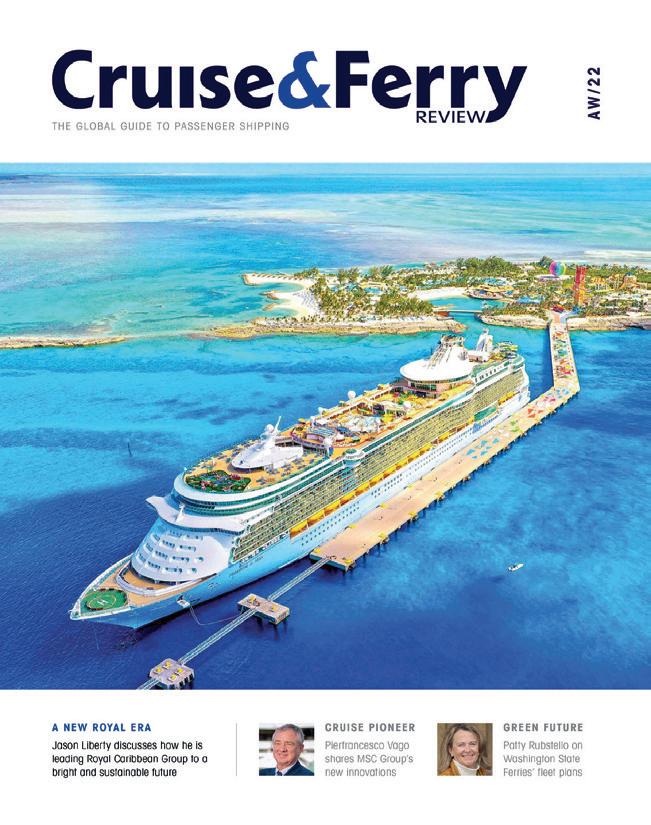




Jackie is an experienced Environmental, Social, Governance (ESG) professional with a history of working in the maritime and infrastructure sector bringing a wealth of knowledge on sustainable development and operations.
With over 15 years’ experience in environment, planning and sustainability management, Jackie is now focused on strategy development and business transformation. With a gift for creating collaborative partnerships, alongside a strong ability to recognise and cultivate the potential in others, Jackie has a proven track record of accelerating organisational sustainability through strategy implementation , communication, and education. During her career Jackie has been responsible for the development of a number of Sustainability Financing Frameworks enabling over $750million of sustainability linked debt to be realised through a series of innovative sustainability financing transactions.
In 2022, Jackie became the founder and Managing Director of boutique ESG advisory company Sustainable ESG (SESG). SESG are focused on supporting organisations navigate the evolving ESG imperative. Helping organisations to understand their current state and develop relevant and tailored strategies that build upon existing foundations.

Jackie sits on the Board for PIANC ANZ, a global not-for-profit body that brings together experts on technical, economic, environmental and planning issues pertaining to waterborne transport and infrastructure and is a former Chair of the Ports Australia Environment Planning and Sustainability Working Group. Jackie also sits on the Mayor of Newcastle’s Sustainable Development Collaborative, an active group focused on localising the United Nations SDGs to the region.
Jackie was responsible for introducing EcoPort to the Oceania region and since 2018 Jackie has advocated for ports to participate in the program with nine ports now part of the network. In her capacity as Managing Director of SESG, Jackie has recently signed an MOU and Statement of Intent with EcoPorts EcoSLC to formally collaborate and further extend the network of participating Ports and Terminals in Oceania.
Chris has worked on Research & Development and Training with the port sector since 1982 specializing in the environmental management of port and shipping operations. He contributed to the development of the EcoPorts tools and methodologies, and is active in their implementation internationally supported by the cooperation between ECOSLC (www.ecoslc. eu), the European Sea ports Organization (ESPO, www.espo.be) and the American Association of Port Authorities (www.aapa-ports.org). He acts as Reviewer of the EcoPorts’ Self-Diagnosis Methodology (SDM).
His training qualifications include qualified certification through the Course Developers Workshop under the UN Train-Sea-Coast Programme, and the LRQA Environmental Management Systems Auditor Training Course, Lloyd’s Register Quality Assurance training Services, which are certified by the International Register of Certificated Auditors (IRCA).
Chris has delivered training courses on a range of environmental issues throughout Europe and in India, Ivory Coast of Africa, Vietnam, Cambodia, Thailand, Laos, Taiwan, Malaysia and Colombia. He was Director of Studies, Marine Geography in the School of Earth and Ocean Sciences, Cardiff University, UK until 2011.

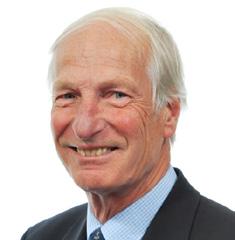 HERMAN JOURNÉE
Chairman ECO Sustainable Logistic Chain Foundation
HERMAN JOURNÉE
Chairman ECO Sustainable Logistic Chain Foundation
Herman Journée initiated in 1996 in Europe the development of the Ecoports Port Environmental Management System, a professional quality management system and standard and the EcoPorts Network for cooperation and sharing good environmental practice. More than 130 European Ports contributed to its realisation. In 2010 he started, the independent non-profit ECOSLC Foundation to introduce Ecoports outside Europe and to introduce sustainable port, transport and logistics chain management. The Foundation is internationally recognized.
DR CHRISTOPHER WOOLDRIDGE Science Coordinator EcoPorts EcoSLC, and Visiting Research Fellow, Cardiff University, UK
Following-on from the UN Climate Change Conference (COP26) and in the continuing shadow of COVID-19, the long-established mantra of ‘sustainable development’ still rings-out daily in political, governmental, industrial and even social media circles. The pressure is building on all stakeholders involved in the logistics chain to deliver ever-more time and cost-effective measures. Options and examples are examined where ports collaborate to achieve progress.
Ports are increasingly challenged to be more advanced and complete in operational procedures, and to bring into fuller use the natural resources available. As ever, the position and role of ports as critically important nodes where the lines and systems of transport networks coalesce brings added responsibilities – and opportunities. The irony, often, seemingly lost in the debate on green issues, is that it is not possible to achieve sustainable development – without development. Phased stages of growth, expansion, progress, improvement and maturity require financial investment, technological innovation, scientific research etc., and clear policies to focus action and drive the programs necessary to achieve targets and deliver targets through good practices. Given the inherent characteristics of the logistics chain, arguably, effective implementation of such policies will only occur through the active collaboration of all stakeholders involved.
This paper examines the evolving changes in port strategies that are leading to re-definition of the role of ports in regional, national and global economy, and the requirement for cooperation in the acquisition and sharing of knowledge and experience. It also identifies the management procedures that have actually been put in place by ports to achieve such policies, and seeks to establish to what extent does collaboration actually deliver evidenced-based environmental protection and sustainable development.
Fundamental to sustainable partnerships in this context is the formation, organization and operation of trustworthy teamwork, partnerships and associations. Port Authorities and their representative organizations are actively involved at all levels from global to local in seeking to deliver sustainable activities and operations to the mutual advantage of all stakeholders involved including supply chain operators, city governance and local communities. Examples of Port sector initiatives at international level and at local are included to demonstrate examples of good practices and the challenges that have been, or are being, experienced.
For more than twenty-five years, ports in Europe have collaborated at various levels to influence and indeed, shape, the sector’s response to the wide range of legislative and regulatory requirements relating to the environment in terms compliance and overall environmental protection. As critically important nodes, through their wide range of activities and operations, ports produce significant income at regional and national scales, provide a wide range of jobs and careers, deliver fundamental components of national and international economic structure and are of course essential to the operation of logistics chains and overall, global transport system. Initiatives related to new investment in capacity increase, and new port developments are on the increase.
‘We’re all in this together’ – collaborating to deliver sustainable development of port operations.
However, there is common recognition that the impacts of the sector’s wide-ranging environmental aspects require explicit management in order to ensure compliance, reduce impact, protect habitats and deliver sustainability. There is increasing pressure on ports to demonstrate and report on their environment in terms of quality, trends and targets.
New strategies are emerging that are leading to an improved design of the port process and the structure of the worldwide interconnected ports and their hinterland corridors. Ports continue to evolve in terms of infrastructure and modus operandi, and at the same time, awareness of both actual and potential environmental impacts arising from aspects (activities, products and services) is growing. Ports are now, demonstrably, re-inventing themselves by introducing new ways of operating leading to substantial reduction of the environmental impact or to zero emissions. Hence, port process innovation that also includes environmental impact reduction is considered as a regular investment of the port’s business. This means that this investment decision will follow the regular checks and balances of any investment decision of a company, including requirements about earn back periods. In this way several impact reduction measures are integrated in the business model as investments and not so much as a separate cost element.
The port process is an important chain of business activities that creates value for society through the buying and selling of goods and services. However, as stated previously, many of the steps of the port process create an impact on the environment. Stakeholder trends indicate that a port’s activities and operations, and those of the associated logistics supply chains are increasingly assessed in terms of environmental, ethical, governance and social impacts. With the growing focus on climate change and overall environmental quality, it is no surprise that sustainability now warrants a key position at the heart of business operations. Investors expect businesses to demonstrate a focus on sustainability, and to be mindful of the U.N. Sustainable Development Goals (SDGs https://sdgs.un.org/goals)). Adopting and implementing a sustainable action strategy as part of the Port’s continuous improvement program can lead to business benefits including cost savings and enhanced reputation that in turn may assist with compliance, attracting investors, reducing waste, improving stakeholder relations and satisfying supply chain requirements. Sustainable development is now arguably the key phrase used by politicians, economists, activists, agencies and planners in terms of addressing Climate Change and the overall aspects of environmental quality.
Sustainability is now a recognized component of a credible Environmental Management System (EMS), the functional organization necessary to deliver environmental protection and sustainable development to the highest possible standards of compliance and accountability. It can support the port’s process management by the introduction of a continuous environmental improvement system. It also delivers other essential elements like risk prevention. This takes several risks for the port on the longer term into consideration, such as climate change, that can have an immediate effect on the continuity of the port’s process operations. It is important to note that ISO 14001:2015 states that its EMS “is intended for use by an organization seeking to manage its environmental responsibilities in a systematic manner that contributes to the environmental pillar of sustainability”. The whole concept of care for habitats, species and environment has evolved from conservation to environmental management, and now it is recognized that the control of environmental impacts caused by the port’s activities, products and services is a fundamental component of Sustainable Development.
As the geographic scale of port-based considerations has grown from quay-side to city, and node to logistics chain, so the sheer number of interested parties has multiplied in terms of
people and organizations with an awareness or concern for the environmental imperative. Port shareholders, those owners of units into which the total wealth of the business is divided, naturally pay keen attention to issues of environmental management and sustainability as cost and risk reduction related to the processes and procedures involved impact on the company’s profits. Nowadays, a stakeholder society has evolved in which a culture has developed within, and around the port, whereby everyone has a stake or involvement in its economic success including ethical considerations such as those identified by the U.N. Sustainable Development Goals. Such stakeholders including clients, suppliers, employees, local communities and governments, but also including financiers of ports have a strong view on the negative environmental reputation of ports, transport, and logistics. Upcoming new financiers of ports, like pension funds and capital investors invest in ports and related infrastructure such as hinterland connections and logistics. They consider it as a prerequisite for their decision to finance ports with their capital that the port has at least an environmental management system and risk prevention in place. A continuous environmental improvement program is becoming a significant component of the whole drive towards sustainability. A well-coordinated, collaborative and systematic approach is needed to protect value creation and at the same time the environment itself.
The company or authority’s business plan and the port’s own hinterland chain transport and logistics are designed and configured to attain targets and deliver profit. To implement and operate such a plan requires effective cooperation between many companies, both large and small, and also have the commitment of personnel at all levels of involvement. Typically, twenty or more companies and governmental organizations may need to act together – hence the need for a collaborative pathway to manage the complex, well-supported by dedicated IT-systems and appropriate technology.
Reducing the environmental impact of the port process is a worldwide challenge for the global sector which is increasingly regulated by a wide range of legislation. Ports may well face at least 200 environmental laws and regulations. In addition, several major organisations, such as the United Nations and International and National, Port Associations, deliver strategies and guidelines for the development and pursuance of the environmental policy of ports. Carefully focussed and methodically prioritised policies are critically important components of Environmental Management Systems specifically designed to assist ports in managing reduction of the environmental impact of port activities and operations and thereby contributing to the effort to achieve sustainability of the commercial profile.
The classic conundrum is, of course, how to close the gap between policy and practice through effective implementation. The port sector has faced a wide range of environmental issues over the years and continues so to do, but experience has shown that a comprehensive framework of credible organizational processes and procedures in the form of a dedicated Environmental Management System facilitates monitoring, reporting and decision-making allowing the Port Authority to deal with changing priorities, incidents and accidents. Depending on circumstances, reactive or proactive programs may be required. Navigating to sustainable development involves dealing with any environmental impacts 24/7 with special focus on high-risk activities and operations in all conditions of weather and tide etc. It also must take into consideration longer term topics such as investment, infrastructure development, change in commercial profile etc.as part of its phased pathway towards sustainability of operations.
It is an appropriate moment, therefore, to recognize the sector’s response to the on-going environmental demands placed upon it by noting, and justifiably celebrating, that it is twentyfive years since the EcoPorts Network was established in 1997 (The same year that the Kyoto Protocol was initiated as an international treaty which extended the 1992 United Nations Framework Convention on Climate Change (UNFCCC) that commits state parties to reduce greenhouse gas emissions, based on the scientific consensus that (part one) global warming is
occurring and (part two) that human-made CO2 emissions are driving it. The Kyoto Protocol was adopted in Kyoto, Japan, 1997 and entered into force on 16 February 2005 (United Nations, 1998). After the Doha Amendment, negotiations were held in the framework of the yearly UNFCCC Climate Change Conferences on measures to be taken after the second commitment period ended in 2020. This resulted in the 2015 adoption of the Paris Agreement, which is a separate instrument under the UNFCCC rather than an amendment of the Kyoto Protoco. Along with the emerging recognition of the need for conservation and the protection of habitats, it is a reminder of the timeliness and appropriateness of the initiative by the sector to respond positively to the challenges of compliance, protection and subsequently, sustainability. The EcoPorts Network, a collaboration between port professionals, academia and research institutes delivered the Self Diagnosis Methodology (SDM) and the International Quality Standard of EMS, the Port Environmental Review System (PERS).
The Self-Diagnosis Method (SDM) is specifically designed to provide guidelines and recommendations for Ports (including, Authorities, Terminals, Companies, Corporations, Concessionaires and other such entities) that wish to achieve, implement, operate and maintain the EcoPorts PERS Environmental Management System that may be certificated to an international standard of recognition by independent review and audit. The SDM serves as a checklist of components that may reasonably be expected in a good practice example of an effective EMS program. Its approach incorporates the ‘Precautionary Principle’, and seeks to assist the Port Authority, Corporation (or Terminal Operator) to demonstrate that it has ‘taken all reasonable steps’ to in order to comply with its environmental liabilities and responsibilities. This contributes to risk prevention policy. The SDM review is configured to assist ports and terminals with a phased development of EMS on a step-by-step basis, and the SWOT analysis (Strengths, Weaknesses, Opportunities and Threats) of its declared provisions and procedures of its Environmental Management Program is configured to give guidance and advice as to what steps the port/terminal may take in order to achieve, or maintain, the international standard of EMS recognition that is PERS. The GAP analysis indicates the Port’s performance relative to the criteria specified by relevant international standards of EMS and thus the port’s responses have been examined and compared with the EcoPorts Port Environmental Review System (PERS), ISO 14001 (2015) and the EU Eco-Management and Audit Scheme (EMAS).
The SDM and its associated pathway leading to the PERS international standard is recognized by ESPO, AAPA, IAPH, WPSP, World Bank (European Investment Bank, and European Bank for Reconstruction & Development), the United Nations Environment Programme (UNEP), the AfricanPorts Association, the Arab Sea Ports Federation, the Taiwan Ports International Corporation (TIPC) and the InterAmerican Committee for Ports (Organization of the American States). Representatives from major insurance companies state that a port’s environmental performance and especially its risk prevention policy is “factored-in” to calculations of premiums; and that standards such as PERS are recognized components of a responsible approach. Such certification may also be a condition for funding to assist port/terminal development. EcoPorts PERS is the only international quality standard of EMS dedicated to the port sector. It recognizes that in terms of geography, hydrography and commercial profile, each port is unique and operates under specific characteristics and circumstances, and yet it sets the criteria within global standards. A strength that may reasonably be claimed by the standard is that although generic for the global standard, it is adaptable to the local circumstance. Contact organisation for ports in Europe is ESPO (www.espo.be) and for ports outside Europe, it is the independent, non-profit ECOSLC Foundation (www.ecoslc.eu)
Figure 1. The growth and distribution of the EcoPorts Network reflects the international perspective required to address the wide range of cross-boundary issues that necessarily must be managed at a global scale. As critically important nodes of transport, Ports can often offer the leadership required to both instigate and operate positive collaborative programs to deal with significant issues at a range of scales of impact (www.ecoslc.eu)
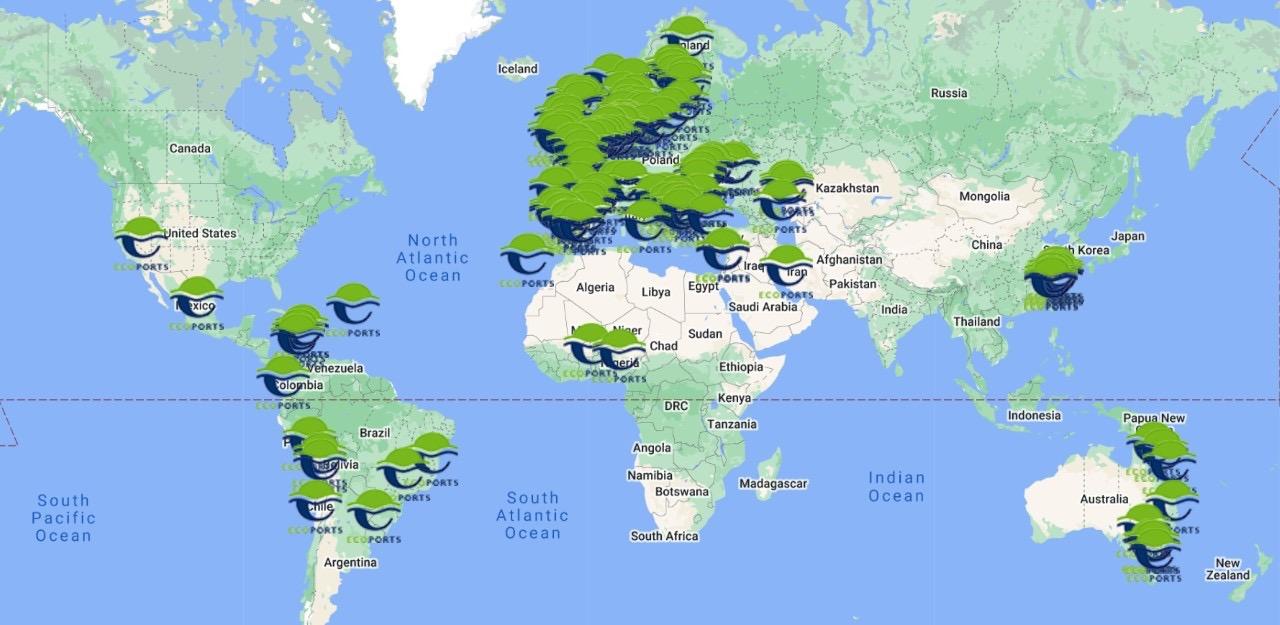
Designed by port professionals – for port professionals, membership of the EcoPorts Network provides the option of a user-friendly pathway towards the phased development and implementation of an effective EMS specifically focussed on compliance, environmental protection and sustainable development. Continuous improvement is an integral part of the process and a requirement of all, credible EMS. As previously stated, the SDM serves as an ‘at-a-glance’ checklist of components that may reasonably be expected in a good practice example of an effective EMS program. Along with the qualifying criteria of PERS, the tool and methodology summarise the key components of an effective EMS, all of which are key considerations in planning and delivering sustainable development of a port’s commercial profile. The components covered include:
Environmental policy Environmental awareness and training
Register of activities, products and services Good practices
Legal requirements Communication
Performance indicators
Emergency planning
Objectives and targets Monitoring
Responsibilities, resources and budget Review and Audit
Conformity review Green services Management organization Environmental reporting
Table 1. The elements and topics included in EcoPorts methodology and international quality standard of EMS.
Guidelines, assistance and the process of network membership are readily available via ESPO and EcoSLC via the websites quoted above. All data and information received and processed by the review and audit procedures are treated in strict confidence. The sum total, anonymous responses provide the basis of baseline and benchmark performance data that is of mutual
advantage to the individual port authorities and their representative organizations in terms of influencing strategic policy and demonstrating competence to comply with legislation on the foundation of voluntary, self-regulation, delivering environmental protection, reducing risks and exhibiting sustainable development – all based on specified criteria and performance indicators.
The positive performance of the sector in terms of cooperation and encouraging collaboration is evidenced by the responses from the combined EcoPorts database (ESPO and EcoSLC input) as follows, where from a sample of 214 ports representing a wide range of sizes, profiles and locations, the following steps are currently part of their EMS:
Is the environmental policy communicated to all Stakeholders? 90.4
Is the environmental policy available on port’s website? 85.1
Does the Policy include reference to Continual improvement? 95.7
Does the Policy include reference to: Protection of the environment? 96.8
Does the Policy include reference to: Reduction of resource consumption? 85.1
Does the Environmental Policy refer to the Paris Agreement, UN’s Sustainable Development Goals or international, regional and local environmental goals? 86.2
Does the Environmental Policy refer to needs and expectations of the relevant port stakeholders? 75.5
Does the Inventory consider GHG emissions? 66.7
Have objectives (relating to GHG and air emissions) been communicated? 81.9
Is funding from the budget allocated to Stakeholder engagement and outreach activities? 62.8
Does the port make an environmental report publicly available (separate or as part of a sustainability report with specific reference to environmental issues)? 68.1
Does the port exchange environmental information with stakeholders (including industry, research institutions and NGOs)? 87.2
Does the Port communicate with Local liaison committees? 55.3
Does the Port communicate by holding ‘Open Days’ for local groups (e.g., families, schools)? 67.2
Has the port identified Environmental Performance Indicators (EPIs) to monitor trends in environmental performance? (e.g., addressing operational performance and impact on environmental condition) 70.4
Table 2 demonstrates the positive competence and preparedness of the port sector to take part in collaborative efforts to tackle major issues related to environmental impact and sustainability.
A collaborative approach in terms of working together to achieve a specific environmental goal or target should be to the mutual advantage of all parties or organizations involved –and to the environment itself. Because of their geography, developmental history, relationship with the city and commercial status, Port Authorities are often in a helpful position to lead such initiatives and to influence outcomes and deliverables. A cooperative approach often brings access to more resources, enhanced recognition, avoidance of political constraints and wider appreciation of both potential, and actual results, all of which assists the pathway to sustainability.
Environmental policies of ports are well-established and easily accessible, with many examples of good practice and compliance-plus in terms of both intent and achievement. Commitment to continuous improvement is a requirement of all, major, EMS and it links naturally with procedures to protect the environment and to reduce the use of resources. The EcoPorts methodology is reviewed every two years to ensure that options and standards are up-to-date with evolving legislation and other, positive initiatives. Hence, reference to, and recognition of the U.N. Sustainable Development Goals, the ever-increasing expectations of stakeholders, and the significance of Green House Gas (GHG) emissions along with associated standards, zones, objectives and reporting are covered in the checklist of good practices. From its inception, the EcoPorts approach was always configured to be practicable and cost-effective, and so funding, reporting and exchanging information are also included in the process. Perhaps, of equal significance is that Port Authorities recognize that environmental management and sustainable development go hand-in-hand, along with the requirement to think globally and act locally – links with local communities are essential.
Ensuring a sustainable growth in port areas requires executing actions that would enhance the environment through the development of social, environmental, and economic strategies, the application of green technology and the development of investments in innovative projects. In this context, collaboration between port stakeholders may be seen as an opportunity to address many of the society’s challenges.
Several examples of port sector collaboration initiatives are provided in this section. They demonstrate the importance of stakeholder collaboration in achieving sustainable development. The examples include the interaction between port authorities, city councils, governments, technological/engineer companies and other port stakeholders. These examples demonstrate that cooperation increases influence and that if ports come together by collaborating on environmental and social issues, the influence applied is higher, and the potential results and benefits are multiplied. By signing agreements of collaboration between port authorities and other parties, it may result in enhanced motivation and commitments, and to be a catalyst for change and modernization of the facilities of the port. When the collaboration is synergic and win-win, the value creation can be multifaceted, involving the economic, social, and environmental dimensions (Le Pennec, et al)
For instance, the ports of Antwerp (Belgium), Bremen (Germany), Hamburg (Germany), Haropa (France) and Rotterdam (the Netherlands) announced, in June 2021, their joint commitment to provide shore power for the largest container vessels by 2028. Onshore power supply is understood to refer to any technology that allows ships to change their power supply from the vessel’s engines to shore-based electricity, with a preference for green electricity. The partners believe that significant steps forward can be taken in the ultra-large container segment, which is said to have the most advanced level of onshore power supply-readiness, but also the highest level of emissions at berth. These ports signed a Memorandum of Understanding and jointly advocate a regulatory framework for the use of shore power or an equivalent alternative. A similar example is seen in the collaboration signed by the three Baltic Sea ports of Stockholm (Sweden), Helsinki (Finland) and Tallinn (Estonia), which agreed to invest in onshore power electricity connections at each port in November 2021. It will ensure that all ferries operating
between Stockholm, Helsinki and Tallinn will soon connect to onshore power. Large numbers of goods and passengers are transported daily between these three ports, and this development will significantly reduce the emission of air pollutants from vessels at the quayside. In January 2022, the Port Authority of Valencia and the City Council of Valencia signed an agreement for the installation of a device for the generation of electrical energy from waves in the Marina of Valencia. Through this agreement, the Port of Valencia grants the City Council the authorisation to occupy the port public domain for the installation of a device for the generation of wave energy. The project is co-financed by the European Commission, which plans to develop an innovative and sustainable technological solution to produce energy by harnessing the action of waves, with great social and environmental repercussions. It is expected that the Wave Energy Converter project will generate around 130,000 KW per year, which will be equivalent to reducing the city’s annual CO? production by 16 tonnes.
The Port of Antwerp, Port of Zeebrugge and the Chilean Ministry of Energy signed a Memorandum of Understanding in November 2021 in which they commit to working together to set up a corridor to ship green hydrogen or derivatives, produced in Chile and received at the Belgian Ports, for further distribution to meet expected demand in Europe. It is expected that this cooperation will eliminate the last barriers and gaps in the run-up to the effective start-up of green production, the set-up of the logistics chain between the continents and the logistics in the Belgian seaports and their hinterland.
The Port of Rotterdam Authority and the Maritime and Port Authority of Singapore signed a Memorandum of Understanding (MoU) to establish the world’s longest Green and Digital Corridor to enable low and zero carbon shipping. Since the two port authorities are among the largest bunkering ports in the world, they agreed to bring together a broad coalition of shippers, fuel suppliers and other companies to collectively work on potential solutions on alternative fuels. Each alternative fuel has its own challenges relating to costs, availability, safety, and restrictions in range due to lower energy density compared to fossil fuels, and for this reason the view of experts is necessary. Beyond alternative fuels, the MoU also aimed to optimise maritime efficiency, safety, and the transparent flow of goods by creating a digital trade lane where relevant data, electronic documentation and standards are shared. In this project also participates the Global Centre for Maritime Decarbonisation and the Mærsk Mc-Kinney Møller Center for Zero-Carbon Shipping as action partners, as well as other industry partners across the supply chain.
It may be seen as a positive attribute of the sector and its associated stakeholders and representatives, that collaborative projects are not only initiated by large ports, but that small ports and their organizations also recognize the merits of teamwork in establishing sustainability of operations. Indeed, it may be argued that small ports are often under-represented in such debates in spite of the significance of their role in the whole transport network. For example, the Aegean Energy & Environment Agency (AEGEA) organized a series of annual, international conferences with a wide range of issues and topics specifically designed to exchange knowledge and information relating to the management of small ports (https://smartports.gr).
Another example is the Skyros Project described as a “golden” collaboration between the Department of Public and Community Health of the School of Public Health of the University of Western Attica with the Department of Environment of the University of the Aegean and the Skyros Port Fund (LT Skyros, NPDD), the Management and Exploitation body of the Port of Skyros. The establishment of the project introduced a new way of practicing environmental education and health education where the training participants also act as citizen educators, promoting responsible environmental behaviour. The port became a tool for environmental awareness and health promotion where, through the program, theory is put into practice in real conditions (skyrosproject.aegean.gr).
A further example of collaboration to mutual advantage at this scale is the AI SMART Project which aims to develop a common port network in the Adriatic-Ionian area based on the concept of “intelligent, green and integrated ports” enabling setting new green routes that
can connect regional small ports in the cross-border countries involved. The project promotes the potentiality of the short sea routes, as integral and complementary part of intermodal TEN-T corridors, for a sustainable and inclusive transport services, in accordance with the objectives of the European 2030 Strategy for intelligent growth based on appreciation of the natural and landscape resources of both coasts and hinterland. The project aims to increase the competitiveness of the regions involved by i) raising the quality of port services provided to users, ii) creating supplementary and advance tourist services that focus on high quality, iii) setting up common port networks for “green, inclusive and sustainable” short-sea corridors, and iv) enhancing awareness of the protection of the local port network in support of the maritime sector.
The port sector has developed, and is applying, appropriate tools and methodologies to assist its endeavours to meet the challenges of environmental protection and sustainable development. Representative organizations and individual authorities are mindful of both the global context and local, stakeholder requirements and expectations in managing the wide range of environmental imperatives. Environmental management is now established as part of the business plan, and the merits of collaboration on several aspects of environmental management to control impact between commercially competitive ports is recognized as a mutually advantageous option. Publicly accessible Environmental Reports and the sector’s own, independently audited EMS quality standard flag its policy of transparency and evidencebased performance both now – and for the future.
ISO (International Organization for Standardization). Environmental Management Systems. Requirements with guidance for use. 2015.
Le Pennec, M.; Raufflet, E. Value Creation in Inter-Organizational Collaboration: An Empirical Study. J. Bus. Ethics 2018, 148, 817–834.
United Nations Framework Convention on Climate Change. Kyoto Protocol to the United Nations Framework. Review of European Community and International Environmental Law. 1998. Available online: https://unfccc. int/resource/docs/convkp/kpeng.pdf. (accessed on 31 August 2022).
United Nations. Paris Agreement. 2015. Available online: https://unfccc.int/sites/default/files/english_ paris_agreement.pdf. (accessed on 31 August 2022).

Head of Planning and Environment, Port of Oslo
Neilson holds a master degree in Geography, and a bachelor degree in Environmental Management. The mix of natural and social sciences is useful since the port’s environmental impact as well as the influence on city development is important in the Oslo Fjord City of Norway.
Come with us on a journey towards zero emission solutions at sea, in port, by rail or road. Are you a frontrunner? Then welcome on-board.
Shipowners tell us it has to be easy to connect no matter which port we are inn. The price to retrofit is too high and the effects are too small. Our study shows the shipping lines can retrofit for ?? Euros and they can reach the IMOs energy efficiency goals by using shore power in a few ports they often visit. There are many container vessels arriving in Oslo, but 15 of them on shore power can reduce more than 90 % of the emissions at the terminal.
In the next two years we want a few retrofitted ships to test our shore power solutions (OPS/ cold ironing) in the Oslofjord. We welcome a dialogue to ensure clean fuels for both sea and road transport in 2025.
We want you - if your company want to connect to shore power solutions, use fossilfree fuels or charge electric terminal equipment. You can test our charging, biogas and perhaps hydrogen fuel for your trucks and take your part in out Green Corridor from Europe to Oslo.
That means all hands on deck and now we want to test our shorepower solutions that already exist but no ships have connected yet. We have a good dialogue with Hamburg and Rotterdam as well.. Same standard solutions, same routine and connection point. We are close, but the solutions must be tested and the dialogue with shipping lines to make sure of high efficiency and easy to connect is of paramount to the ports in the Oslofjord.
We want the frontrunners to test and adjust solutions in cooperation with us. If you get on board now, it is still possible to get funding. If you want to wait until regulations are in place, the prices for retrofitting ships and shore power solutions will increase, and the funding will disappear.
Facts
5
5
2022
5
The seven port authorities use zero emission cars, equipment and working boats already.
The cities demand zero emission building sites and want to regulate local transport towards zero emission solutions by 2030.
Four of seven ports already have shorepower available Discussing av standard solutions with the port in Hamburg and Rotterdam Biogass for transport in two of the seven ports Biofuel (HVO 100) available for trucks in Oslo Electric ferry for roro cargo across the Oslofjord (ASKO between Moss and Horten) 2023 More shore power for bulk and container vessels in Oslo, Borg and Kristiansand Oslo will have charging available for road trucks
5
Four of seven ports may have ships on hydrogen (Oslo, Borg, Larvik og Kristiansand)
5 Electric tug and reach stacker on trial in at least one port (Borg)
5
Oslo expect terminals to use only zero solutions
5 Oslo City want to regulate the transport system so all other than biogass, hydrogen and electric become more expensive
5 Oslo City want all building sites to use zero emission solutions and transport in and out
5 Three of seven ports may produce hydrogen for both ships and trucks (Borg, Kristiansand and Larvik)
5
The green corridor is a combination of sea and land transport
5 Shore power solutions are similar and easy to use in many ports
5 Terminal Equipment, rail, road and river use zero emission fules
The Oslofjord ports are Kristiansand, Grenland, Larvik, Drammen, Oslo, Borg and Moss.

2011 – Today Consultant
BALance Technology Consulting GmbH
Areas of expertise:
International R&D project management
Life cycle performance assessment
Market studies
Business model development
JOULES (2013 – 2017): Joint Operation for Ultra-Low Emission Shipping (FP 7). Responsible for the life cycle performance assessment.
Study on opportunities for strengthening the sustainable competitiveness of the marine equipment industry”, 2014, EUROPEAN COMMISSION - Enterprise and Industry Directorate-General.
Responsible for the statistical market analysis.
Study on New Trends in Globalisation in Shipbuilding and Marine Supplies – Consequences for European Industrial and Trade Policy, 2017, EUROPEAN COMMISSION. Responsible for the shipbuilding supply chain analysis.
STEERER (2019 – 2022): Structuring Towards Zero-Emission Waterborne Transport. Responsible for the development of scenarios with quantified targets for 2030, 2040 2050 towards zeroemission Waterborne transport.
FASTWATER (2020 – 2024): FAST Track to Clean and Carbon-Neutral WATERborne Transport through Gradual Introduction of Methanol Fuel: Developing and Demonstrating an Evolutionary Pathway for Methanol Technology and Take-up (H2020).
Responsible for life cycle performance assessment and business model development. Support of the Project management.
PIONEERS (2021 – 2026): Portable Innovation Open Network for Efficiency and Emission reduction Solutions (H2020).
Responsible for the exploitation and market uptake of PIONEERS PORTable Innovations.
PIONEERS: Four ports with a shared commitment towards the European Green Deal In order to address the challenge for European ports of reducing GHG emissions while remaining competitive, the Ports of Antwerp-Bruges, Barcelona, Venlo and Constanta will implement green port innovation demonstrations across four main pillars: clean energy production and supply, sustainable port design, modal shift and flows optimization, and digital transformation.
PHD program in Climate Change, MSc. Marine Science. Over 19 years of experience in management in commercial, fishing and port environment in the port of Vigo. He has worked in more than sixteen European projects about environment and development in different EU funding programs.
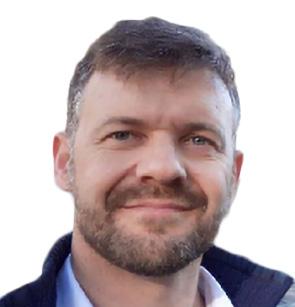
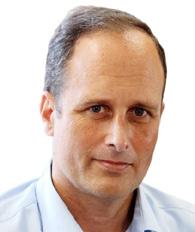
Current duties and responsibilities:
6 Head of Sustainability Department of Port of Vigo.
6 Coordinator of the Ports Pillar of the Atlantic Area European Commission.
6 Member of Climate and Energy Committee of IAPH (International Association of Ports and Harbours) and Chairman of the blue growth network “European Sea Ports Organisation (ESPO)” 2019 - 2022.
GERARDO GONZÁLEZHead of Projects and Works Division, Port of Vigo
Civil Engineer (Meng). He has been working for the port of Vigo for the last 4 years and his previous experience involves working for a major construction company both in Spain and for international projects in Europe, Middle East, and USA. He is currently involved in projects related to coastal and marine infrastructures.
Current duties and responsibilities:
6 Head of projects and Works Division, Port of Vigo.
Environmental technician, Port of Vigo
Degree in Biology, MSc in Ecology and PhD in Marine Ecology (Intertidal Ecology). He has worked at the Port of Vigo for the last 4 years and prior to that work for 8 years in the department for ecology at the University of Vigo.

Current duties and responsibilities:
6 Environmental technician in the Sustainability Department of Port of Vigo.
Environmental technician, Port of Vigo
Degree in Biology, MSc Biology of Organisms and Ecosystems. He has worked at the Port of Vigo for the last 3 years and prior to that work 12 years in the field of environmental management linked to circular economy topics.


Current duties and responsibilities:
6 Environmental technician in the Sustainability Department of Port of Vigo.
Environmental technician, Port of Vigo
Civil Engineer. Before his current position in the Port of Vigo, he has worked as a site manager in the construction of linear infrastructures, urbanizations, and reinforced concrete structures.
Current duties and responsibilities:
6 Infrastructure technician in the projects and Works Division, Port of Vigo.
Sunset docks is the strategy designed by Port of Vigo to improve coastal resilience and portcity integration using Nature Based Solution (NBS). Through innovative projects, progressively, Port Authority moves forward to designing Green Infrastructures. A pilot study has already finished with the collaboration of University of Vigo. It has provided key information regarding to benthic organisms’ colonization in the waterfront. Currently, the second step, called “Living Ports” is under execution. “Living Ports” is funded by the EU and counts with the participation of an international consortium. Finally, all information gathered during each step will be integrate in a large-scale deployment.
Results obtained to date are promising. They push all participants to get high ecological standards in the port area, and to promote and disseminate benefits of ecosystem services in areas affected by industrial activities.
The activities and projects included in the Port of Vigo strategy will contribute significantly to design green infrastructure in coastal areas. In such way, it is expected to provide efficient tools to increase biological connectivity in the littoral and in the areas affected by human activities.
The maritime industry is responsible for transporting around 90% of world trade. Ports and harbours have been transformed during the last decades into essential industrial centres. For this reason, port infrastructures have experienced a significantly expansion. Consequently, the relationship of the port authority with local communities has become an issue more relevant and demanded. Port managers consider essential to establish mechanisms to improve portcity integration. They are focused on actions to couple social and environmental issues with port activity efficiency.
In this scenario, joint strategies involving all stakeholders are essential to improve the coexistence of port activities with social and environmental standards required by citizens.
Located on the bay “Ria de Vigo” NW coast of Spain, Port of Vigo is an excellent natural port sheltered from the ocean. The Ría de Vigo has an exceptional landscape and natural values. The bay is surrounded by the National Park “Illas Atlánticas” and other natural areas protected by Natura 2000 Network. The situation and his natural resources make of this Atlantic location an extremely important zone for artisanal fishing and aquaculture. Both economic activities play a significant role for the local community. The compatibility of the industrial activity and a high environmental status area are a priority for the organization.
Port of Vigo has pioneered in Europe the integral implementation of Blue Growth strategy. An innovative methodology has been developed based on a bottom-up approach. Under this
framework, the port has designed a specific Plan for Vigo based on Blue Economy with its stakeholders. Efforts are conducted to promote competitiveness, efficiency, and sustainability in all the activities, installations, and services
The Blue Growth objectives are grouped in four priority areas: innovative, connected, inclusive and green port. The “green” objective of the Port is an integral programme that includes environmental actions and considers social inclusion. Participatory activities with citizens segmented by age groups are being developed to grow up awareness about the environment protection. In short, the “green goal” is focused on improving the quality life of citizens who live in a city with a Port, as the case of Vigo.
One of the most representative projects of the green working line is “Sunset Docks.” This strategy includes a set of actions to develop innovative practices that allow to achieve sustainable ports. The creation of a marine natural ecosystem in port areas is being studied. The experience tries to protect and increase the biodiversity in the port and pretends to create a CO2 fixation system.
The Sunset Docks strategy aims to transform “grey” infrastructures in the port environment into green infrastructures (structures that evoke natural processes in artificial environments). Project combines the conservation and restoration of ecosystems (ecology) with the planning and design of port infrastructures (engineering). It will contribute to improve the provision of ecosystem services in the port environment and create a CO2 fixation system through the ecoengineering design of artificial structures recreating habitats lost due to port activities.
It seeks to improve port-city integration, creating leisure spaces that will include marine visors and interpretative panels to facilitate the dissemination of marine ecosystems and the largescale implementation of all stages and their follow-up will demonstrate the carbon offset in port infrastructure and the compatibility of port activity with the high quality of the marine ecosystem.
The project is planned on several phases, each of which is key to the next stage: (i) DoorToSea (PuertaAlMar), (ii) Living Ports and (iii) Sunset Docks (last phase). The first two are under execution and financed with European funds. Currently, the Port of Vigo is working on the design of the third phase where the previous developments will be integrated.
DoorToSea was the first stage of the Sunset Docks strategy. It was a pilot action to move forward in the development of green infrastructures inside the port service zone. Simultaneously, a dissemination campaign was performed to show citizens ecosystem services and littoral communities appearing in the port area.
Different type of structures to support marine life have been designed by the University of Vigo. To maximize the increase in biodiversity and carbon sequestration, the researchers use biomimetics, that is, they imitate forms of nature in artificial structures. The model used the calcareous alga Lithothamnion corallioides, one of the main Maërl-3. Maerl beds create a complex, open structure that supports diverse associated communities of red seaweeds and animals. The main purpose was the recolonization of coastal areas affected by industrial activities in the port environment.
The project began in 2019 with the installation of twenty-seven structures under existing piers, designed to maximize the fixation of benthic communities of great ecological richness and to increase the carbon sink in the port area. University of Vigo monitored main biological parameters to characterise organisms’ colonization throughout a year. 181 species have been identified during the entire project.
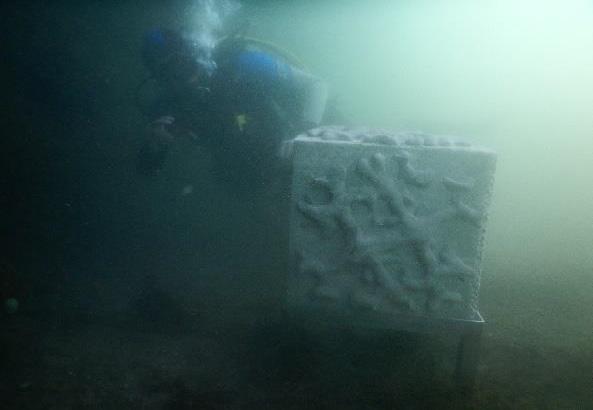
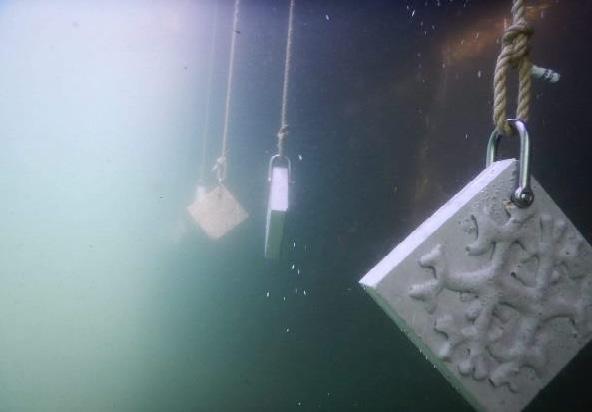

The most abundant groups of organisms in the project were: Polychaeta, Gastropod, Tunicate and Crustacea, with a change over time regarding the number of taxa in each of the groups. Throughout the project, a slight replacement of species was observed, increasing the number of taxa in other groups such as the Echinodermata and decreasing those of Platyhelminthes and Bryozoa. The replacement of species that are more tolerant to disturbances by more sensitive species is indicative of an improvement in the quality of the dock ecosystem.


The carbon captured by the structures was higher to 7 kg.m-2. The output shows that the continued use of artificial structures in port areas would help to increase the carbon capture per square meter of surface area occupied by artificial structures. The results obtained during the monitoring have exceeded expectations, supporting this methodology to recover areas affected by port activities.
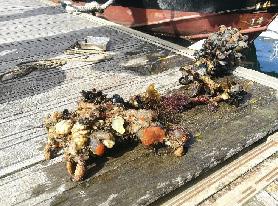


Dissemination and transfer of knowledge was the second aim of the project. Throughout five events, project aims, and results were showed to citizens. An extra effort was done to reach children and professionals of the maritime community. Specific events were performed for each type of attendees. More than 1.000 peoples participated in the workshops, seminars, and port visits. These figures are indicative of the particular interest and concern of the environmental care by citizens.
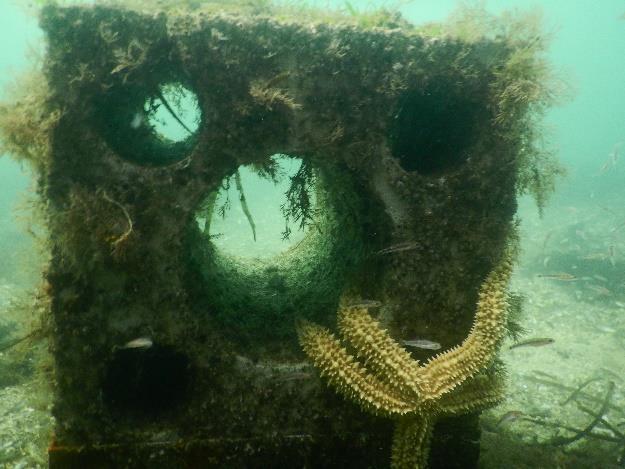
The Living Ports Project is the second step in the Port of Vigo strategy to improve coastal resilience and city-port integration. The Project, funded by the EU program H2020-EICFTI-2018-2020, goes one step further in the design of green infrastructure. Living Ports contemplates the design and installation of specific structures for port walls that facilitates the colonization of fauna and flora, as well as the design and installation of an underwater observatory to disseminate and transfer knowledge about biodiversity and marine life to strengthen environmental values in the city population.
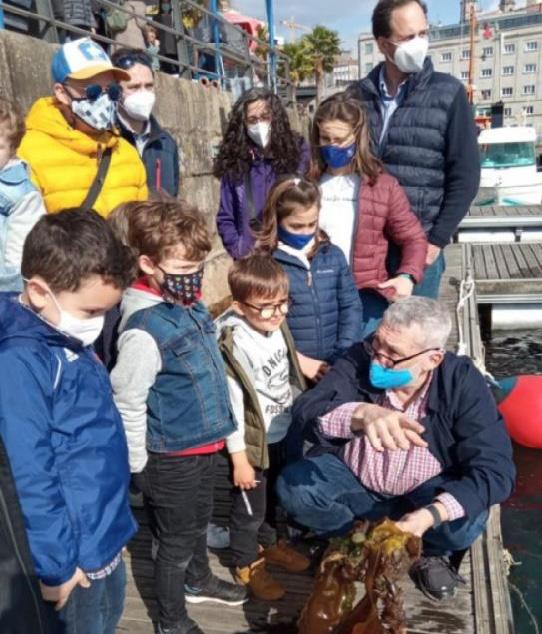
Living Ports project includes the use of the new concrete technology ECOncrete. The sciencebased innovative technology is designed to encourage the development of rich and diverse marine life and natural processes like calcification and photosynthesis (that uptake CO2) as an integral part of CMI (Coastal Marine Infrastructure) such as seawalls, breakwaters, and urban waterfronts, providing high durable, bio-enhancing concrete solutions and Climate change resilience.
The project consortium consists of four partners from three countries: ECOncrete Tech Ltd (Israel) as project coordinator and technology provider for green ICM solutions; Port of Vigo (Spain), one of the greenest ports in Europe and one of the most important in the fishing industry in EU; Cardama shipyard (Spain), a shipbuilding and repair company; and Institutes of Civil Engineering and Aquatic Resources of the Technical University of Denmark (DTU). Living Ports Project has a total duration of 36 months and includes a large-scale installation of ECOncrete technology in two different areas within the Port of Vigo.
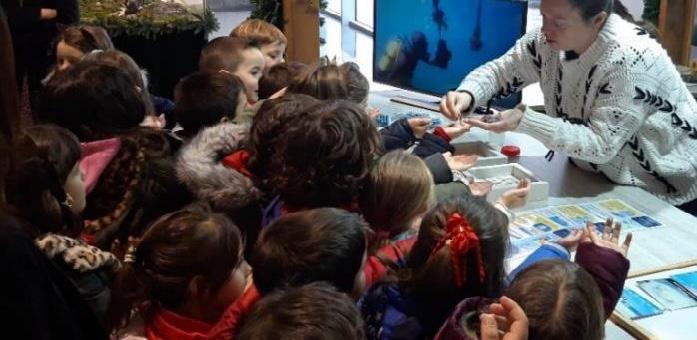
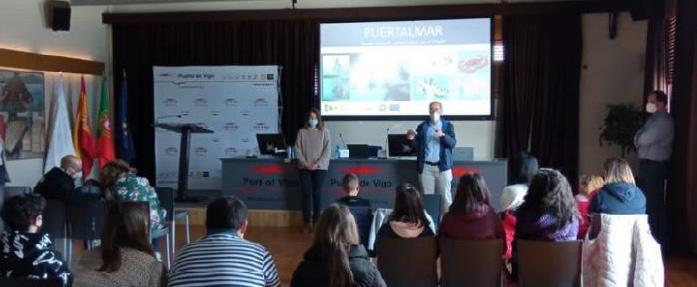
The first site, located in an area with sheltered waters called Portocultura, includes the installation of 310m2 of ECO Seawall type panels with their respective Control areas (made up of standard concrete) and an underwater viewer designed by Cardama. The viewer will serve to observe the existing marine flora and fauna in the Port of Vigo and that will colonize the installed structures. It is an innovative infrastructure for biological monitoring with recreational, informative, and educational purposes for environmental dissemination and environmental values citizen awareness.
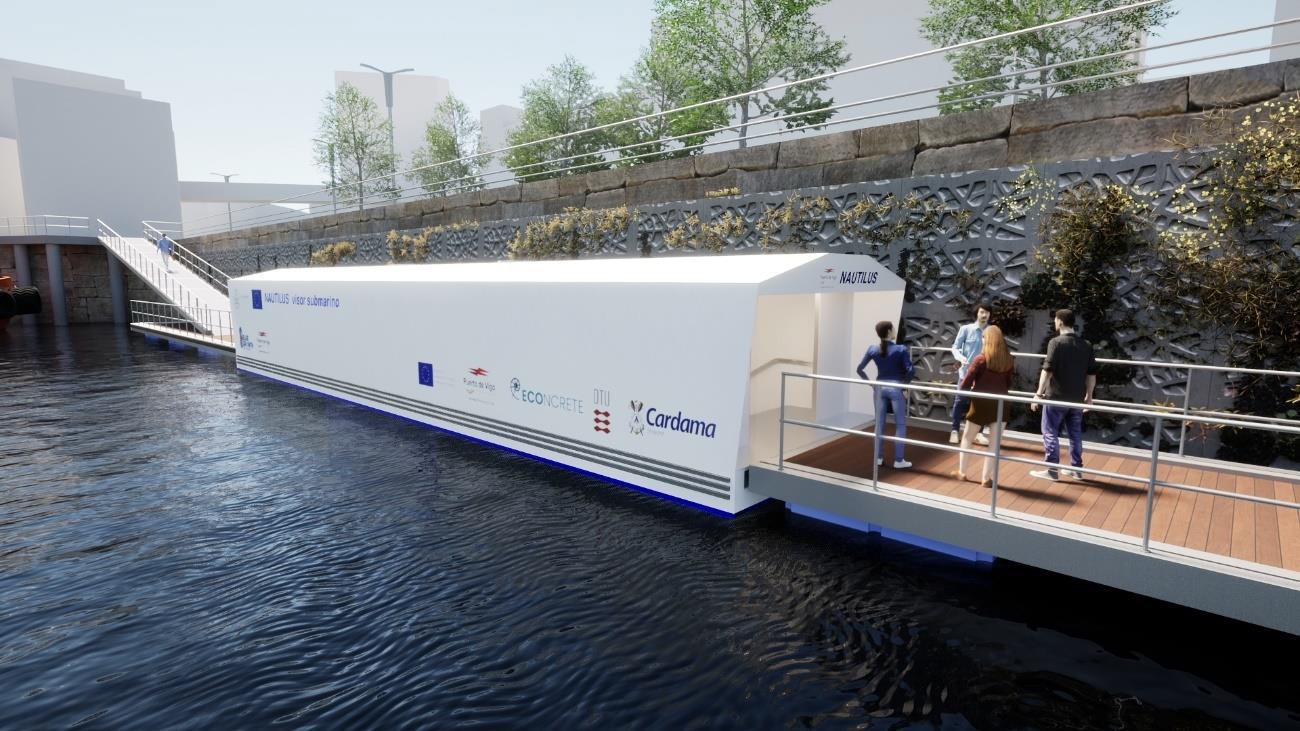
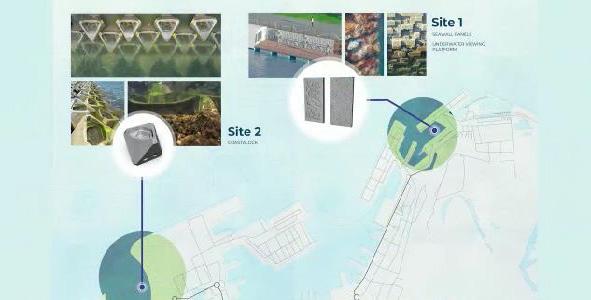 Figure 6. Underwater viewer with ECO Seawall panels.
Figure 6. Underwater viewer with ECO Seawall panels.
The second site is called Bouzas and is in a more exposed area to the waves in front of the mouth of the Ría de Vigo. In this area, one hundred units of CoastaLock will be installed. CoastalLocks are innovative pieces of concrete decorated with ecological-biological principles for the protection of single-layer rip-rap structures. These pieces will be integrated into the existing breakwater slope in the intertidal and submerged zone.
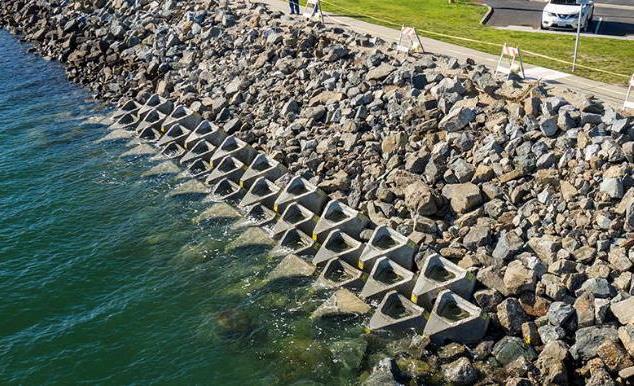
The project includes a 24-month structural and biological monitoring of the pieces installed in both areas. This monitoring will be carried out by DTU. In addition, underwater sound monitoring will be conduct in the areas with and without ECOncrete pieces that will show the impact of this technology and marine life in the port.


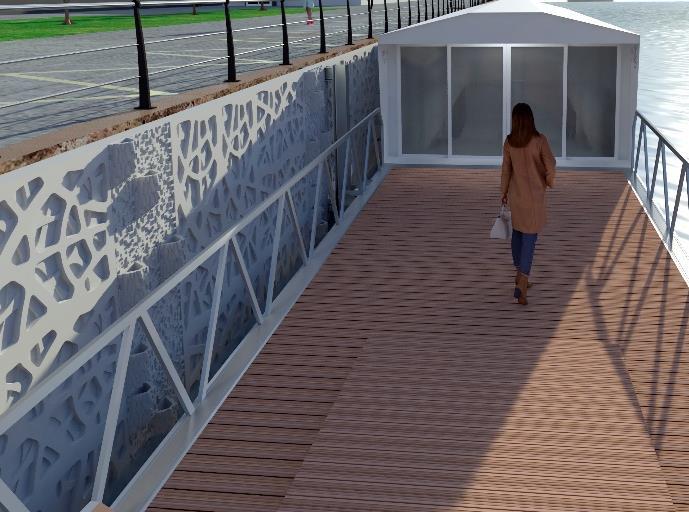
Figure 8. CoastalLock integration in embankment lining and colonization of the pieces. The last stage will integrate the designs and technologies evaluated in the previous phases, including recreational use infrastructures for the dissemination and integration of the port and the city. The large-scale implementation of all stages and their monitoring will demonstrate the important carbon offset in port infrastructure and the compatibility of port activity with a good quality of the marine ecosystem and a sustainable city.
In this way, the intention is to create an ecological reserve of the Port of Vigo that will have artificial reefs and intertidal pools oriented to biodiversity, which will recreate the environmental conditions necessary for the colonization of native fauna and flora. Integrated with these ecosystems, an educational walk area will be created for the enjoyment of citizens. Additionally, the Port of Vigo seeks to promote and enhance the seagrass meadows of the port ecosystem to reduce the pressure on them and carry out practices for their restoration that serve to repower the biodiversity of the area and capture CO2.
The results of activities and projects developed in the Port of Vigo strategy conclude that the implementation of green infrastructures contribute significantly to increase in biodiversity in the port area, to increase in carbon sequestration and the reduction of acidification of the oceans, and reduction of underwater noise caused by the operation of vessel engines during manoeuvres in port.
The implementation of solutions based on nature in the design of green infrastructures also contributes to the compatibility of industrial activities with an optimal ecological state of the waters, to the mitigation of the effects of climate change and to the improvement of resilience in marine ecosystems.
The activities and projects developed in the Port of Vigo constitute a step forward in the improvement of port-city integration. The collaboration and transfer of knowledge between public administration, universities, private companies, and civil society constitute a basic pillar in awareness of the importance about environmental care and in the fight against climate change.
The Port of Vigo has been awarded with the Sustainability awards by the International Association of Ports and Harbours (IAPH) in 2020 with the “Sunset Docks Strategy” in the category of Community Outreach and Port City Dialogue, and in 2022 with the “Living Ports Project” in the category of Sustainable Infrastructures. These acknowledgments emphasize the importance of the use of Nature Based Solutions in the design and implementation of green infrastructures to mitigate climate change effects.
Dries Van Gheluwe obtained a Master in Economic Sciences at the University of Leuven in 2011.
He started his initial employment in the IT Industry, working for Business & Decision in Brussels. After 4 years, he made the shift to the logistics industry. Dries began working for the Antwerp Port Authority in May 2016 as a Coordinator for Business Development, focussing on several projects on both strategic and operational levels.
In June 2018, he moved to the Shipping Lines team, taking on the role of Key Account Manager for the Shortsea business in Antwerp. One of the main goals in his current role is to increase the shortsea network, attracting more shippers and forwarders making the shift to this mode of transport.


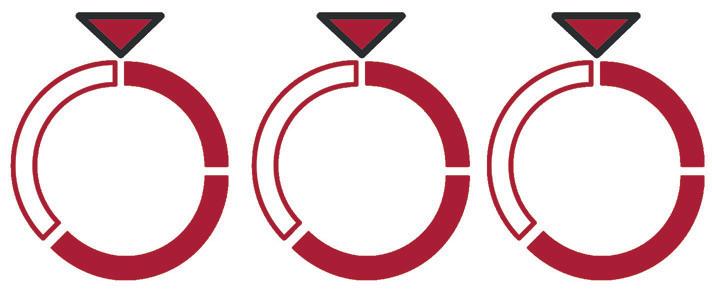
Valter Selén joined ESPO as senior policy advisor for sustainable development in June 2020, having previously worked with drafting the first annual EU MRV Report during his time in the European Commission (DG CLIMA). Valter dedicates his career to EU climate policy and sustainable development, focusing his attention on the maritime sector.
Valter holds a double-degree Master in European Governance from the University of Utrecht, The Netherlands and Konstanz University, Germany. Valter wrote his thesis on how European business associations gain access to EU institutions in order to influence climate policy negotiations.

Senior Policy Advisor Sustainable Development, Cruise and Ferry Network, EcoPorts Coordinator - ESPO
Technical Advisor, Climate, Marine fuels, Innovation, Funding, VDR
As Technical Advisor at German Shipowners’ Association, Sebastian Ebbing provides profound technical expertise to the ongoing regulatory developments on EU and IMO-Level. With his background in nautical science, marine engineering and international maritime management he is dedicated on regulatory climate-protection affairs, the maritime energy transition incl. the development of alternative climate-neutral fuel strategies, digitalization and innovation projects in shipping. Sebastian Ebbing´s technical expertise is accompanied by experience in fleet performance management within a globally operating shipping company.
The German Shipowners’ Association (VDR) is a leading professional association within the German business community. It was founded in 1907 by the regional shipowners’ associations in order to enable them to have common and uniform representation of their interests. Today, the VDR represents the German maritime shipping segment not only in Berlin and Bonn, but also in Brussels, London, Geneva and at global level. With its over 150 member companies from different shipping sectors, the association represents the German shipping industry, which currently boasts the world’s fifth-largest merchant fleet. As an employers’ association, it conducts collective bargaining and social partner negotiations.
Sebastian Ebbing is founding and board member of the “Research Institute for Innovation and Sustainable Logistics” situated at Jade University of Applied Science, where he is lecturing on Maritime Technologies with special focus on climate neutral shipping and alternative propulsion technologies.

Edvard Molitor is the Head of Sustainability in Port of Gothenburg, Scandinavia’s largest port and one of the leading ports of the world in environmental matters. Mr Molitor leads the strategic environmental management at the Gothenburg Port Authority and is responsible for the sustainable development of the port through successful implementation of environmental permits and international requirements.
From 2017 to 2020, Mr Molitor chaired the Sustainable Development Committee of the European SeaPorts Organisation and from 2020 onwards, he is the vice chairman of the Climate & Energy Committee of the International Association of Ports and Harbors.
Mr Molitor has a wide international experience of environmental management, sustainable development, maritime operations, and marine pollution response, and holds a M.Sc. degree in Aquatic and Environmental Engineering from Uppsala University. Mr Molitor has previously worked at SSPA Sweden AB, at the European Maritime Safety Agency (EMSA) and at the Swedish Coast Guard Headquarters.
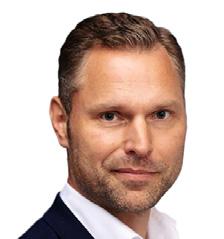

Minas Papadakis is the CEO of the Port of Heraklion since January 2020. Minas joined the port after a long career in the financial sector and has held various executive positions at EFG Eurobank Equities, were he served as head of private clients amongst others. He has served as a member of the Board of Directors for Minoan Lines and A.Papadakis-Technometal.
Minas holds an MBA from the Management School of Imperial College, London University and a degree in chemical engineering from the Aristotle University of Thessaloniki. He has taught Project Management and Financial Management at the Technical Chamber of Greece, North College and the Hellenic Management Association.
He is fluent in English and German.

























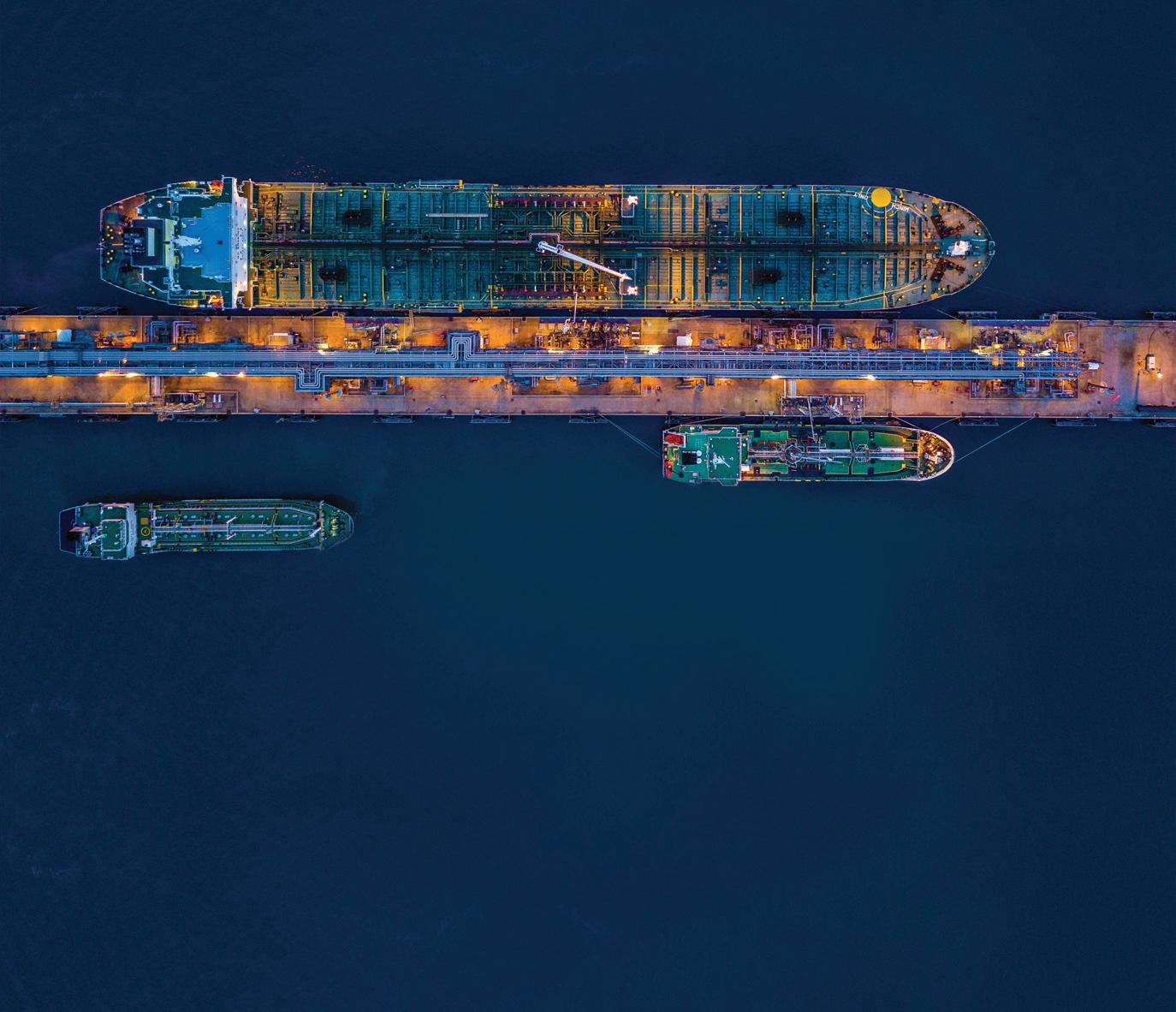




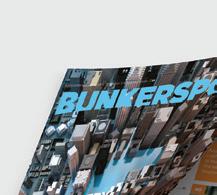
Secretary General, Federation of European Private Port Companies and Terminals
Lamia KERDJOUDJ-BELKAID is the Secretary General of FEPORT, the Federation of European Private Port Companies and Terminals since March 2014. She has a professional experience of more than 20 years during which she held different positions within the maritime and logistics sector.
Among others, she has been for more than seven year the Public Affairs manager of the French Shipowners’ Organization and had the opportunity to work on the three ERIKA Packages as well as on Port packages 1 and 2. Between 2009 and 2012, she has also been appointed as a senior expert and advisor in the framework of several European projects financed by different General Directorates of the European Commission.
Besides her professional experience acquired within trade associations and thanks to her interactions with EU institutions, Lamia KERDJOUDJ-BELKAID has worked for more than ten (10) years for private companies and corporations (among others Capmarine, Budd SA, CATRAM, EGIS) and has been in charge of consulting and business development assignments. In 2009, she has created her own company, a consultancy specialized in strategy and international development.
Lamia KERDJOUDJ-BELKAID holds different Master Degrees in shipping, transport and logistics, British Literature and Applied Psychology. In 2008, she obtained an Executive MBA from ESSEC and Mannheim Business Schools.

Valter Selén joined ESPO as senior policy advisor for sustainable development in June 2020, having previously worked with drafting the first annual EU MRV Report during his time in the European Commission (DG CLIMA). Valter dedicates his career to EU climate policy and sustainable development, focusing his attention on the maritime sector.
Valter holds a double-degree Master in European Governance from the University of Utrecht, The Netherlands and Konstanz University, Germany. Valter wrote his thesis on how European business associations gain access to EU institutions in order to influence climate policy negotiations.

Dr Antonis Michail is an engineer in background with specialisation on the environmental management of ports and freight transport systems at Master and PhD level, and with more than 15 years of professional experience in these fields. Since February 2018, Antonis joined the World Ports Sustainability Program (WPSP) of the International Association of Ports and Harbours (IAPH) as the person responsible for the technical developments and projects under the umbrella of the program. Before that, Antonis was holding the position of Senior Policy Advisor on sustainability and safety matters at the European Sea Ports Organisation (ESPO) from 2009 to 2017. Since back in 2003, Antonis was involved in the EcoPorts network of ports from various posts, including managing projects and coordinating the network’s activities and development until 2017.

The intervention will focus on the IAPH initiatives on the decarbonisation of ports and shipping. Delegates will be informed on the current political process at IMO MEPC and the views and contribution of the world ports to key topics regarding the energy transition of shipping. The proactive work under the umbrella of the IAPH Technical Committee on Climate and Energy will be presented and discussed. Participants will be informed on the newest developments in the Environmental Ship Index and Clean Marine Fuels IAPH working groups, as well as on the links between IAPH and major ongoing decarbonisation initiatives such as the Getting to Zero Coalition, the Global Maritime Forum, Mission Innovation, Clean Energy Ministerial, Clean Energy Marine Hubs and more. Finally a progress outlook of the World Ports Sustainability Program will be presented and discussed with the participants.
Jackie is an experienced Environmental, Social, Governance (ESG) professional with a history of working in the maritime and infrastructure sector bringing a wealth of knowledge on sustainable development and operations.
With over 15 years’ experience in environment, planning and sustainability management, Jackie is now focused on strategy development and business transformation. With a gift for creating collaborative partnerships, alongside a strong ability to recognise and cultivate the potential in others, Jackie has a proven track record of accelerating organisational sustainability through strategy implementation , communication, and education. During her career Jackie has been responsible for the development of a number of Sustainability Financing Frameworks enabling over $750million of sustainability linked debt to be realised through a series of innovative sustainability financing transactions.
In 2022, Jackie became the founder and Managing Director of boutique ESG advisory company Sustainable ESG (SESG). SESG are focused on supporting organisations navigate the evolving ESG imperative. Helping organisations to understand their current state and develop relevant and tailored strategies that build upon existing foundations.

Jackie sits on the Board for PIANC ANZ, a global not-for-profit body that brings together experts on technical, economic, environmental and planning issues pertaining to waterborne transport and infrastructure and is a former Chair of the Ports Australia Environment Planning and Sustainability Working Group. Jackie also sits on the Mayor of Newcastle’s Sustainable Development Collaborative, an active group focused on localising the United Nations SDGs to the region.
Jackie was responsible for introducing EcoPort to the Oceania region and since 2018 Jackie has advocated for ports to participate in the program with nine ports now part of the network. In her capacity as Managing Director of SESG, Jackie has recently signed an MOU and Statement of Intent with EcoPorts EcoSLC to formally collaborate and further extend the network of participating Ports and Terminals in Oceania.
Megan Turner has worked at the port for 4.5 years and covers all aspects of environment and sustainability. During this time, she has been responsible for conducting all aspects of the Port’s extensive monitoring programme, calculating the Port’s carbon footprint, delivering the Port’s Air Quality Strategy, maintaining accreditation to ISO 14001 and is responsible for environmental compliance.

Environment Advisor, Port of Dover

Ben Crake has been at the port for 2 years. He has maintained the Port’s environmental monitoring programme, produced the Port’s third climate change adaptation report and is responsible for the Port’s waste management and compliance. He is now assessing and gathering data on the Port’s scope 3 emissions inventory in preparation for the Port’s 2030 net zero target.
The Port of Dover is the closest UK port to mainland Europe, enabling it to operate up to 120 ferry movements per day carrying up to 11 million passengers, 2.1 million cars and 2.4 million trucks annually (2019). With sailings every 36 minutes the port can support just-in-time supply chains across the nation, handling around £144 billion of trade and is responsible for 33% of all UK-EU trade.
The Port of Dover is located on the Kent coast backed by the White Cliffs of Dover. A range of marine and terrestrial habitats are present in the locality, on a range of substrates, both natural and man-made. Some of the key features in and around the Port are vegetated shingle beaches, rocky foreshore, sea walls/coastal defences, a chalk stream river and chalk cliffs topped by chalk grassland. There are various protected areas in close proximity to the Port such as the Dover to Deal and Dover to Folkestone Marine Conservation Zones (MCZ), Kent Downs Area of Outstanding Natural Beauty (AONB), Sites of Special Scientific Interest (SSSI), Special Areas of Conservation (SAC) and heritage coastline.
The Port of Dover’s environmental monitoring programme was established in 1992 to measure environmental quality across a wide range of natural and artificially created habitats, within and immediately outside of the Port. This provides an understanding of the habitats and species present within the Port of Dover’s jurisdiction. It allows an appropriate level of protection to be implemented when undertaking operations and developments. Weekly, quarterly, and biannual monitoring draws attention to changes in spatial and temporal trends, which may be a result of natural or anthropogenic factors.
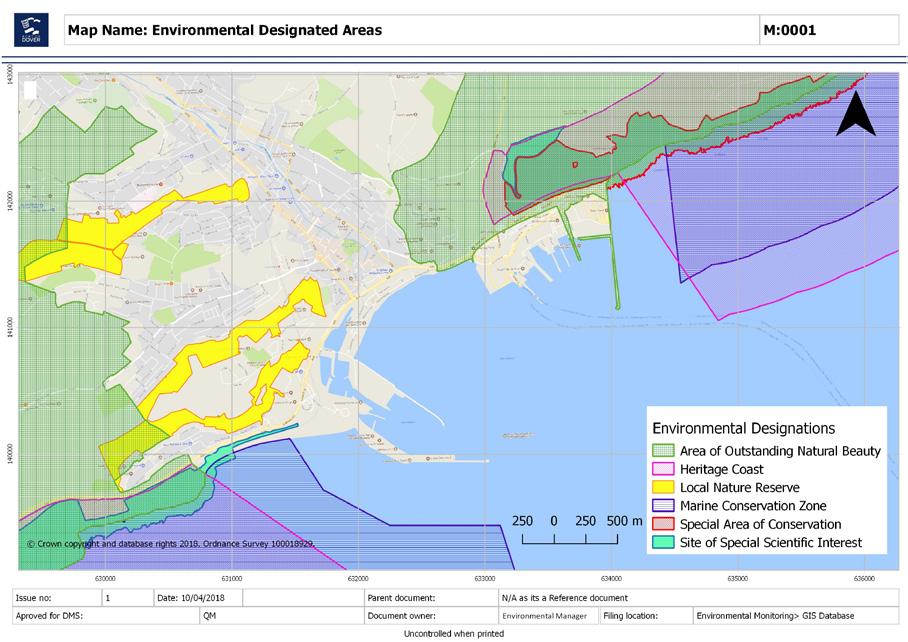
The Port of Dover has also been monitoring its carbon footprint since 2007 and has had a target since then to reduce their emissions by 5% year on year. In May 2022 the Port also announced 3 highly ambitious targets:
Carbon Net Zero by 2025 (Scope 1 and 2)
Carbon Net Zero by 2030 (Scope 1, 2 and defined Scope 3)
Beyond 2030, to create a green corridor.

To fully encompass the marine ecology found within Dover Harbour a range of surveys are undertaken, these include monitoring algae, pelagic and benthic environments. The port also undertakes littoral surveys within the two MCZ’s surrounding the harbour to ascertain that Port is having no detrimental impact on these protected areas.
sampling is carried out using a 10 foot Beam Trawl with shrimp net cod end, at a tow speed of between 2 and 3 knots following 6 predetermined trawl lines (Figure 2). Once the trawl is retrieved, the samples are placed into seawater buckets where they are identified, counted, measured and returned to the sea as quickly as possible. This data is then inputted

Benthic fauna monitoring is carried out using a grab sampling technique. A Van veen Grab is set up on the Port’s survey vessel, the Diana. A sample of mud is collected at each of the 10 benthic sample sites (Figure 2). To ensure efficiency and not to disturb port operations, a maximum of three attempts are made at each site. Once ashore, the sediment properties are recorded, and the samples are rinsed through 2mm and 1mm sieves. All live fauna are removed and placed in seawater filled pots. Samples are taken back to the lab to be identified, counted, measured and added to a database.

Twice a year, a littoral survey recording the intertidal flora and fauna population surveys of Shakespeare Beach, Shakespeare Cliffs and Langdon Bay (locations within the 2 neighbouring MCZ’s) are undertaken by consultants alongside the Port of Dover. The survey consists of a semiselective quadrat-based survey along a set transect at three sites, recording the frequency of fauna and percentage cover of flora.
A quarterly algae survey is also conducted at 12 sites in the harbour (Figure 2). Photographs of predetermined sample areas are taken and printed out. Surface coverage of algae is then calculated and compared to previous months and years. The presence of algae is an important indicator for a healthy ecosystem, and so regular monitoring enables us to assess our harbours health. The Port is also currently investigating a suitable alternative and more robust survey to go alongside this algae survey.
The Port also maintains a marine mammal log. This collates all marine mammal sightings from staff members around the port and maps out the sightings using GIS software. This log enables the Port to monitor the effects daily operations have on local marine mammals.
Water Quality is monitored across a range of sites within the Harbour (figure 2) on a biannual basis, in February and August. The Port does this alongside specialist contractors to allow for extensive laboratory analysis of the water samples. The laboratory test the water samples for Temperature, pH, Salinity, Dissolved Oxygen, Total Coliforms, Faecal Coliforms, Streptococci, Salmonella, Ammonia and Suspended Solids.
The port also conducts corresponding Quanti-Tray analysis at the same sites to test for Total coliforms, E.coli and Enterococci. This sampling is also undertaken on an adhoc basis as required.
Total coliforms are bacteria found in faecal matter but can also be found in a variety of nonsanitary significant sources such as soil. It is therefore used as a conservative risk management tool. Faecal coliforms are a subset of the coliform bacteria group that are thermo-tolerant. Most of the thermo-tolerant coliforms are linked with faecal contamination therefore giving a more absolute but not definite indication of the presence of pathogens. E. coli is the pathogen that the coliform tests are used to indicate. Its presence gives a high certainty of faecal contamination but does not allow the source to be identified. Salmonella is also a pathogen but is only tested on a qualitative not quantitative basis i.e. present/not present. Faecal streptococci are found abundantly in the faeces of warm-blooded animals. Different species excrete varying proportions of faecal coliforms to faecal streptococci which allows the source of the pollution to be identifiable. An FC: FS ratio of greater than 4 indicates fresh human faeces and less than 0.6 indicates animal faeces. Enterococci are a subset of faecal streptococci. It is used as a more specific indicator of sanitary quality. The physio-chemical parameters that are most indicative of sewage pollution are ammonia and suspended solids.
Sampling is conducted on the ports survey vessel, the Diana, a niskin bottle is lowered, just below the surface of the water (the most likely area of contamination) away from the stern of the boat to reduce water disruption. Samples are then collected from this bottle at each site and are sent to the external laboratory and analysed at the ports in house lab.
Two samples are taken at each site and quanti-tray defined substrate techniques are used to determine the most probable number (MPN) of each bacteria type within a 100ml sample. Reagents are added to each sample before being placed within a quanti-tray, one reagent (Colilert-18) will detect coliforms and E.coli and the second reagent (Enterolert – E) will detect Enterococci. The Enterolert samples are incubated for 24 hours at 41oC and the Colilert samples are incubated for 22 hours at 36oC. Once the Colilert samples have been removed from the incubator the number of wells that have turned yellow can be used on MPN tables to calculate the MPN (The number within the matrix which coincides with the correct column for large and small wells is the MPN). The same sample is then placed in a UV light box and the number of wells that are yellow as well as fluorescent can also be used on MPN table to calculate the MPN. For Enterolert samples the number of wells that are fluorescent when placed within the UV light box can again be used against MPN tables to calculate the MPN.
Alongside this sampling the Port also undertakes voluntary Bathing water Sampling at Dover Beach weekly between May and September, in line with the updated standards from the 2005 Bathing Water Directive. Although Dover Beach is not a designated bathing beach it is often used for swimming, so the port undertakes this sampling to assure swimmers the quality of water within the harbour is good. This sampling is undertaken by a contractor to achieve accredited laboratory results. These results are shared on the noticeboards on the seafront weekly.
One of the reasons the port carries out such extensive water quality sampling along the river and in the harbour is that the river that feeds into the harbour, via one of the Ports marinas, travels through an urban area. To aid in local council lobbying for cleaning up this river and to support the community, the port undertakes biannual sampling at 13 locations along the River Dour. These samples are analysed using the same quanti-tray defined substrate technology as the samples within the harbour. This data is shared with the Environment Agency and the River Dour Partnership following each survey.
In line with the Port’s dredged material disposal licence sediment sampling is conducted every 3 years. The sampling is undertaken by the Environment team using the Van veen grab, all samples are frozen before being sent to an accredited laboratory for analysis. The Port tests for; particle size distribution, Arsenic, Cadmium, Chromium, Copper, Mercury, Nickel, Lead, Zinc, Dibutyltine (DBT), Tributyltin (TBT), 21 specific Polyaromatic Hydrocarbons (PAH’s) and 25 specific Polychlorinated biphenyls (PCB’s).
The Port undertakes visual monitoring of the ferry’s quarterly, comparing against the Ringlemann Scale, this is completed from the time they are first visible for entry to the port until they are no longer visible after exiting the port. The Port is also currently investigating a suitable alternative and more robust survey to go alongside this air survey.
As well as this, in 2020 the Port developed an Air Quality Strategy that is publicly available. This document includes an atmospheric emissions inventory, which quantified emissions associated with port related activities and then created an Air Quality Action Plan to tackle these emissions, over short, medium and long term time scales. This plan will be revisited in 2023 to update emissions inventories as well as update the action plan to demonstrate both actions already taken and new actions the port plans to take to tackle our air emissions.
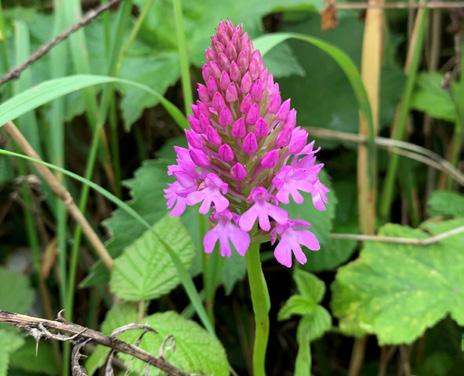
The Port records the richness and abundance of flora at sixteen sites across the estate. For each of these sites a predetermined number of quadrats are decided. A 1m2 quadrat is placed randomly within the sample area and all flora within are identified and their percentage cover estimated.
The Port also designed and created a seafront wildlife area in 2010 to enhance and promote the coastal vegetated shingle habitat. Vegetated shingle is a Natural England UK Biodiversity Action Plan priority habitat as it is rare and valuable for wildlife. The wildlife area is managed by promoting natural colonisation and allowing wild plants to self-seed with the aim of encouraging a natural balance of plants that will provide food and shelter for a range of species. To do this seed heads and dead material is left in-situ to provide overwintering opportunities for insects and birds.? This dead material is removed in spring to make way for new growth. This area is also monitored as part of our annual flora survey.
Ornithological surveys are conducted on both the eastern and western docks, four times a month, throughout the whole year. A set route is followed each time and birds are identified and have their location and behaviour noted. During the breeding season, breeding behaviour is also recorded. The Port is home to many protected species such as Peregrine falcons (Falco peregrinus), Black Redstarts (Phoenicurus ochruros), Purple Sandpipers (Calidris maritima) and Ringed Plover (Charadrius hiaticula), these bird surveys help us to monitor their numbers and work with local bird groups to protect these species.

The Port has been monitoring it’s carbon footprint since 2007. We collect all of our scope 1 and 2 emissions from various sources, using source data wherever possible, and use UK government conversion factors to convert the raw data into Kg CO2e. Data is collected monthly to enable us to closely monitor and analyse trends in the data and gives us the ability to immediately address any sudden spikes or changes in emissions, as opposed to waiting for an annual report.
At the end of each year this data is summarised annually for internal distribution and an SECR report (Streamlined Energy and Carbon reporting) is included within the Port’s public annual report.
Long term monitoring of our emissions has enabled us to easily identify our most polluting sources and put measures in place to reduce them. Examples of this include the introduction of 1.3MW of solar production on site in 2020 and our recent switch to Hydrotreated Vegetable Oil (HVO) for all landside generators and mobile plant in March 2022 and all port vessels in September 2022. This has seen a 98% reduction in carbon emissions when compared to the gas oil we used previously.
Figure 6 – Graph showing Ports reduction of CO2e emissions since 2007.

We have now begun thinking about our 2030 target and looking for ways to fully gather and analyse our scope 3 data. This has involved engaging with our suppliers and waste contractors as well as investigated the full Well-to-Wake/Wheel emissions for all fuels the port currently burns.
The extensive monitoring undertaken allows the Port to make informed decisions during project planning as well as evidence the impact we are having on the environment and work towards solutions that will reduce this. This sampling also helps the port to demonstrate the good environmental health within dover Harbour. All of this data is made publicly available either via SECR reports for carbon information or within the Port’s Environmental Monitoring Report that can be found on the website and is updated annually.
Paul Martin is a Master Mariner and holds a post graduate diploma in Maritime Energy from the World Maritime University. He is currently the Managing Director of Maritime (Europe and W.Africa), at ABL, and although he is mainly engaged in maritime casualties on behalf of insurers and lawyers, he has overseen and driven the creation of an online portal that allows ports to calculate and track their emissions.

PAUL MARTIN Director of Maritime, AqualisBraemar LOC
Ports are an inextricable part of the shipping value chain, and contributors to the maritime sector’s overall emissions. The components of a port’s emissions can be from different sources including inter alia commercial vessels, harbour craft, cargo handling equipment, road, rail, and building infrastructure.
Ports are coming under more pressure from stakeholders such as the local community to decarbonise, and market based measures (tax on CO2e emissions) is a very real possibility in the not too distant future.
As the spotlight on port emissions intensify, their environmental credentials may influence the ability to obtain funding from banks for Capex projects. However before a port can examine how to reduce emissions, it needs to understand what those emissions are and where they came from.
This article considers Shoreham Port on the south coast of the UK, a certified EcoPort, where sustainability is a key driver in decision making. It is important to note that figures shown of emissions totals for Shoreham Port contain a combination of some real measured data and a large part of example data, and therefore do not represent the actual environmental impact of the port’s activities.
Calculating and tracking emissions holds great value for an environmentally conscious port like Shoreham, as it allows for educated decision making when balancing costs with opportunities to reduce emissions. Shoreham firmly believe that being able to track their emissions through a dynamic portal will ultimately help them reach their end goal of modelling the environmental impacts of future business decisions.
In 2014, 70% of all port calls were in Asia and Europe (22% Europe, 48% Asia), yet the emissions only made up 58% of the world total of CO2 emissions from port calls. In addition, European ports had lower emissions of Oxides of Sulphur (SOx) (5% of global totals) and Particulate Matter (PM) (7% of global totals) than their share of port calls (22%) which is probably due to EU regulations which restrict the levels of sulphur content in fuels for ships in defined low emission areas.
(https://www.itf-oecd.org/sites/default/files/docs/dp201420.pdf)
Information on the % of emissions in port other than from ships, is sparse and hard to find. However in general terms, most emissions in ports can be attributed to shipping (upwards of 70%). Trucks and locomotives can represent up to 20%, whereas emissions from equipment rarely exceed 15%.
For Shoreham Port, around 63% of ships’ emissions are produced while they are at berth. In total, 6% of all shipping CO2 emissions in the EU occur when ships are at berth.
Figure 1 – CO2 Emissions from Shipping in the European Union

The burning of fossil fuels, results in emissions which can be categorised into one of two types - greenhouse gases and pollutants.
i) Greenhouse Gases (GHG)
Greenhouse gases absorb thermal energy which increase atmospheric temperatures, leading to global warming. The main GHG areCarbon dioxide (CO2) Methane (CH4) Nitrous Oxide (N2O)
When measuring greenhouse gases, methane and nitrous oxide are converted into units of CO2 equivalent (CO2e). It should be noted that methane has 25 times the equivalence by weight of methane and nitrous oxide has 298 times. Therefore small quantities of these gases can add significantly to a port’s total CO2e figure.
ii) Pollutants
Whilst the problem of GHGs is well known, the effect on health from pollutants cannot be ignored. Pollutants are bad for humans to breath and can lead to respiratory issues and other negative effects such as acid rain. The main pollutants areOxides of Nitrogen (NOx) Oxides of Sulphur (SOx) Particulate Matter (PM10 and PM2.5) Carbon Monoxide (CO)
Other emissions that are sometimes overlooked areDust Odours Noise
GHGs are categorised into one of 3 “scopes” as per the Greenhouse Gas Protocol, which was created to facilitate the corporate reporting of emissions.
Scope 1, are direct emissions from owned or controlled sources – in the case of a port, for example, harbour owned craft and vehicles.
Scope 2, are indirect emissions from the generation of purchased electricity – for example, for buildings and street lights.
Scope 3, are all other indirect emissions from the port – for example emissions from cargo handling equipment used by port tenants and crucially, ships, with 85% of these emissions attributable to bulk, container, and oil vessels.
Although “Scopes” were designed for use with GHGs, the same principal can be applied to the categorisation of pollutants. Whilst scope 1 and 2 emissions may be something which the port can directly alter, scope 3 is always more difficult to deal with.
There are a myriad of differing and sometimes conflicting regulations. Regulations to control emissions can be on a local, regional, national, or supranational scale.
In shipping, the initial IMO Greenhouse Strategy was created with the aim to reduce CO2 emissions per transport by 40% by 2030 and 70% by 2050. The overall aim was to reduce total GHG emissions by 50% by 2050 compared to 2008 totals.
The EU Emissions Trading System (EU ETS) provides a system for companies to trade CO2 emissions rights based on a market price per tonne of CO2. It is an example of a “market based measure”.
The European Commission (EC) plan to include maritime transport in the EU ETS at an undetermined date between 2024 – 2027. Current proposals state that vessels > 5,000 GT will initially be included, and the feasibility and cost-effectiveness of adding emissions for vessels > 400 GT will be examined by the EU Parliament and Council by December 2026. By this date the EC are to also present a report regarding the feasibility of including additional greenhouse gas emissions into the EU ETS, although it is unclear whether the CO2 totals will already be recorded as CO2e and therefore including other GHGs. Under the EU ETS, 100% of emissions will be included from intra-EU voyages and 50% included where voyages are to/from a nonMember state.
The EU Monitoring, Reporting and Verification Regulation 2015/757 entered force in 2015 and must be complied by all ships carrying either people or cargo to or from EU ports. This regulation provides requirements for the monitoring, reporting and verification of CO2 emissions of all vessels > 5,000 GT, and an assessment of whether to extend this to vessels > 400 GT will take place by December 2024. Methane and Nitrous Oxides will be included from 1st January 2024. Whilst these regulations do not impact ports directly, it is not difficult to imagine that their scope will be increased in order to include ports in the future.
The first step in measuring emissions in a port is to define a boundary of where emissions are produced. Wherever the port chooses to set its boundary, emissions therein should be calculated and recorded.
Figure 2 – Boundary of Responsibility for the Port of Shoreham (red dotted line).
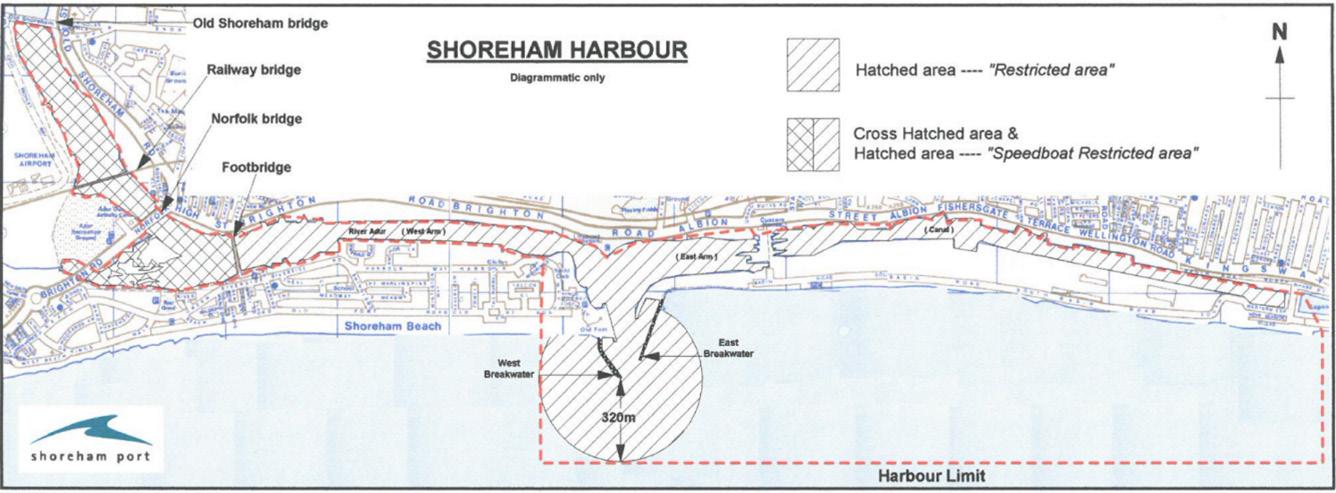
Examining the boundary of a port is an illuminating exercise as it can highlight emissions that are difficult to influence. For example, within the boundary for the port of Shoreham there is a public road, which will be adding to the port’s Scope 3 emissions, and for which there is no obvious solution for the reduction thereof.
‘Sniffers’ can be used to measure the air quality in the port area, but these will only give the levels of emissions and not the sources of them. Additionally, these are prone to pick up emissions produced by sources outside of the port boundary.
A more accurate way to measure emissions is to identify all emitters in a port boundary, track their usage, and then calculate the GHGs and pollutants using information such as engine power, fuel consumption, and an “emission factor”.
The required consumption data can be fed into formulae in order to calculate the concomitant emissions. These calculations will convert the energy used by a piece of machinery, into emissions which can then be cumulatively recorded.
The formula for calculating emissions are given in the Port Emissions Toolkit (https://glomeep. imo.org/wp-content/uploads/2018/10/port-emissions-toolkit-g1-online.pdf).
Figure 3 shows two example equations used to calculate vessel engine emissions. Similar equations can be found in the toolkit for other equipment in a port.

Therefore, to perform the necessary calculations required, the port must not only collate the energy consumption of all its inventory but also the maximum engine powers, appropriate emission factors, fuel correction factors and load factors for each vehicle, vessel, piece of equipment etc.. With a complete inventory of emitting assets, a port can accurately calculate their total emissions and also identify the biggest sources of each type of emission. This level of detail is crucial when determining appropriate steps to take in reducing emissions as every port is unique and there is no one size fits all solution.
After defining the port boundary, the first step is to create an inventory of all sources of emissions and to categorise them by scope. At Shoreham Port the inventory was as follows -
- Scope 1 (direct emissions): building gas, port owned cargo handling equipment, harbour craft, on-road vehicles
- Scope 2 (indirect emissions): building electricity, streetlights, electric equipment, electric vehicles

- Scope 3 (indirect emissions from tenants): tenants’ electricity, tenants’ cargo handling equipment, fishing vessels, seagoing ships, electric and non-electric vehicles
This first step in creating an inventory can also present the first problem! Many ports, especially small ports, do not have dedicated environmental managers and it can be difficult for port managers to find the time to focus on what is a time-consuming exercise.
The second problem is searching for data that may not yet be recorded such as fuel consumption of equipment for example. Furthermore, tenants can be resistant to collecting and providing information, which will need time and effort on their part, with no perceived obvious gain. In fact, reducing emissions can be directly related to reducing energy use which can represent a monetary saving. Data from several UK ports has shown that the biggest contributor to a port’s emissions can often (but not always) be ships (Scope 3). As far as this data is concerned, ports may not be tracking ship movements in a meaningful way, and most probably do not collect fuel
consumption figures or details of auxiliary engines on board which will be needed in order to calculate their emissions. Tracking of ships’ emissions is further complicated by the 3 phases of a port call - passage, manoeuvring, & hotelling; assumptions will need to be made for power use for each phase.
However, once data is collected, then calculations can be made. This cannot be a one-off exercise, and it is important to continually track and calculate emissions so that trends can be identified, and the effectiveness of any implemented initiative can be monitored.
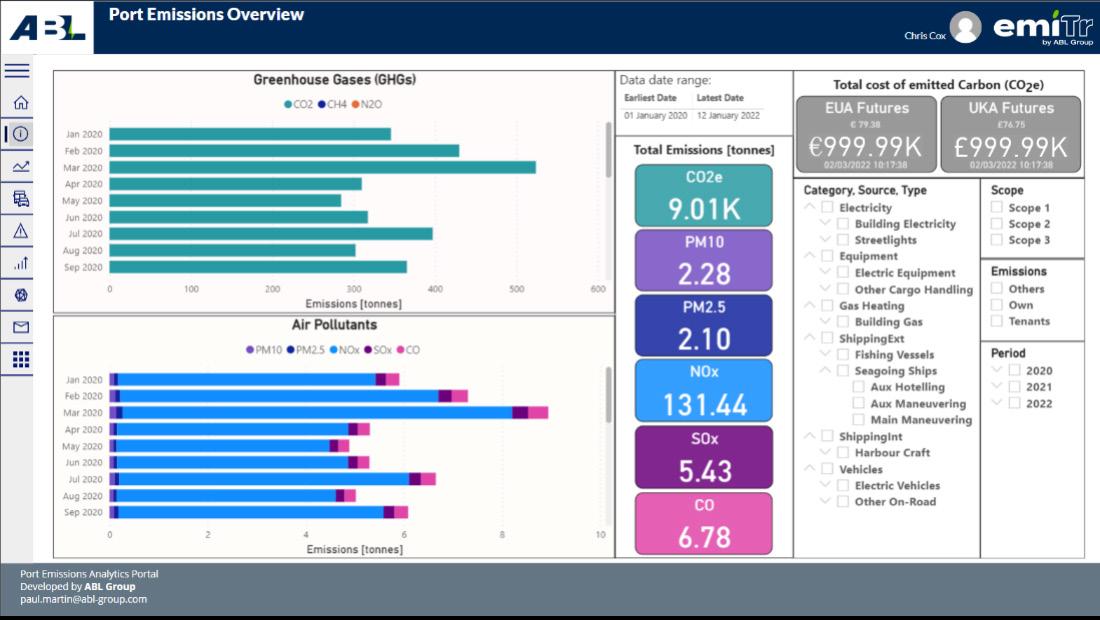
Shoreham Port collected data from gas bills, electricity bills, fuel or electricity usage by vehicles, equipment and vessels. For visiting vessels, their date and time of entry and exit into the port is recorded and the engine data is obtained from subscription based maritime databases. Collection of data is an ongoing process, particularly for cargo handling equipment operated by tenants.
Once fuel consumption and energy usage of all the port’s inventory has been collected, it is also necessary to conduct research to find the appropriate emissions factors and fuel correction factors. These can be found in documents such as the Port Emissions Toolkit or government supplied data, such as the UK government’s GHG Conversion Factors for Company Reporting figures. The most accurate source of emissions factors for fuel-based road vehicles in the UK are MOT tests, where the emissions are measured as part of the test. Keeping a history of the emission factors for vehicles will allow a port to detect deterioration in their emissions over time and help when deciding when vehicles should be replaced.
An emission tracking portal can allow users to enter the energy usage of all of a port’s emitters. The portal can be programmed with the formula such that when usage data is entered, then the emissions are automatically calculated based on the emissions factors and formulae. The results can then be accessed online as interactive charts and filtered by emission source, scope, & date, whether port owned or 3rd party assets.
The monetary value of the CO2e emissions based on carbon credit schemes such as the EU’s ETS, can also be shown to give an indication of the kind of costs a port may face if marketbased measures are implemented in the future.
Each type of emission can be interrogated to view the sources thereof. Date-based graphs allow users to identify trends and, over time, these can be used to illustrate the effectiveness of implemented emission reduction strategies.
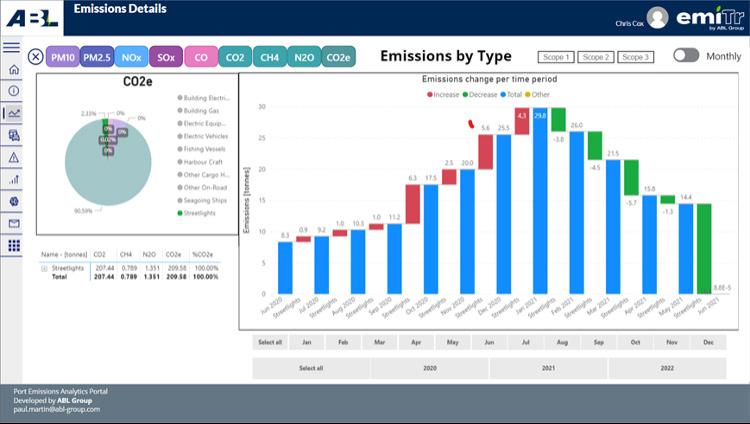
A full asset list can also be viewed, with the emissions of each item displayed. This gives the port sufficient granularity in their results to identify specific sources of high emissions and the ability to monitor particular pieces of equipment in detail.
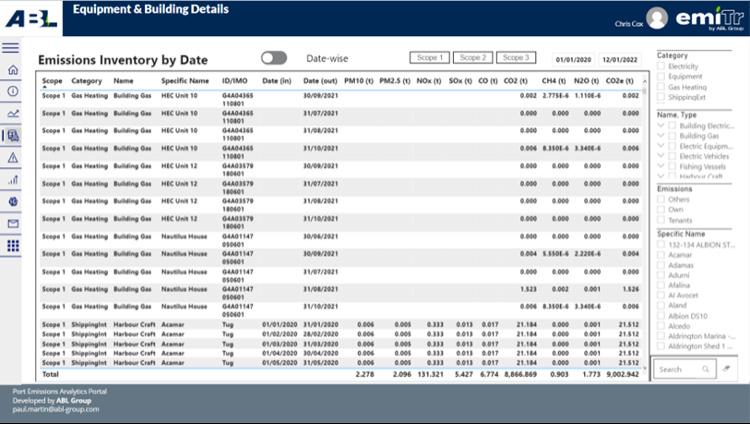
A portal architecture as shown here can also allow for modelling the impacts of potential emission reduction strategies, by showing a direct comparison between the actual calculated emissions and the estimated emissions with one or more strategies implemented. Combined with the knowledge of costings for each strategy, this can prove to be an invaluable tool for ports when making CAPEX decisions and identifying the biggest bang for their buck.
There is a lot of work involved to locate and process the data required. As with many ports, emissions were not previously recorded and so setting up the inventory of emitters was a timeconsuming task.
Once the inventory was created, then obtaining the usage details was similarly time consuming. The port of Shoreham has many tenanted buildings and this meant asking each tenant to sift through invoices, and extract consumption figures which required asking a lot of people for their time and help.
When addressing data from tenants & from different departments, Tenants may not see any tangible benefits to installing a fuel management system for example, which would allow them to inform the port about their equipment’s fuel consumption. Although there are currently some rudimentary systems for recording fuel usage, they do not provide sufficiently detailed data - e.g. tracking activity hours for cargo handling equipment, electricity usage for charging points only and not specific vehicles.
The data for all of the vessels’ engine data needs to be collected. There is a choice between extracting data from online subscription services, or else a system of collecting data directly from ships in port needs to be instigated.
An opportunity for automation was identified in regards to automatically detecting seagoing vessel movements in the port using AIS (automatic identification system). Once implemented, this functionality will log and process AIS data in the port and identify whether vessels are in transit, manoeuvring or at berth, saving a vast amount of time for staff at Shoreham.
Obtaining the correct emission factors is not easy and there is no single repository of emission factors. There may even be issues with emission factors from the port’s electricity supplier which counts biomass as zero carbon emissions; the assertion is that biomass (wood pellets which are burnt) are carbon neutral on the basis that the CO2 released is offset by the take up of CO2 from trees which are planted to replace those that are cut down. However biomass releases more CO2 per unit of energy than coal or gas, and many in the scientific community are concerned about the credentials of biomass.
Whilst over time the portal is going to be invaluable, some data will be easier to input monthly (e.g. electricity usage) and other data such as car mileage is easier to input on an annual basis. This means that the data may look out of kilter at way points until year end when all data is entered.
Once the data for a year has been collected and processed, this will form the baseline for the port against which improvements can be measured.
How the results are shared or promulgated comes down to the port itself. Local communities around the port will surely be interested to see if pollutants from a port are increasing or decreasing, and ports will likely be keen to show their dedication to reducing emissions. Shoreham have yet to decide how best to utilise the information gathered so far.
The next step after calculating emissions is key – how to reduce them. The results should help in making informed decisions on appropriate emission reduction strategies to implement, with specific sources of high emissions made visible along with any low hanging fruit to target first. Many emission reduction strategies are expensive to implement (shore power, for instance, has only been implemented at ports in the UK with the help of government funding), and so being able to identify the most cost-effective and environmentally beneficial solutions is critical and can only be reliably achieved with a full emissions breakdown.
Once emissions are tracked and calculated, the port will need to take action to reduce them. The ability to change their emission profile will vary from “control”, “influence”, or “appreciate”, depending on which scope the emissions are – direct emissions are within the port’s “control”, but it will only be able to “appreciate” the emissions from the public road that runs through Shoreham for example.
As far as action is concerned, there are some promising solutions but they all require varying degrees of investment -
1) Digitalisation of the maritime value chain can allow just in time arrival of vessels to port. This cuts out unnecessary emissions in a port domain that are created when a vessel has to wait at anchor for a berth. It also has the beneficial corollary of reducing emissions en-route - remembering that there is a cubic relationship between speed and power (and ergo the amount of fuel used at higher speeds); lower speed equals lower emissions. For a port with larger vessels than Shoreham, this would be a key system to introduce.
2) Make shore power (cold ironing) available to vessels. Whilst ostensibly shore power makes sense, the cost of installation, maintenance and operator training is not insignificant. For Shoreham Port, this would not be suitable to implement as the vessels that call at Shoreham are usually only at berth for a short period of time; an efficiency-driven model which proves popular with ship owners. Whilst shore power is effective at removing emissions from the period of a port call when the vessel is alongside, it will not remove emissions during the transit phase of the call.
3) Energy efficient ship handling. Whilst not a new concept, this is not a widespread practice and training of pilots and crews in this respect is not common. With an estimated 37% of ship emissions being produced during transit at Shoreham, this could potentially be a relatively low-cost strategy to adopt, especially when the emissions at berth cannot be targeted with shore power. However, access to most berths at Shoreham is via a lock, which by default requires slow speeds on approach.
4) Electric harbour vessels, vehicles and equipment – Ports can reduce their scope 1 and 2 emissions by electrifying their inventory and install their own renewable energy sources. The installation of a micro grid to route electricity generated within the port, can help to become a standalone infrastructure from the national electrical grid, or at least cover a portion of their energy needs. Shoreham Port have already introduced charging points for electric vehicles (for both staff and port vehicles), and also have an onshore wind farm and solar panels which produces a portion of the electricity consumed. The wind turbines alone save 160 tonnes of CO2 emissions annually.
5) Alternative fuels – Liquid natural gas (LNG) is made up of 85-95% methane and offers a 23% cut in GHG emissions over oil-based marine fuels. However, up to 2% of the fuel will remain unburned and be released into the atmosphere. This sideeffect is known as ‘methane slip’ as a large proportion of the released gas is methane. Biofuels offer another alternative, with EU fuel standards counting carbon emissions as being net zero from them due to the carbon absorption during growth. However, if they are not sourced sustainably then this can be considered a form of greenwashing and actually have a net-negative impact due to deforestation. Shoreham are already using Gas-to-Liquid (GTL) and are using the portal to monitor its benefits.
There is an inextricable link between ports and maritime emissions.
Although currently there is no legislation that directly requires ports to reduce their emissions, market-based measures are just around the corner in the EU, and no doubt elsewhere will follow in time. If the market-based measures are reinvested in the necessary infrastructure, then progress towards emission reduction can be made.
A web-based portal can be used to create an inventory of emitters within a port and allow for tracking and the identification of trends and the results of emission reduction initiatives. This can not only help a port to become proactive in reducing emissions, but also make the process of calculating emissions a simpler and faster process. The results can be used for a multitude of purposes, including corporate reporting and for aiding in CAPEX decisions when choosing appropriate emission reduction strategies for the port. Being able to model environmental impacts of potential new assets/practices and display the results as graphical reports is invaluable when balancing costs with environmental sustainability.
Emissions from shipping and ergo ports, can be expected to grow if the predicted growth in world trade is correct. Whilst there is a myriad of ever changing international, national and local legislation that produce increasing targets for emissions reduction, it is incumbent of ports to understand their emissions. This is a time-consuming exercise that should be started as soon as possible.

As an environmental expert within the team of Environmental Sciences of Port of AntwerpBruges I mainly work on the topic of air. Topics such as the nitrogen problem, emission modelling, carbon footprinting, multifuel projects like the realisation of the methanol and hydrogen tugboat and managing the network of iNoses are things I deal with on a daily basis.
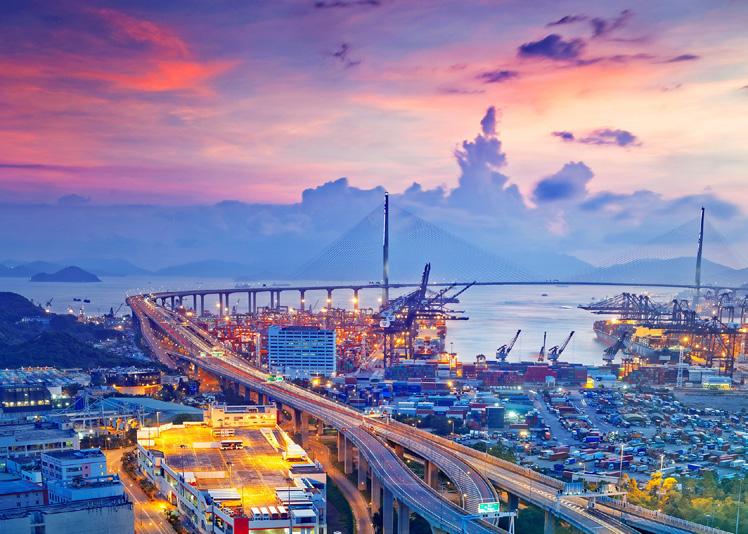



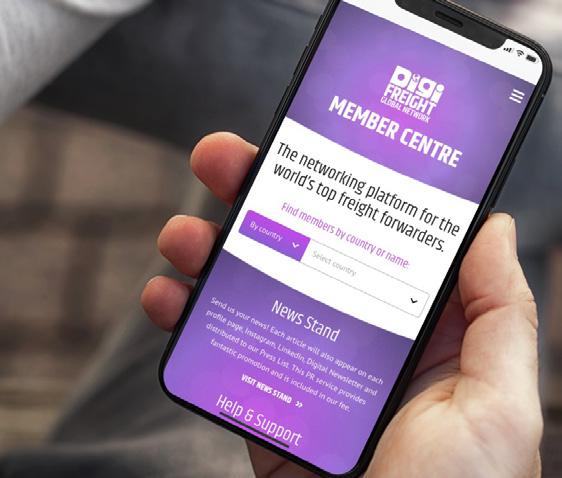


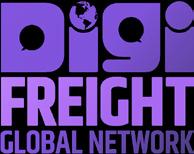


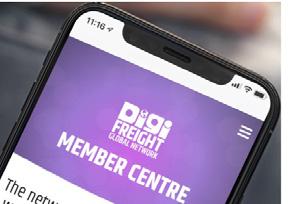
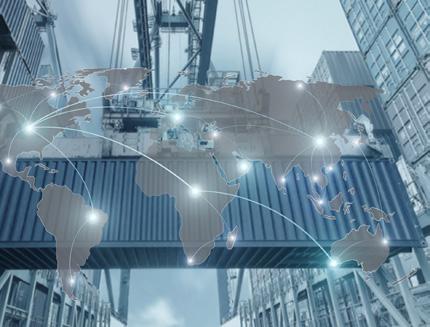

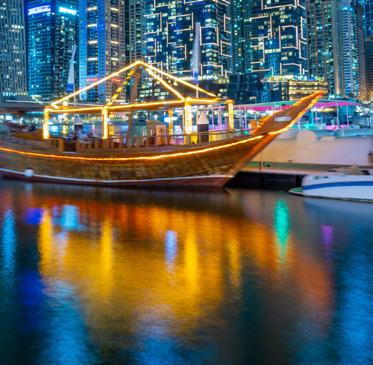
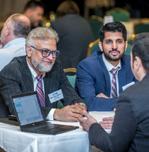

Brent Perry is the CEO of Shift Clean Energy and a marine battery industry pioneer. Perry defined an industry when he oversaw development of the world’s first battery for marine propulsion. Energy storage systems are now a major – and increasingly important – player on the global marine energy scene. In the years since that first battery, he has become a world expert on lithium energy storage in marine applications. His 30-year history in commercial shipbuilding and deep knowledge of energy systems gives him a unique perspective on the hybrid and electric marine industry.
Shift Clean Energy unlocks the potential of clean energy through leading-edge energy storage systems.
The company’s pioneering innovation is making low and zeroemissions operations a reality for the maritime and heavy industry. Shift’s solutions provide its global customers a safe, reliable, affordable way to electrify and reduce GHG emissions.


5 70% of global marine emissions occur in coastal areas; 60-90% while ships are berthing in ports.
5 ~60,000 deaths are associated with ship exhaust worldwide[1].
5 Fully electrifying or hybridising vessels or on-land projects can save up to 80% in operating costs.
5 For a single electric ship, that’s equivalent to 1,560 tons of emissions saved each year.
5 Switching from diesel to electricity pays for moving to zero emission on day one.
5 With PwrSwäp, battery e-Pods can be charged on-shore or off-shore, significantly reducing downtime and loss of productivity.
Shift Clean Energy (Shift) has launched a climate action solution that empowers customers to move to a zero emissions model – with zero cost outlay.
Shift’s PwrSwäp service is a practical pay-as-you-go service?based on swappable battery e-Pods providing customers clean energy, with more reliability?and?less risk. The solution integrates energy storage system (ESS) and renewable energy for commercial maritime applications to electrify ports, terminals, inland waterways, industrial sites and even entire communities, through full electrification or hybridisation.
As an accompaniment to Brent Perry’s presentation, the below outlines the market-changing PwrSwäp solution, its decarbonising capabilities on a multi-system level, and the central benefits it provides to owners and operators, the industry, and the public.
Pressure is building for the maritime and marine energy industries to reduce their carbon footprint. With new EU targets and ongoing efforts by the IMO to see change in the shipping sector, one of the largest emitters on the planet.
What’s more, governments and investors are increasingly concerned over environmental, social and governance (ESG) commitments being met, resulting in ports and terminals moving aptly to decarbonise.
However, owners, operators, and other sector leaders are facing three core (and crucial) challenges in their need to reduce emissions:
1. the market is overwhelmed with potential solutions, all of which boast differing benefits and considerations;
2. the investment to implement many of these is significant, and can require mass infrastructure changes or retrofits; and
3. the ROI rates can be low, or require long-term operational success in order to see a substantial return.
Underpinning all of this is the concern shared by many that knowing which solution to implement, when and how seems nearly impossible, and securing the results needed is far from a certainty.
Yet failure can not only set back a company’s GHG emissions goals (as well as many other business objectives), but it could go as far as cripple an organisation.
Shift’s PWRSwäp aims to tackle each of these three core challenges, as well as additional needs and concerns when it comes to cleaner energy solutions.
A full-spectrum, multi-system solution, PwrSwäp has a range of capabilities.
Unlike others available on the market, the ESS technology drastically reduces common blockers to adopting electric solutions and batteries, such as size, cost, weight and importantly, charging time.
Moreover, because of the adaptability of the model, Shift envisions a future where the technology is easily accessible not only to the maritime and marine sectors, but to other modes of transport, reducing emissions across the global supply chain.
ESS and charging stations are at the core of PwrSwäp.
Where many ESS solutions fail in their capabilities due to charging time, or inaccessible charging links, Shift has supported this at its foundation. E-Pods can be charged either at an onshore station, or off-shore on the vessel itself. They can also be easily swapped within a matter of minutes – drastically reducing downtime. A huge benefit for vessels such as ferries which make frequent, shorter journeys.
When low or ‘out’, the depleted battery can be recharged slowly at the docking station, avoiding the degradation caused by rapid charging, meaning it can easily, safely and efficiently be re-used, and ultimately, supporting sustainable efforts to minimise material waste.

Moreover, Shift can set up shared technology such as charging stations that help lower costs even more. The company harnesses wind power by turning turbines into battery chargers, and the technology has the ability to integrate other renewable energy sources, with charging coming either from the grid or from a renewable energy sources built for the purpose, such as offshore wind, solar or others.
The model is hugely cost-effective – a central benefit when many other ‘green’ solutions require significant infrastructure, retrofits, investment or all of the above.

As customers pay a baseline subscription service fee, and then simply the electricity on a payas-you-go basis, there’s no need to pay for more than the energy purchased – not the e-Pod battery or station – meaning no capex is needed.
See this side-by-side of a traditional onboard system, and a cartridge battery.
Shift’s market-leading safety credentials, testing and standards is what drives PwrSwäp.
The solution is based on the safest and most reliable technology available today, and has successfully passed the following ESS testing procedures:
5 A60 Testing. Through rigorous testing, it was determined that Shift’s batteries would not contribute its energy to the intensity of an existing fire of over 1,000 degrees Celsius for at least 1 hour, and would continue to function should a fire occur in one of the cells.
5 DNV GL Type Approval Certificate. Across nine separate, successful tests, Shift was an early adopter of the DNV GL revised certification, which substantially mitigates the risk of a fire spreading by eliminating the propagation of thermal runaway within a battery module.
5 Penetration Testing. This test abruptly inserts a nail in the batteries in order to determine the strength, longevity and sustainability of cells, demonstrating that the ESS technology could continue to run in the event of material damage.
The successful safety testing is largely due to Shift Clean Energy’s proprietary safety measures, installed in each and every piece of its technology. Including:
5 Integrated Cooling. CellCool© system enables all cells to consistently operate at optimal temperature. Reverses thermal runaway incident within a cell or block of cells and extends cell life for overall maximum value.
5 Cell Level Cooling. Each cell is encased in its own cooling channel. The result –Shift’s technology pulls heat out faster than the lithium chemistry can generate it.
5 Gas Extraction. Shift uses a uni-direction valve connected to the duct in the rack, without the possibility of a back blow, safely removing any potential for fire.
Shift has developed bespoke software that is designed for:
5 technology management; - monitoring and assessing the performance of any ESS solutions - managing the safe operations of the ESS
5 asset management; - measuring the real cost performance of operating vessels - uploading the environmental impact of the vessel in real time
5 operational management; - plan and forecast the arrival and departure of the vessel - offer GPS tracking and integrated vessel operations

To take just one example of the PwrSwäp solution in a real-life scenario, here is how Shift is partnering with KOTUG.
Leading maritime, family-owned company, KOTUG has partnered with Shift to develop new E-Pushers for the European market, getting trucks off the road by using electrified marine vessels along inland waterways.

KOTUG will deploy the KOTUG E-Pusher type M and four barges for zero-emission barging of cocoa beans from Cargill between the Port of Amsterdam, the largest cocoa import port in the world, and their cacao facilities in Zaandam.
The vessel is equipped with swappable battery energy containers from Shift Clean Energy (Shift), which is part of the revolutionary design of the vessel and will utilise Shift’s unique battery swapping and charging stations.
Cargill will be the first company with this fully electrified industrial setup for inland shipping. With the 100% electric E-Pusher, KOTUG supports companies that want to build more resilient and sustainable supply chains. The modular and scalable electric pusher tug is powered by swappable energy containers. With this zero-emission solution, KOTUG supports the worldwide energy transition and the modal shift from road transport to waterways.
Furthermore, due to the modular approach and lean assembly method, KOTUG reduced the construction time by more than half compared to traditional pusher boats. The E-Pusher type M can push barges with up to 4,000 tons of cargo.
The E-Pusher Series consists of three types: Small, Medium and Large, respectively for transportation in inner cities, over short distances and the larger inland waterways.
For too long the ability for businesses to address the climate emergency has relied on their ability to tackle emissions whilst simply surviving – let alone making a commercial profit.
The maritime and marine industries’ abilities to efficiently tackle their emissions and corresponding carbon footprint will rely on viable electric solutions.
Northern Europe has around 6,000 inland waterway vessels alone. Around 300 kilos of Co2 is emitted by each vessel every hour alone, but by creating an holistic package designed not only to reduce emissions but increase efficiency and therefore profits, it’ll be much simpler to secure buy-in – and achieve meaningful results.
The PwrSwäp solution takes these central factors into consideration, providing a multi-system, cost-efficient, safe and scalable solution. Moreover, it’s a solution which not only serves its purpose now, but one which has the ability to evolve in the years and decades to come. Annually or in total?
Mette Kjems Bærentzen is responsible for the development of Kalmar’s portfolio of Reachstackers and Empty Container Handlers.

Mette has worked at Kalmar for three years focusing on a broad scope of development initiatives of counterbalanced container handlers including digitalisation, electrification and automation. She has 20 years of experience in both technical and digital product development as well as business development. Mette has a Master of Engineering degree (M. Eng) from Technical University of Denmark (DTU) and a Bachelor of International Marketing from Copenhagen Business School.
Sustainability and reducing CO2 emissions are some of the most burning issues our industry is currently facing. But how to get starting on a complex journey and operational transition and how will it impact operations to go electric? And what will a deep dive into current operations and equipment usage reveal about a possible transition to electrification?
This presentation will give an overview of the different stages of the electrification journey and show an example of an operational analysis of a diesel reachstacker for the purpose of configuring an electric reachstacker with a battery and charger options that will not impact operational productivity compared to a diesel reachstacker.

Manfred Lebmeier joined the Hamburg Port Authority (HPA) in 2013. He is an environmental engineer and works for the environmental and sustainability department as senior environmental advisor. Onshore power and the Green Deal with the Fit for 55 package is a main task of his work. He is an active member of several national and international committees and working groups like in ESPO or IAPH. Additionally, he worked for more than 2 years for the IAPH as ESI (Environmental Ship Index) administrator.
The German seaports, represented by the respective port infrastructure companies, wanted to support the path of decarbonization of shipping with the innovation competition ‘ZeroEmission@ Berth’ to enable ship operation at the berth without emissions.
Onshore Power Supply with 100 percent renewable power, on-grid land-based power supply facilities can be an effective measure to reduce emissions from seagoing and inland waterway vessels docked in port, but not for every port, not for every berth, and not for every ship.
For this reason, nine German seaports wanted to get to know more innovative solutions, concepts and ideas in order to operate ships at berth with as few emissions as possible and initiated the international ZeroEmission@Berth innovation competition.
The competition asked for innovative solutions in 3 categories, concept, prototypes and existing solutions. A seven-member panel of industry experts assessed the ideas and voted for the winners.
30 applications from 14 countries in the 3 categories were submitted and assessed.
The winners of the competition were announced at the 29th September 2022 in Berlin.
With 38 years of industry experience, Alex is one of Royal HaskoningDHV’s leading authorities in electrical power and energy projects.
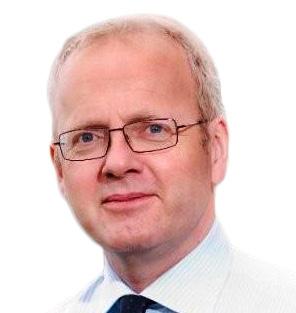
As a Senior Consultant, he is responsible for overseeing the large-scale application of renew able power in ports and industrial sites across the globe – a position that requires a variety of skillsets, from conceptual design to testing and commissioning.
This work will ultimately lead to the replacement of oil, diesel, and natural gas as the primary energy carriers in these environments – helping society to achieve its goal of powering sites with renewable energy alone.
Working for a company with an engineering heritage that spans more than 140 years and with a dedicated Green Ports team, Alex takes a long view of the possibilities and limitations of the technologies available today. He’s always happy to discuss new and creative ways to over come common obstacles, and the challenges involved in bringing the renewable energy vision to life.
ALEX RUIJS
Senior Consultant, Electrical Power & Energy, Royal Haskoning DHV
Traditionally fuel oil, diesel and electricity from conventional sources (natural gas and coal) are the most relevant energy carriers for mobile port equipment, ships and many other port-based industries and services.
Transportation and logistics of these energy carriers is an important business for most ports.

In the coming decade a rapid change in this pattern is expected. Increasing environmental awareness, legislation and cost saving are the main drivers for this development on the way to a full renewable energy operated port, with handling of renewable based energy carriers as an important new activity.
The energy transition process from conventional to renewable energy can be executed in many ways and there is not a one-fits-all best solution for general application in every port. Making a port green requires an integral view on energy use, energy storage and renewable power generation.
This abstract will show various options for port greening from the consulting engineers’ point of view and will include items such as: 5 Electrification: Land and seaside; 5 Integration of large-scale renewable generation: Within and outside the port; 5 Use of hydrogen and hydrogen-based to replace fossil fuels; 5 The economic aspects of the transition to renewable energy, especially related to the current situation in the energy market.

Apart from making the port itself greener there is also the aspect of changing cargo flows through the port, related to the energy transition. The following items are relevant:
5 Role of hydrogen and hydrogen-based fuels in the energy transition; 5 Reduced cargo flows of conventional energy carriers such as coal and oil (-products); 5 New services and cargo types related to the energy transition.
The Energy Transition from conventional energy (in most cases fossil fuel based) to renewable energy is a process that is ongoing worldwide.
The most important drivers for the Energy Transition are: 5 Climate change; 5 Increasing social and environmental impact of the production and use of fossil fuels; 5 Availability of conventional energy sources related to the political situation; 5 Increasing costs of energy from fossil fuels.
Theoretically the Energy Transition is an easy process: The daily quantity of energy that the earth receives via solar radiation is more than a thousand times the worlds’ total energy consumption.
There are 3 main challenges that in practice slow down the transition process:
1. Investment costs: The initial investment in renewable energy generation systems is high but during the exploitation period the operational costs are significantly lower compared to conventional energy, mainly because there are no fuel costs;
2. Spatial impact: Renewable power systems require large surfaces and can cause inconvenience to people living close by;
3. Energy storage and transportation: Renewable energy is generated at the moment and at the spot where the energy source (wind, sun) is available and that does not always match with the demand. Therefore technologies for energy storage and/or long distance transportation are required.
Despite these issues the worldwide development of renewable power generation systems is rapidly increasing. It is expected that in the near future better and more cost-effective energy storage systems will become available. This will not only stimulate the use of renewable energy locally, but it can also result in generation and use of renewable energy at different places. Once storage and transportation of renewable energy is economically feasible, generation can be facilitated at locations with high availability of sunshine and / or high average wind speed. The graph in Fig. 3 shows the development of renewable power generation in The Netherlands, where appr. 20% of the used electricity is generated from renewables.

Port operations require heavy equipment for the (un-)loading of goods from ships and for internal transportation within the port boundaries. Mobile port equipment is in most cases diesel powered because this used to be the only method to provide sufficient power to mobile equipment.
Due to technological developments and economies of scale, alternatives are becoming more and more available. Most feasible alternatives are:
5 Battery electrification
5 Hydrogen
5 Liquid renewable energy carriers such as methanol (from CO2 and green hydrogen)
Battery electrification systems are available as standard products more and more, which is a consequence of the electrification trend in transportation (cars and trucks). Use of hydrogen or hydrogen-based energy carriers is not yet common practice and this is mainly caused by the high costs and low total efficiency of these systems. Future technological developments might change this and can have a huge impact on the way renewable energy is used for mobile applications.
For battery electrification a choice needs to be made on how and where the batteries will be charged. There are 3 options:
1. Normal charging (From 20-80% in appr. 4-8 hours): Use longer idle periods of the equipment to recharge the batteries, for example overnight. This charging method is good for the battery-lifetime, and it requires relatively small chargers and grid power capacity. When the required charging time (1-2 hours minimum) is acceptable this is the most economical solution.
2. Fast charging (From 20-80% in less than ? hour): Fast charging requires more specific charging equipment (DC charging) and it reduces the lifetime of batteries. The main advantage is reduced idle time. Charging can with this method be done for example during a coffee break.
3. Exchangeable batteries: When batteries can be easily exchanged it is possible to charge them at a central position and at a suitable moment. This system allows to use cheap power (in case of flexible tariffs), the charging power can be limited (long charging time is acceptable) and charging can be done in optimal (temperature) conditions. Disadvantages are the requirement for additional batteries (1 charging, 1 operational for each piece of equipment) and the provisions required to exchange the heavy batteries in a short time period.
For port equipment on a fixed position or with limited movement the use of electricity as energy carrier is common practice. The main challenge to run this type of equipment on renewable energy is the mismatch between actual generation and consumption of energy. This mismatch can only be covered by energy storage systems which are not yet common practice for this type of equipment.


In some cases, the local grid operator allows to deduct renewable generated energy from the consumed energy. This is very cost effective for the client but on a larger scale less attractive for the grid operator.
In those cases where the grid operator does not allow to deduct renewable generated energy, a battery storage system can be a solution to balance generation and demand. Battery storage systems are costly, voluminous and their lifetime is limited.
The expectation that the energy transition process is growing rapidly in the coming years will have its impact on port business. Examples of energy transition related business are:
5 Windfarm construction and maintenance services: For a significant increase in renewable energy production windfarms at sea are inevitable for many countries such as The Netherlands. Soon it is likely that there will be daily transports of 1 or more wind turbine(s) from the land towards the installation position at sea. Maintenance will be executed at tens of turbines every day. And finally: With a number of years also the first wind turbines will need replacement. All these activities at sea, combined with the extensive electrical installation works require a huge capacity of ports that can facilitate these works. It is not only the seaside: Also the land side of the port must be suitable for transportation and storage of the heavy wind turbine components.
5 Transportation of renewable hydrogen: Hydrogen produced in places in the world where renewable energy is available in excess. Hydrogen transportation is complicated due to the extremely low temperature required in combination with the explosion risk. Therefore, it will be challenging for ports to facilitate the large-scale import of hydrogen. The development of the application of hydrogen-based energy carriers such as methanol or ammonia is still uncertain. If one or more of these will grow rapidly this will have a large effect on ports too, because it will require a completely new infrastructure of (un-)loading systems, pipelines and storage tanks.

Besides port equipment, ships themselves will in the future also become consumers of renewable energy. Power supply to ships during their stay in the port can be used to meet the power demand, so that the on-board diesel generator(s) can be switched off. This is the principle of shore power installations that are currently being rolled out over ports worldwide. Once shore power is in place the power supply potential of such a system can also be used for other applications, for example for charging on-board battery packages that can be used for short sailing distances or for at least entering and leaving the port emission free.
For short distance sailing barges and ferries the trend towards electrification is clearly visible. This will have an impact on the utilisation and on the capacity requirements for shore power systems and should therefore be taken into account for new shore power developments.
In those cases where battery-electric propulsion is not an option, the use of clean fuels such as methanol could be an alternative for fossil fuels. This will also require an additional fuel logistic system to produce the fuel and distribute it to the ships that can use it.
Recent developments on the worldwide energy marked have shown that the cost prices for conventional energy can be very volatile. One of the major advantages of renewable energy is that this type of power generation results in a long-term fixed energy price. The investment
is done in the construction phase of a project and the costs (Maintenance and depreciation) are quite exactly known. Cost prices of renewable energy from wind and solar depend on local circumstances (sun intensity, average wind speed), project scale, availability of free space and conditions such as temperature, air pollution. However, once the location of a renewable energy project is known the revenues and therewith the cost price per MWh can be calculated very accurate over the expected lifetime of the project (15-25 years).
In many cases the cost price of a MWh from a renewable source is less than 100 USD. This price level, especially when it is fixed for 20 years or more, makes renewable energy very competitive with conventional energy sources.
In the near future it can be expected that the total costs of energy from conventional sources will rather rise than fall. Charges for CO2 emission will increase the cost price of conventional energy and shortage on the world market for energy might even increase the price further.
Developing a Green Port strategy is a process that does not stand on its own. The energy transition is an integral process in which ports play a crucial role. The port is an energy consumer, it is the place where energy intensive industries are based, and the port is the gateway for energy carriers to be distributed into the hinterland. Making a port greener requires therefore an integral view on all processes that take place in the port, related to energy. Only when all aspects are considered optimal solutions can be developed.
The following aspects should be considered as part of the development of a Green Port strategy: 5 Energy consumption of the port itself (Energy carriers and quantities) – Increase energy efficiency and move to cleaner energy carriers; 5 Energy delivered to ships (Propulsion and consumption while in the port) – Facilitate shore power use and replace conventional fuels by clean energy; 5 Transportation and logistics of conventional energy carriers (Coal, oil, LNG) –Volumes might decrease following the ongoing energy transition; 5 Potential for transportation and handling of new, renewables-based energy carriers; 5 Options for renewable energy production within the port; 5 New business for the port related to renewable energy production (Wind farms at sea); 5 New or upgraded renewable energy distribution networks within the port and to the hinterland.
Implementation of the Green Port strategy and optimising the economic performance of the port are actions that show more and more synergy, which is enhanced by the rising energy prices .
A port that is the home base of several chemical industries can produce hydrogen from excess power of windfarms (at sea or within the port boundaries). In future hydrogen will also be imported from locations with an excess of renewable energy. The hydrogen produced and imported can be used as raw material for the chemical industries, but it can also be applied as energy carrier for mobile applications. The port becomes a hydrogen hub and to make this work it is required that there is a distribution network in place and sufficient unloading and storage capacity.

Providing shore power to ships is a proven technology to reduce ships’ emissions in the port. It is not always effective: If the power is generated from fossil fuels, especially if that is done in an inefficient way, causing much pollution, it seems to be contra-productive. Combining shore power with renewable power generation can be a very effective way to make shore power much more attractive. Power costs go down and the energy delivered to the ship is completely emission free. Of course this requires cooperation with the grid operator who must be willing to accept power feedback into his grid and supply at moments of renewable shortage.

LNG terminals require significant quantities of thermal energy for the regassification of LNG into gas. When thermal energy is not available locally it can be required to burn gas to produce heat for regassification. Waste heat of a conventional power plant which cannot be used any more is an ideal energy source for the regassification process. When the distance between the power plant and the terminal is not too far this can be a very energy and cost efficient combination.




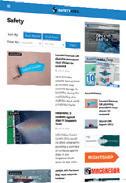
Jackie is an experienced Environmental, Social, Governance (ESG) professional with a history of working in the maritime and infrastructure sector bringing a wealth of knowledge on sustainable development and operations.
With over 15 years’ experience in environment, planning and sustainability management, Jackie is now focused on strategy development and business transformation. With a gift for creating collaborative partnerships, alongside a strong ability to recognise and cultivate the potential in others, Jackie has a proven track record of accelerating organisational sustainability through strategy implementation , communication, and education. During her career Jackie has been responsible for the development of a number of Sustainability Financing Frameworks enabling over $750million of sustainability linked debt to be realised through a series of innovative sustainability financing transactions.
In 2022, Jackie became the founder and Managing Director of boutique ESG advisory company Sustainable ESG (SESG). SESG are focused on supporting organisations navigate the evolving ESG imperative. Helping organisations to understand their current state and develop relevant and tailored strategies that build upon existing foundations.

Jackie sits on the Board for PIANC ANZ, a global not-for-profit body that brings together experts on technical, economic, environmental and planning issues pertaining to waterborne transport and infrastructure and is a former Chair of the Ports Australia Environment Planning and Sustainability Working Group. Jackie also sits on the Mayor of Newcastle’s Sustainable Development Collaborative, an active group focused on localising the United Nations SDGs to the region.
Jackie was responsible for introducing EcoPort to the Oceania region and since 2018 Jackie has advocated for ports to participate in the program with nine ports now part of the network. In her capacity as Managing Director of SESG, Jackie has recently signed an MOU and Statement of Intent with EcoPorts EcoSLC to formally collaborate and further extend the network of participating Ports and Terminals in Oceania.
A cheerleader for change, Ali Nicholl is a founding member, and Head of Engagement, at IOTICS. Ali’s passion is driving the adoption of digital twins and cooperative ecosystems. He is empowering others to act now to transform siloes into a web of sources in boundless data ecosystems by advocating for the need for interoperability across boundaries. With an eclectic background in tech, comms, design, consultancy, and very briefly animal husbandry, Ali brings his unique viewpoint and creative cooperation approach to multiple STEM activities, industry working groups, boards, and councils.

From the development of a cooperative digital ecosystem at Portsmouth International Port we’ll show an approach to learning at scale, sustainability and energy transition. Exploring how to share understanding of assets, and their environment, across ecosystems securely, flexibly, at scale.
Mr. Algis Latakas was appointed as the Director General of Klaipeda State Seaport Authority in 2020. Before joining Klaipeda Port, for nearly 2 decades, he worked in the largest stevedoring company in Klaipeda - KLASCO. He was responsible for establishing and operations of port terminals and chaired LNG Terminal construction Work Group. For a number of years, Mr. Latakas was a co-owner and the general manager of maritime business consultancy company, which build and maintain trading relationship with Lithuania and East European countries. Mr. Latakas has engineering background and holds Master’s degree in Management. He has also graduated from International Maritime Academy in Italy majoring in hazardous cargo handling.

Large-scale Klaipeda Port expansion plans requires new port greening strategy, therefore, digitalisation as a main pillar to controls and implement port greening was launched. Most important technologies: GeoSpatial E-Map with full coverage of environmental control, remote pilotage and underwater drones
As innovation ‘enablement’ manager for the Port Authority, Piet is one of the drivers of the digital and innovation transition in the Port of Antwerp-Bruges. Based on a founded strategy with a pragmatic approach in executing concrete innovation projects, he makes the ‘Port of the Future’ tangible and leads the development of Port of Antwerp-Bruges as open innovation platform (e.g. on smart shipping, drones, sustainable energy) - on which startups, companies, knowledge institutions and other authorities create new value for the Antwerp and Bruges port ecosystem. As a community builder Piet is board member of The Beacon (AI & IOT community) and champion of the Plug&Play maritime innovation platform.
In the 90’s, Piet started at one of the most successful startups in the Benelux – Tele Atlas, a producer of digital geographic data – acquired by TomTom in 2008. Between 2011 and 2014 he managed a consultancy firm and was closely involved in start-ups in the energy sector. Piet holds 2 masters, in History and Spatial and Urban Planning, post-graduates in energy and environmental management and an MBA International management.

With an academic background in university lecturing and research, Chris is also qualified as a trainer in Environmental Management Systems and has delivered academic modules and industrial training courses on Port Environmental Management in all the maritime states of Europe, as well as in Colombia, Taiwan, Ivory Coast, Vietnam, Thailand, Laos, Cambodia, India, Malaysia, USA, and Kuwait. He was Director of Studies, Marine Geography in the School of Earth and Ocean Sciences, Cardiff University, UK until 2011.
His experience in the maritime sector includes applied research in close collaboration with the port sector and associated marine industries for 40 years. He served for six years as visiting lecturer at the World Maritime University, Malmö.
While at Cardiff University he was one of the original researchers who, along port sector colleagues, other academics and his research students, was involved in the development of the EcoPorts tools and its associated International Quality Standard of Environmental Management System, EcoPorts PERS.
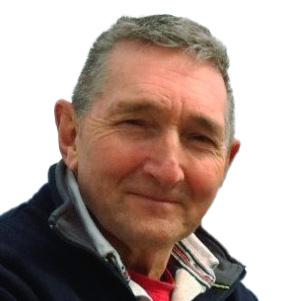
CHRISTOPHER WOOLDRIDGE Science Coordinator EcoPorts EcoSLC, and Visiting Research Fellow, Cardiff University, UK
Jason is the Owner & Director of Sprott Planning & Environment – an Australian based port environmental planning consultancy with clients in both the private and public sectors. Jason’s port industry experience spans two decades - including 10 years at the Port of Brisbane as the Manager of Strategy & Planning.
For the last 11 years he has operated his private practice specialising in port planning, environmental management, major project approvals, sustainability, and corporate advisory with clients across Australia and New Zealand.

He has co-authored National Port Planning, Supply Chain Protection and Sustainability Strategy Guidelines.
Jason is a ‘Sir Winston Churchill Fellow’ and has travelled and spoken internationally across Asia, Europe, the USA, Canada and New Zealand.
He holds degrees in Urban Planning and Science and during COVID completed a Sustainability Executive Education Course through the University of Cambridge.

Dr Antonis Michail is an engineer in background with specialisation on the environmental management of ports and freight transport systems at Master and PhD level, and with more than 15 years of professional experience in these fields. Since February 2018, Antonis joined the World Ports Sustainability Program (WPSP) of the International Association of Ports and Harbours (IAPH) as the person responsible for the technical developments and projects under the umbrella of the program. Before that, Antonis was holding the position of Senior Policy Advisor on sustainability and safety matters at the European Sea Ports Organisation (ESPO) from 2009 to 2017. Since back in 2003, Antonis was involved in the EcoPorts network of ports from various posts, including managing projects and coordinating the network’s activities and development until 2017.

Head of Planning and Environment, Port of Oslo
Neilson holds a master degree in Geography, and a bachelor degree in Environmental Management. The mix of natural and social sciences is useful since the port’s environmental impact as well as the influence on city development is important in the Oslo Fjord City of Norway.

Herman Journée initiated in 1996 in Europe the development of the Ecoports Port Environmental Management System, a professional quality management system and standard and the EcoPorts Network for cooperation and sharing good environmental practice. More than 130 European Ports contributed to its realisation. In 2010 he started, the independent non-profit ECOSLC Foundation to introduce Ecoports outside Europe and to introduce sustainable port, transport and logistics chain management. The Foundation is internationally recognized.



Conference Producer, Conferences
Tel: +44 1329 825335 Email: jgilchriest@mercatormedia.com
Media Sales Manager
Tel: +44 1329 825335 Email: mcharlesbailey@mercatormedia.com
Port Strategy Sales Executive Tel: +44 1329 825335 Email: JMiller@mercatormedia.com
Anne-Marie Causer News Editor
Tel +44 1329 825335 Email: ACauser@mercatormedia.com
Tel: +44 1329 825335 Email: mrasmussen@mercatormedia.com
Andrew Webster Chief Executive OfficerMercator Media Limited
Spinnaker House, Waterside Gardens, Fareham, Hampshire, PO16 8SD, UK t: +44 1329 825335, f: +44 1329 550192 www.mercatormedia.com
The organisers
this

22 24 November 2022, Le Méridien, Hamburg, Germany
The Propulsion & Future Fuels Conference will be returning to Hamburg to explore the latest emissions cutting technology and shipping propulsion innovation in association with The Motorship propulsionconference.com

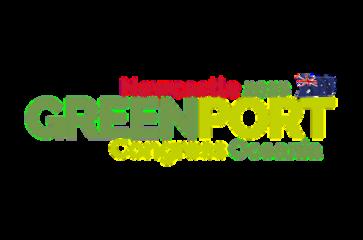
15 17 February 2022, Newcastle, Australia
The Greenport Oceania offers the latest in sustainable development and environmental practices within the ports environment portstrategy.com/greenport-congress-oceania
3 4 May 2023, Royal Liver Building, Liverpool, UK
Coastlink is a pan European network dedicated to the development of a competitive supply chain and promotion of short sea and feeder container shipping coastlink.co.uk



13 15 June 2023, Mayflower Park, Southampton, UK Europe’s leading annual three day commercial marine exhibition and conference. Seawork incorporates Marine Civils Europe's leading event dedicated to showcasing the latest equipment and solutions for marine, coastal and other challenging civil engineering projects Attend in person and virtual seawork.com

13 15 June 2023, Mayflower Park, Southampton, UK
Get set for Workboat 2050', a hybrid conference with expert panellists discussing decarbonisation compliance, aspects of vessel operations and safety in the workboat industry The conference venue also hosts free to attend business briefings, including sessions with the MOD & DIT seawork.com/our conferences
14 15 June 2023, Mayflower Park, Southampton, UK
The Seawork Conference is a must for all involved in the commercial marine industry who wish to explore the challenges, changes and emerging opportunities in today’s and tomorrow’s commercial marine and workboat sector. seawork.com/cmc
18 20 October 2023 Location in Southern Europe to be confirmed
The yearly congress provides environmental departments in Ports and Terminals with methods of greening their operations. portstrategy.com/greenport-cruise-and-congress
Mercator


Spinnaker House,
Fareham, Hampshire,






